

The Ultimate Mongolia Travel Guide 2024
From the best time of year to visit to how to get a SIM card and where to register with immigration , these are the important things to know as you plan your trip to Mongolia.
- April 9, 2020
- Updated: January 24, 2024
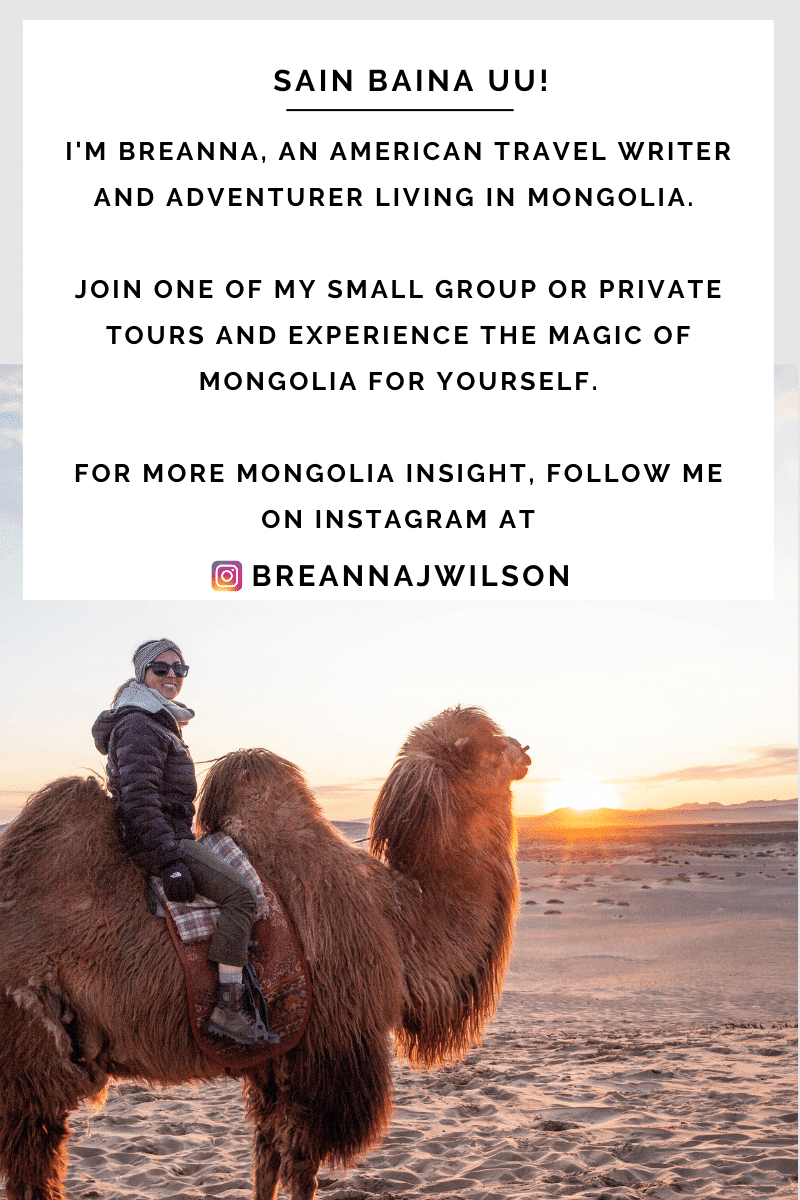
What do Mongolians Eat? 8 Lesser Known Mongolian Dishes to Try
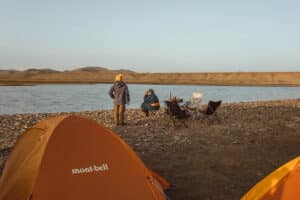
18 Tips for Camping in Mongolia

How to Safely Visit Ulaanbaatar’s Black Market
Table of contents.
When I say I love living in Mongolia, I mean it with every part of my heart and soul. It was after coming here in 2018 as a tourist to join a Mongolia tour and experience the local culture that I remember thinking, this place can’t be real.
It turned out to be the best way to experience Mongolia I could have asked for. That short trip made me realize the Mongolian steppe is one of the last truly untouched places in the world for nature lovers and true adventure seekers.
Nomadic families really did still live of the land, and their herds, the same way they have for thousands of years. Talk about sustainable.
In fact, 25% of the Mongolian population still lives this way. That’s a huge percentage in a country of just over 3.2 million.
However, it wasn’t just the Mongolian countryside that I fell in love with. After coming back and living a summer in Ulaanbaatar (also written as Ulan Bator), Mongolia’s capital city, I knew this was the country, and the place for me.
It’s by no means easy living here. This is not the United States, where everything runs smoothly. Language barriers are a thing, credit cards always have issues (especially Mastercard), and you really need to get used to Mongolian time. Whether you want to or not.
In the end, I’ve learned it’s better not to resist this style of living and just go with the flow. It’s probably the only reason I’ve made it this long here. Living here has taught me a lot about patience, compassion, and myself. Things living in Los Angeles, New York, and growing up in Pittsburgh couldn’t do in 32 years.
Because, when it comes down to it, Mongolia is a tough place to be as a foreigner among the local people. When I moved here, there was no information on how to navigate the the city, let alone rural Mongolia. I’m talking, nothing! I had to become my own local guide.
Not just for people crazy enough to move here like me, but for travelers, too. The type of people willing to travel more than 24 hours to a place where they usually have no idea about the chaos they are about to encounter. The kind of people who book a tour but the tour company could be real and you could have the adventure of the lifetime, or it could be a complete scam. The people who just go for it with fearlessness without ever looking back. Those are my people. You are my people.
So, I hope this Mongolia travel guide, along with the other guides on this Mongolia travel blog give you the insight and information that wasn’t available to me when I first came here. That these articles will help you navigate Ulaanbaatar like a local and Mongolia like a travel pro.
As always, if you need help planning an itinerary or have more specific travel questions, you can always book a 30-minute travel consultation with me. There’s nothing I love more than talking about Mongolia and getting people excited about visiting.
When is the Best Time of Year to Visit Mongolia?
Summer is the best time of year to visit Mongolia and is considered peak season. June, July, and August are beautiful months with a great deal of things to see and experience. This is when most tourists visit Mongolia, so you can expect peak rates, sometimes crowded natural landmarks and museums, and full flights.
The average summer temperature in Mongolia is between 25° and 32° C, with cold nights. You can comfortably wear t-shirts during the day and a light jacket when it gets dark. Dust storms are common in the summer season, especially when you’re on the wide-open plains.
Keep in mind that if you visit areas in the north or west, at higher elevations, temperatures will be lower than this. If you visit places in the south, particularly the Gobi Desert, temperatures will be much higher. Temperatures in the Gobi Desert average 40° C, and higher, in June, July, and August.
If you plan to visit Mongolia in the summer, especially in July, book your tours, hotels, and flights no later than March. July is the busiest month for tourism in Mongolia thanks to the Naadam festival. Hotel rates in Ulaanbaatar are even known to double in price between July 10 and 12, when the Opening Ceremony takes place in the city.
Naadam is the biggest and most important festival of the year and visiting Mongolia during Naadam gives you the best of Mongolia, and Mongolian culture, in just a few short days. The festival always takes place in July, with the National Opening Ceremony always being held in Ulaanbaatar on July 11. Thus, the high hotel rates in the city.
It’s during Naadam when you can watch wrestling, horse racing, and archery competitions big and small across the country.
Here are some other great things to see and experience when visiting Mongolia in June, July, and August:
- Annual Naadam Festival
- PlayTime Music Festival
- Spirit of Gobi Music Festival
- Tenger World Shaman Festival
- Mongol Derby
- Monkey Run Mongolia
- Free Daily Cultural Shows in Ulaanbaatar
- Polo Matches at the Genghis Khan Retreat and Polo Club

What to Expect When You Visit Mongolia in Fall, Winter, or Spring
While summer is the most popular, and best time to visit Mongolia for many reasons, fall, winter, and spring shouldn’t be immediately ruled out. Here are a few reasons why.
Personally, fall is my favorite time to be in Mongolia .
Tourism starts to die down at the end of August as school starts and the weather starts to get a bit chillier and days shorter. This is the time when most nomadic families begin to prepare for the cold winter months ahead, which makes it an especially interesting time to visit. You can help families move to their winter camps, either by truck, camel, or yak, and help tear down and build their gers (homes) with them. It’s a special time to bond with families and feel like you’re being useful. The worst is when you go somewhere and feel like they’re just putting on a “show” for tourism reasons. This isn’t that. I can promise.
September is also the time when the landscape turns a beautiful golden hue. Trees turn bright shades of yellow, orange, and red, and snow starts to cover the mountain tops.
Because of all these things, traditional ger camps begin closing up for the season at this time. This is usually to traveler’s benefits because it means you can find great deals on nightly rates before they do.
Then, when October hits, it’s time for the famous Golden Eagle Festival .
The festival is extremely popular with tourists, so be sure to make your arrangements if you want to attend as far in advance as possible. I would recommend making your arrangements before June. Especially since securing flights from Ulaanbaatar to Ulgii can be tricky and confusing. For this I also recommend hiring a local tour company to make all your arrangements.
The annual Golden Eagle Festival is always held the first weekend in October .
Here are some other great things to see and experience when visiting Mongolia in September, October, and November:
- Sagsai Eagle Festival
- Golden Eagle Festival
- Ulaanbaatar Jazz Week
Don’t let the idea winter in Mongolia intimidate you. Yes, temperatures do reach -30° C. And yes, Ulaanbaatar is officially the coldest capital city in the world . But it’s because of these things Ulaanbaatar, and Mongolia, are something special to see and experience during December, January, and February.
While temperatures do drop to around -30° C, you can still do things like visit and spend the night in a yurt with a nomadic family out in Gorkhi-Terelj National Park. Out there, you can go horseback riding on Mongolia’s famously wild horses, and even dog sledding through the winter wonderland that has become the snow-covered countryside.
Or, better yet, head down to the Gobi Desert, one of the only deserts in the world where snow can lay across the dunes covering them in a sea of white. This is the perfect time to experience the natural beauty of the Mongolian desert, but with fewer crowds.
Alternatively, Tsagaan Sar , or Mongolian Lunar New Year, happens in February and is a unique way to experience a Mongolia relatively free of other tourists.
The holiday marks the first day of spring and a time when Mongolians take the time to visit each of the elders in their family, bringing gifts and sharing a meal. This is a special time for Mongolians to celebrate with family and look forward to new beginnings.
Here are some other great things to see and experience when visiting Mongolia in December, January, and February:
- Ulaanbaatar’s Christmas Markets
- New Year’s Eve Celebrations
- Tsagaan Sar (Lunar New Year)
- See the Gobi Desert Covered in Snow
- Dog sledding on Lake Khusvgul
- Ice Fishing
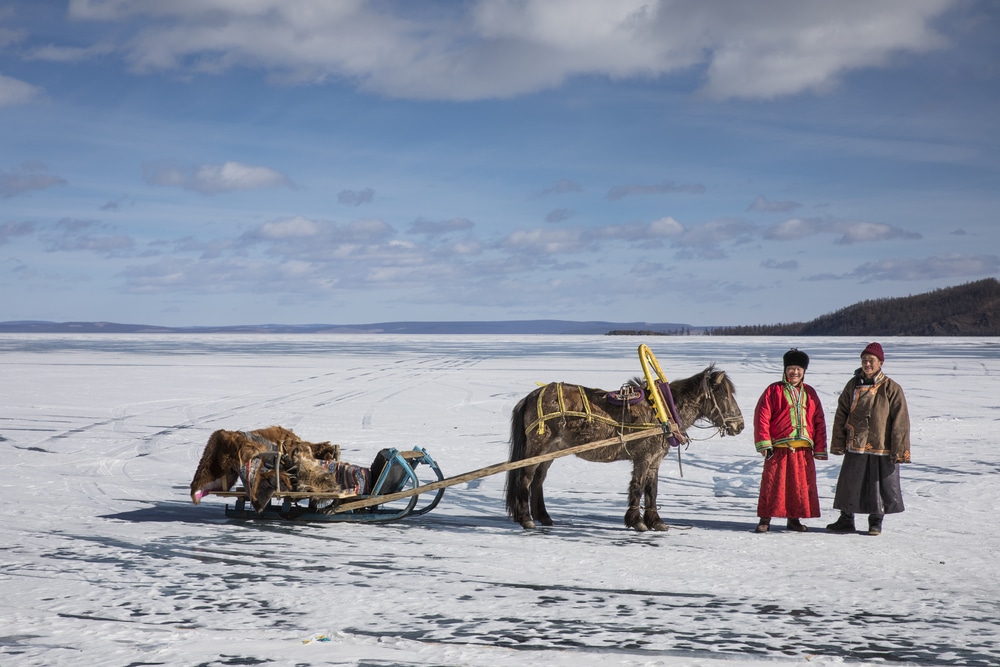
While most people think of spring as a time when temperatures start to warm up, flowers begin to bloom, and life returns to nature, spring in Mongolia isn’t quite that. In fact, spring is still uncomfortably cold and you should probably just think of spring in Mongolia as winter-lite.
Blizzards can still occur in May, which locals refer to as dzud (or zud, a natural phenomenon that kills off a large portion of herds from starvation since they aren’t able to graze), and it’s still a harsh time in the country as locals start to run out of winter rations and look forward to warmer summer months.
However, as is usually the case in Mongolia, the brave are rewarded with two very cool festivals that make a trip to Mongolia in the spring worth it.
The annual Camel Festival is held each March in the Gobi Desert.
During the festival, there are camel polo matches, camel races, and friendly competitions among the local camel breeders. Mongolia is one of the few places in the world where you find Bactrian (two-hump) camels, and the Gobi Desert one of the only deserts in the world where snow accumulates. Making a trip down to the desert during this time is actually quite a magical experience.
Also in March, the annual Ice Festival is held on Lake Khuvsgul, the world’s second-largest freshwater lake. The lake is completely frozen over and is strong enough to drive cars over and host an entire festival on.
And yes, this region bordering Siberia will be every bit as cold as you’d expect it would be, so don’t come unprepared. A fur-lined winter deel (traditional Mongolian robe) probably wouldn’t be a bad investment. You can have one custom-made in Ulaanbaatar as soon as you land.
Here are some other great things to see and experience when visiting Mongolia in March, April, and May:
- Camel Festival
- Ice Festival
- Ulaanbaatar Eagle Festival
Finding a Cheap Flight to Mongolia
Check the cheapest rates to Ulaanbaatar on CheapOair.com below.
The best direct flights to Mongolia are on the following airlines:
- Mongolian National Airline (MIAT)
- Turkish Airlines
If you’re traveling from the U.S., your two best options are via Istanbul on Turkish Airlines or via Seoul on Korean Air. I usually recommend traveling via Istanbul if you’re departing from the east coast and via Seoul if you’re departing from the west coast.
Turkish Airlines is my personal preference and I’ve never had an issue with them. I particularly like Turkish Airlines right now because they have a layover program that includes a free 4-star hotel in Istanbul . Besides helping break up your jetlag, it’s also an excuse to cross another country off your list. Two birds, one stone!
From Europe, flying via Frankfurt on MIAT, Mongolia’s national airline, is another good option. As an airline, MIAT is safe, but they don’t always have the best track record for being on time, having a smooth check-in process, and cancellations do happen with them more often than other airlines. I have flown MIAT, but they usually aren’t my first choice.
Internal domestic flights can be booked through MIAT, Aero Mongolia, or Hunnu Air. Domestic roundtrip flights are not cheap, usually costing at least a few hundred U.S. dollars. It’s also extremely confusing to book these flights on your own, especially without a local Mongolian bank account. If you plan to book a domestic flight in Mongolia, I recommend getting a local tour guide or agency to help you through the process.
Once you land in Ulaanbaatar at Chinggis Khaan International Airport, here are the best ways to get from the airport into the city center .
Taking the Trans-Siberian Railway
Taking the Trans-Siberian Railway from Moscow to Beijing is one of the most iconic train journeys in the world. It’s high on my list of things to do, and I’m hoping to do it sooner rather than later.
Conveniently, the Trans-Siberian Railway stops in Ulaanbaatar, giving travelers an excuse to explore the city and surrounding countryside for a few days. The train station is located in the heart of Ulaanbaatar and most hostels and guesthouses offer free transfers from the train station.
Tips for Taking Taxis, Public Transportation, and Hiring a Driving
When it comes to hailing a taxi, finding the bus schedule, or hiring a private driver, there are a few things to know. Use these travel tips for getting around Mongolia cost-efficiently and with less hassle than if you were to have to figure it out on your own.
Finding a Taxi in Ulaanbaatar
You can hail a taxi in Ulaanbaatar simply putting out your hand to your side, signaling you’re looking for a ride.
These are not official taxis, but they are the most common way to get around the city. It’s how I get around almost every day. It’s safe and reliable, but you do need to explain where you’re going. I usually tell the driver a major landmark that’s close enough to where I’m going or I show them on Google Maps. On occasion, the driver will ask for your destination before allowing you in their car, just in case they aren’t going that way. Both male and female drivers stop and do this, sometimes with kids and other family members in the car. It’s all normal here.
When it comes time to pay your driver, expect to pay 1,500 MNT per kilometer . It’s helpful to have small bills and exact change, most drivers don’t carry cash.
If the thought of getting into a strange Mongolian’s car freaks you out, apps like UBCab are the Mongolian equivalent of Uber, which don’t exist in Mongolia. You’ll need a local Mongolian number to register within the app and begin requesting rides. The app is okay from a user perspective and the driver usually calls when they’re on their way to your pickup location.
You’ll still need cash if using UBCab, the app doesn’t accept credit cards. At the end of the ride you’ll see your total in the app, which also helps you get a gauge on the average taxi price to get around the city.
Scooters and Bikes
Ulaanbaatar is now home to both scooter and bike sharing apps.
Jet scooters are hard to miss scattered around town. To use one, download the Jet app ( Apple , Android ), scan the scooter’s QR code, and then pay by the minute. You can use the app to find a nearby scooter and while they are a convenient way to beat rush hour traffic, Ulaanbaatar’s sidewalks and drivers don’t make it the safest option. Ride with caution!
Hi Sainuu ( Apple , Android ) is the bikesharing app that’s taken over the city. It works much the same way as Jet and, again, should be used with caution.
Public Transportation in Ulaanbaatar
Buses within Ulaanbaatar are often crowded, especially around rush hour thanks to a lack of routes and other public transportation options. Ulaanbaatar does not have a subway system.
Cash is not accepted once you step on the bus so you’ll need a refillable U Money Smart Card (3,600 MNT to purchase) to take the bus. The price per ride is 500 MNT. You can purchase and refill a U Money Smart Card at bus kiosks around town or inside CU convenience stores. Note that routes and bus numbers will appear in Cyrillic.
You can find information on bus stops, waiting time, routes, and U Money kiosks on the UB Smart Bus app ( Apple , Android ).
Additionally, it’s possible to take buses from Ulaanbaatar to different cities throughout the country. Bus tickets and schedules are found at the Dragon Center Bus Station, on the outskirts of Ulaanbaatar. You can now purchase bus tickets to destinations outside of Ulaanbaatar online , but be warned the system doesn’t always work as promised. I recommend going to the bus station a day before you plan to depart Ulaanbaatar to get the most up-to-date schedule and purchase your ticket in-person then.
A bus ride to Moron, for example, will be relatively inexpensive, costing 32,000 MNT for the 14-hour ride.
Renting a Car in Ulaanbaatar
Renting a car in Mongolia these days isn’t as cheap as it used to be. In fact, it’s downright expensive. With only two major rental companies to choose from, Avis and Sixt, there’s a monopoly on the car rental market. When you rent from either company, expect to pay a deposit on the rental around $2,000 USD, not including any of your rental costs, which will also need paid up front. If there’s no damage done to the car, you’ll get the deposit money back after returning the rental at the end of your trip.
One hack to that is renting a car through a company like Follow the Tracks . The company offers self-driving tours of Mongolia and these cars are equipped with rooftop tents and they even give you a route to follow.
Another reason I really like Follow the Tracks is because it can be very difficult to navigate Mongolia on your own. Once you leave the city the roads conditions start to worsen, and fast.
Unless you’re a driver who’s really comfortable driving off-roading, and in extreme conditions, I don’t recommend renting a car in Mongolia.
Instead, hire a driver.
Hiring a Driver in Mongolia
There are a few benefits to hiring a driver in Mongolia.
First, like I mentioned above, unless you are really comfortable driving off-road, driving in Mongolia is not easy.
Second, you can’t beat the cost. The cost per day to hire a driver with a car in Mongolia is currently 200,000 MNT per day. You are responsible for the driver’s meals, making sure they have a place to sleep, and you’ll pay for your own gas along the way. Your gas costs will depend on your route, and the type of car you’re in, but expect to fill up at least three to four times during your trip at 300,000 to 400,000 MNT per tank.
Your driver will need to be paid in cash at the end of your trip. Gas can usually be paid for by credit card at gas stations like Petrovis, but you should also carry emergency cash on you for at least two tanks of gas, just in case.
I recommend hiring a driver with either a Toyota Land Cruiser 200, Toyota Delica, or Russian UAZ furgon. These will be the most reliable cars that will get you across the steppe. UAZ furgons are the least comfortable of the three options, and usually also the cheapest.
Drivers are always flexible, easy going, and ready to fix their own car when something goes wrong. Something I can almost guarantee will happen. Usually drivers don’t speak English, but you’ll quickly learn the key words you need to get through your journey. Never underestimate the power of sign language and Google Translate. Take the time to get to know your driver, they’re funny characters that start to become like family in no time.
Popular Mongolia Guides:
- 11 Traditional Mongolian Foods To Know
- Gift Ideas for Visiting a Nomadic Family
- Best Books About Mongolia
- What to Budget and Travel Costs (2023)
- How to Get From Ulaanbaatar Airport to the City Center
Itinerary Ideas & Packing Lists:
- Chinggis Khaan Equestrian Statue & Gorkhi-Terelj National Park Day Trip
- How to Attend Naadam, Mongolia’s Biggest National Festival
- Mongolia Packing List: The Essentials
Plugs and Voltage
Sockets in Mongolia work with both U.S. (type B plugs with two flat prongs and a grounding pin) and European plugs (type C plugs with two round pins). Each socket has one type of each plug.
So, if you’re coming from the U.S., your device will work in most wall sockets in Mongolia. However, it is important to note that there will be a voltage difference. In Mongolia the sockets are 230 volts, compared to the typical 120 volt sockets we use in the U.S.
Most computer chargers, phone chargers, and other electronics have power converters built into the device to account for these types of voltage differences.
For example, I use my U.S. computer charger without any issue. I plug it right into the socket in my apartment, in coffee shops, in hotels – everywhere – and I’ve never had an issue. The same goes with my phone charger, camera battery charger, drone charger, hair straightener, and just about any other electronic you can think of.
If you’d like to bring a wall charger that will allow you to charge via USB-A and USB-C, I recommend this travel adapter . This two pack also gives you the most charging power out of the shortest available charging time.
When packing for Mongolia, be sure to bring travel adapters, power banks, extra C charging cables, and a solar powered charger, if you have one. Electricity is not reliable or regularly available once you leave Ulaanbaatar, so you need to be prepared if you plan to travel around the country for several days. Especially if you plan to do a homestay or spend time in the more remote corners of the country.
As I mentioned above, be aware that the voltage is much higher in Mongolia than it is in the U.S. (230 V vs 120 V). If you plan to plug directly into the wall socket make sure your device has a built-in power converter, or you have a power adapter that allows for dual voltage.
Getting a SIM Card
The best place to get a physical SIM card in Ulaanbaatar is at the State Department Store on the 5th floor. There you’ll find Unitel , MobiCom , Skytel , and gmobile kiosks next to each other. Since they are all located next to each other, it’s easy to browse and compare each company’s service plans and choose the right one for your trip.
Most locals use Unitel, myself included, which offers some of the best service coverage across the country.
Getting a SIM card is quick and easy, but you will need to bring your passport with you to get one issued. You can use a credit card or cash to purchase your car and plan, which should cost less than 40,000 tugrik all together.
If you have an iPhone 15 that doesn’t have a SIM card holder , you can ask for your SIM to be converted to an eSIM . From experience, I know that Unitel offers eSIM cards .
eSIMS are also available in Mongolia and can be purchased through apps like Airalo. Purchasing an eSIM this way is more expensive ($35 USD compared to $10 USD), but it is more convenient and works just as well as using a physical SIM. If you’re short on time and won’t have time to make it to the State Department Store before leaving the city, this is a great option.
Before you purchase a SIM card of any kind, be sure to ask yourself if you really need or want one. Service in the countryside is hit and miss, so even if you purchase a SIM you may not have any data or service.
Only purchase one if it’s absolutely necessary for you to stay connected. Otherwise, enjoy being disconnected, that’s one of the best things about traveling in Mongolia.
If you do decide to purchase a SIM, the two most reliable service providers in Mongolia are MobiCom and Unitel. Tourist plans start as low as 20,000 tugrik and include international call rates, SMS messaging, and different levels of data. No service provider will be able to offer unlimited data, we just don’t have that in Mongolia yet.
Exchanging Cash in Ulaanbaatar
The local currency in Mongolia is Tugriks , also spelled togrog or used as the abbreviation MNT.
As of December 2023, one USD = about 3,455 Tugrik .
You will always need to have cash on hand in Mongolia. Even in Ulaanbaatar where credit cards are becoming more widely accepted. But, you can’t always rely on them to work. It’s especially known that there are issues with Mastercard credit cards and American Express. If you have a Visa credit card, that is your best option for using around the city.
Cash will always be needed if you hail a taxi off the street, and be sure to carry smaller bills on you at all times. Expecting exact change isn’t always possible. I recommend carrying at least ten 1,000 MNT bills, four 5,000 MNT bills, and two 10,000 MNT bills with you at all times. This is still a country where cash is king.
The easiest way to exchange USD or Euros for Tugriks is at one of the currency exchange offices off of Sambuu Street, near the Holiday Inn , where this Google Maps pin is.
There is also a cash exchange stand in the State Department Store, on the third floor, near the kitchen electronics.
ATM’s are more available than cash exchanges in the city, so you can pull out money that way as well. ATM’s typically have a withdraw limit of 500,000 MNT, 800,000 MNT at very select terminals.
Prepare to have what will seem like a large amount of cash on you and note that Mongolia does not use coins.
While most tour operators, guides and private drivers are happy to accept cash in USD or Euros, taxi drivers and local businesses will only accept MNT.
Take my advice and take care of this before you leave Ulaanbaatar for the countryside. Finding working ATMs and currency exchange counters isn’t so easy in the country’s small towns and remote areas.
Visa-Free Countries and How to Get an E-Visa
Citizens from more than 60 countries, including the U.S., Canada, Australia, New Zealand, Germany, Italy, Spain, and the United Kingdom of Great Britain and Northern Ireland can enter Mongolia without needing a visa.
U.S. citizens do not need a visa to enter Mongolia. If you are a U.S. passport holder, and you plan to stay more than 30 days, you will need to register with the immigration office within 7 days of arriving in the country. Then, you can stay up to 90 days without issue. If you fail to register with immigration, you’ll be fined a few hundred dollars at the airport when leaving the country.
Citizens of Canada, Denmark, Belgium, Germany, Iceland, Israel, Italy, France, Spain, Greece, Norway, Sweden, and Switzerland can stay visa-free for up to 30 days .
Citizens from 98 countries, including India, China, Mexico, Saudi Arabia, South Africa, and Armenia can now apply for an electronic visa before departing for Ulaanbaatar.
See the full list of visa-free countries here.
Registering with the Immigration Office
When I first started coming to Mongolia this process had to be done in person at the Immigration Office, which is nowhere near the center of town. Today the process is automated and takes only minutes to complete.
U.S. citizens who plan to stay in Mongolia for more than 30 days need to register with the Immigration Office within 48 hours of arrival.
This has nothing to do with being allowed to stay for up to 90 days visa free. This is absolutely mandatory. I can’t stress this enough. If you fail to register at the Immigration Office you will be stopped at passport control on your way out of the country and not allowed to board your flight until you pay the fine for violating this law. Even worse, you could be banned from entering the country ever again.
Luckily, you can now register with the Immigration Office online.
To register online with immigration you will need to do the following. You will need the information for the person responsible for your stay in the country, including their ID number, email, local phone number, and address . You should have this information before you begin filling out the form.
- Go to https://immigration.gov.mn/en/
- Click “Registration of a Foreign National”
- Follow the steps on the form
- Click submit and you’re all set. The form may not look like it’s been submitted, but it has.
- You won’t receive a confirmation email so I recommend taking a picture of the screen or a screenshot in case there is an issue or dispute when you go to leave the country.
Language and Religion
Mongolian is the official language spoken in Mongolia. It’s written using the Cyrillic alphabet. Although it’s becoming more common to see it written using Latin letters.
Russian and English are the second and third most spoken languages by Mongolians. However, don’t expect most people in Ulaanbaatar to speak English. Most Mongolians don’t.
It will be more likely to find English-speakers in Ulaanbaatar. Once you leave the capital, don’t expect English to be a common language to use for communicating. (You can always use my Mongolian Language Cheat Sheet for help.)
Buddhism is the main “religion” practiced in Mongolia. About 80% of the population considers themselves Buddhist.
Mongolians also believe in respecting the earth and its inhabitants above all else. This is called Tengerism and it was primary religion in Mongolia centuries ago. Today Tengerism and Shamanism still play an important role in the core beliefs of most Mongolians, but they’ll still call themselves Buddhists.
While most of the country’s monasteries were destroyed during Soviet times, a handful can still be found across the country and are worth taking the time to seek out and visit.
Eating and Drinking in Mongolia
There are many amazing traditional Mongolian dishes to taste during your travels. From homemade buuz (dumplings) to tsuvian (friend noodles with dried meat and vegetables) and khuushuur (think: Mongolian hot pocket meets an empanada), you’ll have plenty of opportunities to taste them all. Especially if you’re planning to spend time with a nomadic family in their home.
There are a few important things to remember about eating and drinking in Mongolia.
First, it’s rude to accept food and not finish it. Food is a scarce and sacred resource on the steppe and it should be treated that way.
Second, always accept a plate, cup of tea, or anything else from your host with your right hand or two hands.
Finally, drinking is very common in Mongolian culture. A bottle of vodka for your nomadic host will always go a long way but be warned that (like many post-Soviet countries), alcoholism can be a problem. Always drink with caution and be aware of your surroundings and never drink and drive. Mongolia has a zero tolerance policy.
Besides vodka, airag , or fermented mare’s milk, is another common alcoholic beverage. It’s most commonly consumed in the countryside, where nomadic families make their own brew. Be cautious when drinking airag, your stomach won’t be used to the bacteria and it’s been known to make people run to the toilet. I’m speaking here from experience!
I recommend keeping your drinking to a minimum when you’re staying with a host family. Especially if you’re female or traveling alone.

Travel Insurance and Emergency Healthcare
Getting medical treatment is cheap compared to other countries. I paid about $3,000 all in for surgery in Ulaanbaatar at a private hospital when I broke my collarbone. If I was in the U.S. that same surgery would have probably been $30,000.
The downside of cheap medical treatments is that they aren’t always the most reliable or consistent. While I had a great experience, I can’t say that other foreigners have had the same.
This is why I always recommend purchasing travel insurance for your trip to Mongolia.
Should something terrible happen to you during your trip, such as a horse riding or car accident, your travel insurance policy should cover medical emergencies and evacuation. Be sure to do your research when looking at policies and choose the best one for you, your travels, and your budget.
Look for a policy that also covers trip cancellation in case you need to unexpectedly cancel your travel plans. Trip cancellation policies cover unforeseen events, like an illness, injury, jury duty, or an airline strike. Reimbursable costs in these instances could include transportation, accommodations, and tour costs, up to 100% depending on your policy.
If you experience a medical emergency while in Ulaanbaatar, the phone number is +976 103.
If you experience a medical emergency while outside of Ulaanbaatar, the best thing to do is get to the city as quickly as possible. If you don’t need to, don’t go to one of the local towns for medical treatment.
Hospitals I can vouch for in Ulaanbaatar are:
- UB Songdo Private Hospital
You can find more information, including each hospital’s location and contact information, on our what to do in case of emergency page.
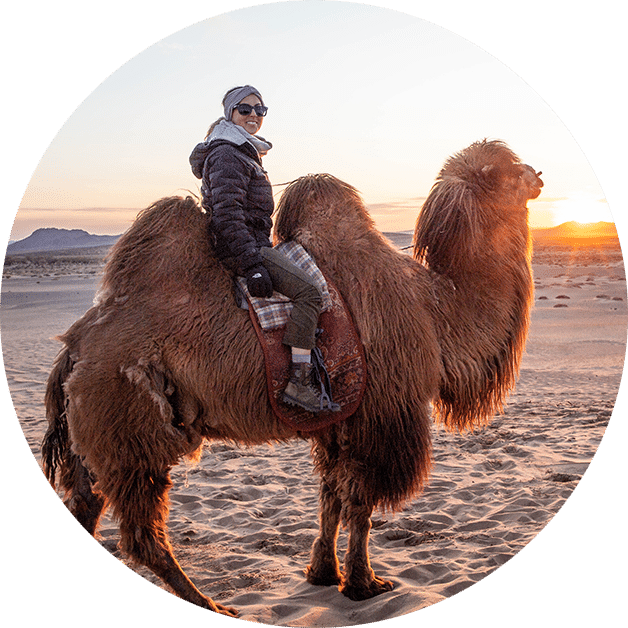
Author: Breanna Wilson
Hi! Sain uu! I’m Breanna, an American travel writer and adventurer living in Ulaanbaatar, Mongolia for more than 5 years. I’ve written for and been featured in Condé Nast Traveler, CNN, Forbes, and the New York Times, among others. Read more of my Mongolia travel articles here .
Mongolia hasn’t been on my radar, but after reading your post I have changed my mind. Thanks for the inspiration.
This sounds like a tremendous cultural experience. A lot of good information and tips on visiting Mongolia.
My mate visited the Golden Eagle Festival last year and it looked like such an amazing experience! That’s insane that rental companies are charging 2k for a deposit?! I wouldn’t be able to decide went visit, autumn sounds like a great time for me (I think i will struggle in the summer heat). Such a thorough guide. Thanks!
Great timing for this post, thanks for the practical information for a trip.
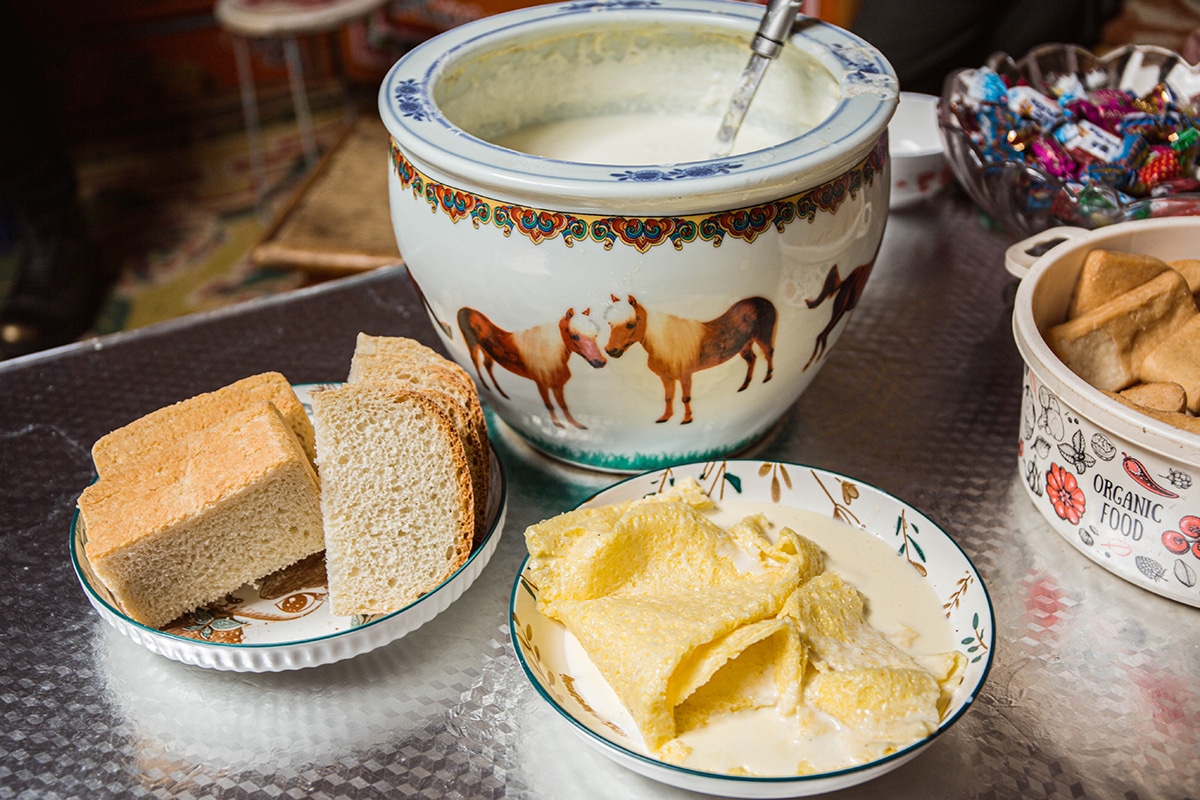
Yeruu Lodge, the Best Place to Stay in Selenge Province
Privacy policy, terms & conditions, join my private travel group on facebook.
Proudly Based in Ulaanbaatar, Mongolia © 2024 Meanwhile in Mongolia
AFFILIATE NOTICE
This website contains links to products and services where I may make a commission when you purchase. This supports the continued upkeep and development of this website. For an explanation on this policy, read my Advertising Policy page .
The 12 most incredible places to visit in Mongolia

Aug 30, 2023 • 9 min read

The blue freshwater lake of Khövsgöl Nuur is a stunning sight at any time of year © Tuul & Bruno Morandi / Getty Images
Famed as the birthplace of Chinggis (Genghis) Khaan, Mongolia will make you feel like you are on another planet, with its ancient nomadic culture, endless blue skies, and wild and untouched natural environment.
In today’s rapidly changing world, Mongolia stands eternal – a land of lush valleys, turquoise lakes, scenic canyons, water marshes, sand dunes, snow-capped mountains, rolling grasslands and alpine forests, as well as customs and traditions that have been preserved for centuries.
With 21 provinces and 330 soums (subdistricts) and an area of 1.56 million square kilometers, Mongolia is the world’s most sparsely populated country, home to just 3.4 million people in an area three times larger than France. It’s important to pay close attention to planning your itinerary and travel days, as well as preparing for the local conditions, particularly the weather and the long distances between soums.
Moving from north to south, the country can be divided into four zones: the mountain forest, the alpine steppe; and in the far south, regions of semi-desert and the harsh desert landscapes of the Gobi. Each province and region has its own unique natural features, so it can be challenging for tourists to choose a destination among the many hidden treasures in this remarkable country. To help you decide, we've gathered together our 12 must-see sites in Mongolia.
1. Bayanzurkh, Khövsgöl
Best place for pristine nature
The blue freshwater lake of Khövsgöl Nuur is very often the first place travelers see in Khövsgöl Province in the northern part of Mongolia. And the majority don’t go beyond this corner of the province, which is a shame as there are many more incredible places in other parts of Khövsgöl.
Located 160km (99 miles) from the lake, the Bayanzürkh region is definitely worth visiting – pristine rivers and the Ushir waterfall flow down the sides of high, dramatic cliffs near the rocky spires of Boshloi Rock. Locals call it heaven on earth and it deserves a place on your bucket list.
Planning tip: A paved road runs from Ulaanbaatar to the shores of Khövsgöl Nuur, but you’ll need a 4WD vehicle to explore Bayanzürkh.
2. East Taiga
Best place for wild adventure
Another of Khövsgöl Province’s lesser-known secrets is East Taiga, the home of the Tsaatan people, Mongolia’s traditional reindeer herders. While you’ll have to drive for more than 10 hours on bumpy, muddy mountain roads and make a difficult 60km (37 miles) journey on horseback to reach this site, you’ll be too busy marveling at the magnificent mountains and crystal clear rivers of this untouched region to mind. You can also visit the thundering, 25m-tall Urtun Khyarkhyn waterfall, which is seen by few outsiders. Be prepared for a big adventure that requires a little patience!

3. Tsenkher Hot Springs
Best place to relax
You can enjoy beautiful views of forested hills while relaxing in outdoor pools, or recharge in steaming indoor baths at the Tsenkher Hot Spring , which is open for all seasons, including winter. Naturally heated to 85C (185F), this is the second hottest spring in Mongolia after Shargaljuut, located at the foot of a forested mountain about 30km (18 miles) south of Tsetserleg city in Tsenkher soum. Locals believe the hot springs are good for treating rheumatism, neuralgia, muscular pain and arthralgia, improving the digestive system and restoring immunity after surgery.
Planning tip: Accommodation at Tsenkher Hot Springs is in ger camps; the popular Duut Resort is the most comfortable spot, with its own pools and accommodation in gers or a cozy wooden lodge.
4. Ikh Gazryn Chuluu
Most interesting cultural site
If your eyes grow tired of the sand dunes in the Gobi , the rocky, granite mountains of Ikh Gazryn Chuluu will give you a wonderful feeling of immersion into desert culture. There are many interesting stories about the people who lived or took shelter in the caves of this rugged range, and you can hear them at the theater dedicated to Mongolia’s tradition of the “long song” – epic, chanted folk songs that can last several hours. Visit in August to see the Uyakhan Zambuu Tiviin Naran Art Festival and experience Mongolia’s rich culture surrounded by peaceful and captivating nature.
Planning tip: The Ikh Gazryn Chuluu mountains are spread over an area of 20 sq km (7.7 sq miles) in Dundgovi Province, south of Ulaanbaatar; with a hired vehicle, you can get here via road from Mandalgovi in about an hour.
5. Khentii Province
Best place for walking in the footsteps of Chinggis Khan
Khentii Province has many historical places to pique the curiosity of those interested in the life of Mongolia’s greatest leader. There are numerous sites linked to the life of Chinggis Khan, including Khökh Nuur (the lake where Temujin was crowned as Chinggis Khan in 1206 CE), the Ikh Palace of Chinggis Khan, the Deluun Boldog (marking the great Khan’s birthplace) and the Gundgavirlan monastery.
Planning tip: Kentii province is situated in a region of great natural beauty, yet it’s only a one-day, 331km (205 miles) drive from Ulaanbaatar to Chinggis, the provincial capital. On the way, visit the country’s most famous Chinggis Khan Statue , just off the main road between Nalaikh and Erdene.

6. Tövkhön Khiid Monastery
Best place for meditating
Tövkhön Khiid is one of the prettiest, most intricately designed monasteries in the country. Located in an area of dense forests amidst picturesque mountains, 70km (43 miles) from Kharkhorin at an elevation of 200m (656ft), it’s quite unlike any other monastery complex in the country.
Zanabazar, who was the first leader of Buddhism in Mongolia, founded the monastery and lived and meditated here, calling it the “Land of Happy Solitude.” There are several nearby temples and a meditation cave to explore.
7. Gobi Gurvansaikhan National Park
Best place for desert landscapes
Mongolia’s most famous attraction is undoubtedly the Gobi desert , where you can trek or ride a horse or camel, surrounded by magnificent views. Gobi Gurvan Saikhan National Park in Umnugovi Province is one big playground for outdoor enthusiasts and a place to enjoy the harsh but uplifting landscape inhabited by Mongolia’s nomads.
The park is most famous for the dunes of Khongoryn Els, known as the “Singing Sands” because of the sound made by the shifting sand during strong winds. Another popular spot in the park is Yolyn Am , a dramatic gorge that is at its most stunning during winter when it’s filled with ice.
8. Kherkhruu Three Lakes
Best place to escape the crowds
Located around 180km (111 miles) from Ulaanbaatar in the Erdene soum of Tuv Province, the Kherkhruu Three Lakes (also known as Kherkhluur Saridag) offer a true wilderness experience. This untarnished place is set in the middle of high cliffs, surrounded by dense forests, and the road is lined with marshes, small rivers and willows. It’s a serene spot and the few travelers who visit mostly get here on horseback or by helicopter. As not everyone can go, this is one of the places that Mongolian tourists want to visit the most.
Planning tip: The Three Lakes lie within the Khan Khentii Strictly Protected Area ; look out for moose, brown bears and 250 species of birds as you explore.
9. Saikhanii Khutul
Best place to go by train
Mongolia’s railways go in only two directions: from north to south and from south to north, linking Mongolia, Russia and China . Train enthusiasts who want to see unforgettable views of high, forested mountains and the life of nomadic families and country farmers are recommended to travel by train from Ulaanbaatar to Selenge Province in the northern part of the country.
Less than 10km (6.2 miles) from the provincial capital, Sükhbaatar, you can visit Saikhanii Khutul, a mountainous area with spectacular views over the Orkhon and Selenge river basins.
Planning tip: Trans Mongolian Railways trains to Russia are currently suspended because of the war in Ukraine, but local trains run from Ulaanbaatar to Sükhbaatar via Darkhan.

10. Khuiten Uul
Best place for trekking
Altai Tavan Bogd National Park , located 1920km (1193 miles) from Ulaanbaatar in Bayan-Ulgii Province, is a dream destination for trekkers, mountaineers, and wildlife and nature lovers. Not only is the national park rich in nature, but the surrounding area is also home to varied ethnic groups and fascinating historical sites. The highest peak at Altai Tavan Bogd is snow-capped Khuiten Uul (4374m/14,350ft), the highest point in all of Mongolia, which is accessible to experienced mountaineers on organized expeditions.
You also can't miss the Shiveet Khairkhan petroglyphs, listed as a World Cultural Heritage site by Unesco. The rock drawings cover varied subjects, from wild animals to figures on horseback and cover a huge area; the earliest were created at the beginning of the Bronze Age.
Planning tip: For a taste of the mountains, the trek to Khuiten Uul Base Camp from the Tsagaan Gol Valley (accessible by vehicle from Ölgii) is a rewarding day hike. On your way from town to the park, you can visit the White River and historical ruins and Kazakh eagle hunters.
11. Tsagaan Suvarga
Best place for landscape photographers
Dundgovi Province may seem like a sleepy place with not much to see, but the area has so much more to offer than it seems. In particular, it’s worth taking a trip to explore the incredible badlands at Tsagaan Suvarga , known as the “Grand Canyon of Mongolia” and reminiscent of the surface of Mars.
The cliff walls are more than 60m (197ft) tall at their highest point, and the canyon continues for 400m (1312ft). From a distance, it looks like the ruins of a city or a vast building, but looking from above will take you back to a time before humanity existed when this area was home to dinosaurs and other giant animals. In addition to wild sedges, grasses and buckwheat, the valley is rich in other Gobi plants, such as sagebrush and wild leeks.
12. Ulaanbaatar
Best for city experiences
You may have heard that the Mongolian summer is delightful, but even in winter, traveling to the world’s coldest capital city will give you a challenging yet unique experience. Ulaanbaatar has a reputation for traffic congestion and winter smog, but you don’t have to spend a lot of time outdoors.
The warm museums of this sprawling city will take you on a fascinating cultural and historical tour; must-visits include the Chinggis Khaan National Museum , devoted to the great Khan, and the Winter Palace of the Bogd Khaan , once home to Mongolia’s last king, Bogdo Jebtsundamba Khutuktu.
Planning tip: If you’d rather visit in the summertime, Naadam, the nation’s biggest festival, takes place in July. Big crowds gather at the Central Stadium, but many foreign tourists miss the action at the Khui Doloon Khudag horse racing ground outside the city; head here to see how real locals celebrate the festival!
Explore related stories

Destination Practicalities
Aug 29, 2024 • 7 min read
Train, plane, shared taxi or your own car? There are many ways to get around Uzbekistan. Here’s a full guide to them.

Aug 20, 2024 • 13 min read

Aug 12, 2024 • 12 min read

Aug 5, 2024 • 6 min read

Jul 31, 2024 • 5 min read
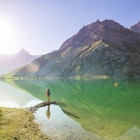
Jul 18, 2024 • 6 min read

Jul 15, 2024 • 5 min read

May 29, 2024 • 7 min read

May 28, 2024 • 9 min read

Mar 14, 2024 • 10 min read
- South Korea
- United Arab Emirates
- New Zealand
- Travel Tips
- travel resources
- Get In Touch
- Start A Blog

- Destinations
Ultimate 9-Day Mongolia Travel Itinerary & What To Expect
- May 13, 2024
- 20 minute read
Psst, FYI – this post may contain affiliate links, which means I earn a small commission (at absolutely no extra cost to you) and ads keep this blog free for you to enjoy. Thanks for supporting the free content on this site (and for sponsoring more doggy treats for little Albus!)
Are you ready to embark on a journey to the wild and untamed beauty of Mongolia? To date, I’d easily say this was one of my favorite trips so far. And if you’re still unsure about this offbeat destination, let me share my experience so you’ll know why Mongolia should be on your bucket list, and what to expect along the way.
Mongolia was a travel destination my friend and I picked a few years ago before the blip in time we all know as COVID-19 happened.
We were throwing out ideas like Bhutan and Nepal… basically, anywhere we could seemingly go off the grid and experience a place at its rawest.
No bustling cities or tourist traps.
We wanted to go somewhere we could be alone with nature.
Finally, we settled on Mongolia.
Once the borders opened, we booked our tickets and we were in for the ride of our lives.
Now, Mongolia is no walk in the park.
Here, you have to surrender yourself to Mongolia’s embrace. Forget about schedules, let go of control, and open your eyes to the unexpected.
Once you do, you’ll discover sides of yourself you never knew existed. Leave the comforts of home behind and just— experience .
Mongolia will push you to your limits, challenge your preconceptions, and force you to let go of control. But hey, that’s what makes it so thrilling!

In this itinerary, we will be spending 7 days out in the Gobi Desert , a region that will test your spirit of adventure. Mother Mongolia doesn’t mess around; just when you think you’ve got it all figured out, she throws a wild card your way.
So, why should Mongolia be on everyone’s bucket list?
It’s simple – you have to experience it for yourself.
And when you do, get ready for an epic adventure. With so much to explore, it can be difficult to decide where to start and what to include in an itinerary.
In this blog post, I’ll outline an 11-day Mongolia travel itinerary that covers some of the rawest highlights of the country which includes Central Mongolia and the Gobi Desert.
But don’t worry, I’ve got you covered.
Here’s everything you need to know about embarking on your first journey to Mongolia.
Get ready to embrace the wild, discover your true self, and create memories that will last a lifetime. Mongolia awaits, my fellow adventurers!
- 1 Why Mongolia Should Be at the Top of Your Bucket List
- 2 The Ultimate Mongolia Itinerary
- 3 Where is Mongolia?
- 4 How do I get to Mongolia?
- 5 How do you get around Mongolia?
- 6 Is Mongolia safe?
- 7 What’s the best month to visit Mongolia?
- 8 How many days do you need in Mongolia?
- 9 Do you need a visa in Mongolia?
- 10 Can you go to Mongolia without a tour?
- 11 Money in Mongolia
- 12 SIM Cards in Mongolia
- 13 Drinking water in Mongolia
- 14 MY TOP TRAVEL TIPS & RESOURCES
Why Mongolia Should Be at the Top of Your Bucket List
Prepare for an adventure that will kick your wanderlust into high gear!
In Mongolia, you can ride reindeer, join the ranks of eagle hunters, or hop on a camel for a wild ride across the magnificent Gobi Desert. It’s a thrill-seeker’s paradise where every moment is packed with excitement and wonder.
It’s no wonder CNN named Mongolia the country to visit in 2023.
Jaw-Dropping Landscapes
Get ready to have your mind blown by the epic beauty of Mongolia’s vast steppe, rugged mountains, and mind-boggling deserts.
I don’t think I’ve been so awe-struck every single day in a row before.
The ability to start every day surrounded by nature in its most pristine and unaltered form was such a treat to my senses. And seriously, your Instagram feed will thank you!
Nomadic Vibes
This might have been my favorite part of my entire Mongolian adventure (if picking a favorite was even possible).
It was the most precious experience getting to immerse myself in the nomadic culture of Mongolia and learn about their culture and traditions.
Some of my favorite moments were in the evenings when we would sit in the ger preparing dinner with our hosts; or playing traditional games with them.
We even got to witness a yak giving birth! Seeing a newborn calf arrive before our own eyes was wild.
And we didn’t just observe the nomad life, we lived it too.
They’d let us hop on their motorbikes in the evenings to go round up the yak herd before dark.
It’s like stepping into a whole new world!
Adventure Awaits
Mongolia is a paradise for adventure junkies. From galloping on horseback across the open plains to riding camels through the desert during sunset, it’s a thrill-seeker’s dream come true.
Definitely unlocked a core memory for me!
Soul-Stirring Moments
Through the course of my trip, I had countless “pinch-me” moments that touched my soul.
The serene landscapes, the simplicity of life, and the genuine connections you’ll make left an indelible mark on my heart.
I kept pondering how amazing life would be if we could just replicate this life in the city.
Mongolia just has a way of changing you for the better.
Animal-lovers Paradise
Mongolia’s five jewels are its animals, namely horses, goats, camels, cows, and sheep.
We got to meet and interact with all five which was an absolute dream come true for me. I even got to carry a few kids (baby goats)!!!!
Here you’ll get up close and personal with these animals in their natural habitat.
No fences, no ticket prices, no barbed wires. Just you and these glorious creatures.

So, pack your sense of adventure, a camera with lots of storage space, and an open mind. Mongolia is calling, and it’s time to answer that call.
The Ultimate Mongolia Itinerary

When planning our Mongolia trip, we were spoilt for choice with all the beautiful sights the country has to offer.
We ended up opting for a more authentic experience that focused on nature and nomadic living.
In this Mongolia itinerary, we explore the Gobi Desert and Orkhon Valley where we get to walk on frozen rivers, go horseback riding, and experience the nomadic way of life.
Without further ado, here we go!
Day 1: Arrival in Ulaanbaatar
Start your Mongolian adventure in the capital city of Ulaanbaatar.
Spend the day exploring the city, or if you’re arriving late just like us, get lots of rest and enjoy a good shower as you won’t be having one for a while!
It’s also a good opportunity you’ll need for the next 9 days away from civilization.
Yes! Did you know that if you’re opting for the most nomadic experience in the Gobi Desert, you’ll have to be comfortable forgoing a few showers!
Day 2: Journey into the Mongolia desert

Today we met up with our tour guide and driver from Sunpath Mongolia who were going to be with us for the next 9 days.
Once you leave Ulaanbaatar, most of the journey will be off-road so hiring a local company to take you will be your best bet as roads are unmarked and you’ll literally be driving through the desert!
Our journey begins with a 450km (279 miles) drive to the iconic White Stupa, also known as Tsagaan Suvarga.
We stopped for lunch in a town called Mandalgovi where we tried local food for the first time!
Mongolian dishes mostly consist of meat. Meat, meat, and lots more meat.
You’d be hard-pressed to find much vegetables here. Most of the time, you’ll only find carrots and potatoes. Sometimes , you’ll find cabbage.
But remember, out in the desert, it’s hard to grow leafy vegetables so say goodbye to your spinach and kale for a couple of days.

Located in the Middle Gobi Province, the White Stupa is a geological formation that stands out with its towering cliffs of white and orange limestone, resembling ancient ruins.
The White Stupa holds significant geological importance, with its layers of sediment representing millions of years of natural history.
The unique colors and shapes of the cliffs create a surreal and magical atmosphere, making it a photographer’s dream.
It is a popular tourist attraction due to its stunning white and orange cliffs that resemble a massive stupa or temple.

The cliffs offer a fantastic opportunity for photography, especially during sunrise or sunset when the colors become even more vibrant.
Aside from the visual appeal, the White Stupa holds significance for the local nomadic herders who consider it a sacred place. It is believed to have spiritual and healing properties, and visitors are encouraged to show respect and be mindful of the cultural and natural significance of the site.
After we were done exploring the White Stupa, we headed to our ger for the night situated just a few minute’s drive away.
Days in Mongolia are mostly like this as distances between sights can be quite long, so you’ll often be visiting one sightseeing spot per day while spending most of your time on the road.
We were very excited for our first night in our ger! Our host was a lovely Mongolian lady who made us dumplings for dinner! I met my first herd of sheep here which had me squealing in delight.
Our first night out in the ger was so surreal. Having to get used to no running water, no showers, and no toilets – living with the bare minimum but we still found it bearable.
There also wasn’t any service there so it was a great opportunity for us to get to know each other better and actually talk!

Day 3: Walk on ice at the Yol Valley

Our journey continues as we make a stop in Dalanzadgad , the capital of the South Gobi Province.
This small town serves as a gateway to the Gobi Desert so we were able to stock up on some amenities and… take a hot shower!
There are public showers in the town where you can freshen up, and I was pleasantly surprised by how clean and spacious these shower rooms were!

From Dalanzadgad, head to the enchanting Yol Valley , also known as the Eagle Valley.
This deep and narrow gorge is renowned for its dramatic rock formations, icy streams, and stunning wildlife.
As we embarked on a 5km walk through the valley, we were surrounded by towering cliffs that harbor rare and endangered species, such as the bearded vulture and Siberian ibex.

In the evening, we retreat to our gers nestled within the Yol Valley.

Day 3: Marvel at the Khongor Sand Dunes and ride camels into the sunset

This morning we woke up to a sudden snowstorm which covered the ground and our gers in a blanket of white! I told you to expect everything when you’re in Mongolia – haha!
After walking on ice yesterday, today we’re off to the mesmerizing Khongor Sand Dunes , also known as the “Singing Sands.”
I told you you’ll be experiencing all sorts of conditions in Mongolia!
These expansive sand dunes stretch across the southern part of Mongolia, covering an area of over 180 kilometers.

Upon arrival, we are immediately captivated by the grandeur of the sand dunes, with some reaching heights of up to 300 meters.
The Khongor Sand Dunes are known for their shifting patterns, shimmering golden colors, and the melodic sound produced when the sand is disturbed by the wind, hence the name “Singing Sands.”

It is quite a climb, so make sure you’ve got your stamina in tow. I only managed to climb up to the halfway point before giving up.
I’d say you’d have to be relatively fit to reach all the way up to the peak. Because you sink into the sand with every step, so it takes relatively more effort than walking on solid ground. But it’s definitely worth a shot if you can muster up the strength and stamina!
Once we reached our nomad family for the night at Ongi River, we were surprised with a camel riding experience through the sunset which was truly magical.

And after the camel ride, I got to cuddle some baby goats! I feel like I died and went to heaven!

Tonight we rest, and for the first time, going a whole day with no showers!
There was also no service in the area, so the experience was as authentic as it comes!
We spent the evening playing some local games with the host family using ankle bones (yes, goat bones!).

Day 4: Walk in the footsteps of the dinosaurs at the Flaming Cliffs

This morning we set off at 7 am to the Flaming Cliffs , also known as Bayanzag .
These towering red and orange cliffs hold great significance, most famous for yielding the first discovery of dinosaur eggs . It was so fascinating imagining dinosaurs once roaming on the very ground we were walking on!

Continuing our journey, we make a stop in Bulgan for lunch. We were supposed to have another shower here but the public showers were closed. Accepting hiccups is all part and parcel of traveling in Mongolia!
And in the nomadic spirit of flexibility, we trudge on and continue on our journey. At this point, we might even be getting used to this level of hygiene (or, maybe not)!
Next, we visit the historic Ongi Monastery , which once stood as one of Mongolia’s largest Buddhist monastic complexes.
Sadly, it was destroyed during the communist era, leaving behind evocative ruins that still hold immense spiritual significance.
Day 5: Visit Mongolia’s ancient capital, Kharkhorin
Today’s drive is especially long, but it’s going to be a relaxing day.
We set off for Kharkhorin , the ancient capital of the Mongol Empire and an important historical site. This historic city served as the political, economic, and cultural center during the reign of Chinggis Khan and his successors.

Upon reaching Kharkhorin, we satisfied our hunger with a delicious lunch before visiting the renowned Erdene Zuu Monastery .
This architectural masterpiece stands as a testament to Mongolia’s spiritual heritage and is considered one of the country’s most important monasteries.
Not pictured is us walking through the monastery braving an epic sandstorm ! And to think we were just hit with a snowstorm the day before.
Never a boring moment in Mongolia!

Despite the weather conditions, we were lucky that tonight we would be staying in a hotel !
That’s one of the great things about Sunpath —they knew to break up our itinerary of staying in the gers every night with a 1-night hotel stay! Awfully thoughtful of them and much needed by us.
We hugged our toilet bowls, marveled at the water faucets, and reveled at the rain shower—comforts we so often take for granted in our daily lives.
Day 6: Immerse yourself in Orkhon Valley’s breathtaking landscapes
Today we start our journey to what would become my absolute favorite part of this Mongolia itinerary — Orkhon Valley, a UNESCO World Heritage Site known for its natural and cultural significance.
The valley encompasses breathtaking landscapes, including rolling hills, lush meadows, and the Orkhon River, which meanders through the region.

Everywhere you turn was a postcard view waiting to be snapped. Rolling hills and frozen rivers with horses grazing nearby. I had to pinch myself to make sure I wasn’t dreaming.

In the Orkhon Valley, we had the privilege of staying with a nomadic family. We got to experience daily life with them, helping them herd their cattle, and even experienced a yak giving birth!

This was our favorite nomad ger of all too. I mean, look at that landscape! Waking up to that view does wonders for the soul.

Day 7: Orkhon Valley
Today was the day we had been excitedly anticipating. We get to ride horses!
We were a little nervous as most of us had never ridden horses in the wild before (I only did once when I was in Sydney ), but our host was great at making us feel comfortable throughout the whole process.
They dressed us up in their traditional riding outfits and off we went on a thrilling 20km horse riding journey to the magnificent Red Waterfall , also known as Ulaan Tsutgalan .

The feeling of riding through the open plains like this is just simply indescribable . It felt so surreal; like something right out of a movie scene!
I playfully compared myself to Mulan, riding on her horse to protect her country.
Then, our guide quipped, “Do you know who Mulan’s enemies were?”
Instantly, I retracted my statement, and we all shared a good laugh.

We were even lucky enough to capture a herd of yaks crossing the river! Here, we stopped for a nourishing picnic lunch which we absolutely enjoyed!

Continuing our exploration of Mongolian traditions, we engage in archery, a sport deeply rooted in the country’s nomadic heritage. Can’t say I got the hang of it, but at least I gave it a shot! Pun intended.

Day 8: Return to Ulaanbaatar
Today was the bittersweet day we were dreading.
While we were excited about returning to the comforts we were accustomed to, like running water and a clean bed, there was a palpable sense of sadness knowing that we would soon be leaving behind the closeness to nature and the serenity it granted us.
It was a 10-hour drive back to the city, but it allowed us to reflect on the remarkable experiences we’ve had and the profound connections we’ve forged with the land and its people. Or in other words, sleep .
Day 9: Chinggis Khan Statue and Ulaanbaatar City Tour

Before concluding our Mongolian adventure, we set aside a day to visit the magnificent Chinggis Khan Statue , a colossal tribute to Mongolia’s legendary leader.
The statue stands at an impressive height of 40 meters and offers panoramic views of the surrounding countryside. It’s a sight worth seeing if you have the time!
In the afternoon, we take a walk around the city of Ulaanbaatar, the bustling capital of Mongolia. It definitely shot down many misconceptions I had about the city. It’s much more developed and modern than I imagined!
Where is Mongolia?
Mongolia is a landlocked country located in East and Central Asia. It is bordered by Russia to the north and China to the south, east, and west. The capital city, Ulaanbaatar, is situated in the north-central part of the country.
How do I get to Mongolia?
Mongolia is a relatively remote country, but it is possible to reach it by air or overland. Here are some of the most common ways to get to Mongolia:
- Chinggis Khaan International Airport in Ulaanbaatar is the main gateway to Mongolia and is served by several airlines from various countries, including Korean Air, Air China, Turkish Airlines, and MIAT Mongolian Airlines.
- From Russia: The Trans-Siberian Railway connects Moscow to Ulaanbaatar, with a journey time of around 4 days. It is also possible to cross the border by road.
- From China: There are several border crossings between China and Mongolia, with regular buses and trains connecting major cities in China to Ulaanbaatar.
It is important to note that visa requirements vary depending on your nationality and the purpose of your visit. Be sure to check the current visa requirements and regulations before traveling to Mongolia.
How do you get around Mongolia?
Getting around Mongolia can be an adventure in itself, as the country is vast and its infrastructure is still developing. A lot of the time we found ourselves driving through the desert on unmarked roads. And we were left wondering how our driver even knew where he was headed to, but we always made it to our destination safely.

With that said, I highly discourage first-time travelers from renting a car and driving on their own.
You might be able to do that in Ulaanbaatar, but if you’re venturing any further than that, I highly recommend going with a reputable tour company that’ll arrange a professional guide and driver for you.
It is important to note that road conditions and transportation options may vary depending on the season and weather conditions. Be sure to research and plan ahead to ensure a safe and enjoyable journey in Mongolia.

Is Mongolia safe?
Mongolia is generally considered a safe country for travelers. The crime rate is relatively low, and violent crime is rare. However, as with any travel destination, there are some risks to be aware of.
One potential risk in Mongolia is the harsh and unpredictable weather, particularly in the winter months when temperatures can drop below -40°C (-40°F) and blizzards can occur. Travelers should be prepared for extreme weather conditions and follow the advice of local authorities.

Another potential risk is the condition of the roads and transportation infrastructure. Many roads in Mongolia are unpaved and can be difficult to navigate, especially in rural areas. Travelers should exercise caution when driving or riding in vehicles and ensure that their chosen mode of transportation is safe and reliable.
Finally, as with any travel destination, it is important to take precautions to protect your personal belongings and avoid scams or tourist traps. It is also recommended to avoid political demonstrations or protests, as these can sometimes turn violent.
Overall, with proper planning and precautions, Mongolia can be a safe and enjoyable travel destination.
What’s the best month to visit Mongolia?
The best time to visit Mongolia is during the summer months from June to August when the weather is warm and dry, and the countryside is in full bloom.
This is the peak tourist season, and the days are long, providing ample time to explore the vast landscapes and experience the rich cultural traditions of the nomadic herders.
Tourist ger camps are open during this time so those seeking a little more comfort while traveling in the desert can opt for this period.

During the summer months, temperatures can range from 20°C to 30°C (68°F to 86°F) during the day but can drop significantly at night, so it is important to bring warm layers for evenings and early mornings.
Mongolia is notorious for experiencing 4 seasons in a day. While we were there in April, we experienced 15°C days and subzero nights, so a good layering strategy is essential when traveling in Mongolia.
I’ll be posting a Mongolia packing guide soon to share my packing list tips and tricks.
If you are interested in attending the Naadam Festival, a traditional Mongolian festival featuring sports competitions, music, and dance, it takes place every year from July 11th to 13th in Ulaanbaatar and other parts of the country. I highly recommend visiting during this time. I plan to revisit Mongolia just for this festival in the future!
While the summer months are the most popular time to visit Mongolia, it is worth noting that the shoulder seasons of April, May, and September can also be good times to visit, with fewer crowds, cooler temperatures, and beautiful autumn foliage in September.
We visited in late April, one week before the tourist camps opened, and we had almost if not all the tourist attractions to ourselves. The weather was great, and we could take everything at a leisurely pace. If you can, I highly recommend coming during this time!
How many days do you need in Mongolia?
The number of days you need in Mongolia depends on your travel preferences and what you want to do and see during your trip. However, for a general Mongolia itinerary, a minimum of 7-10 days is recommended to fully experience the country’s unique culture, stunning landscapes, and traditional nomadic way of life.
With a 7-10 day itinerary, you can explore the capital city of Ulaanbaatar, visit the famous Terelj National Park, hike in the Altai Mountains, ride horses or camels with nomadic herders, and experience the Naadam Festival if your trip coincides with it.
Of course, if you have more time, you can explore additional regions and activities in Mongolia, such as visiting the Gobi Desert, Khovsgol Lake, or the ancient city of Karakorum, the former capital of the Mongol Empire.
It is worth noting that Mongolia is a vast country, and travel times can be long and sometimes challenging, especially in rural areas. On some days, we were on the road for 5-8 hours. It is important to plan your itinerary carefully and factor in travel time between destinations to ensure a comfortable and enjoyable trip. But if you go with a tour company, they will plan everything out for you according to how much time you have.

Do you need a visa in Mongolia?
Whether or not you need a visa to enter Mongolia depends on your nationality and the purpose and length of your visit.
Visa-free entry:
- Citizens of 26 countries, including the United States, Canada, the United Kingdom, and many European countries, can enter Mongolia visa-free for up to 30 days for tourism and non-work-related purposes.
Visa-on-arrival:
- Citizens of several other countries, including Australia, New Zealand, Japan, and South Korea, can obtain a visa on arrival at the airport in Ulaanbaatar for a fee. The visa is valid for up to 30 days for tourism and non-work-related purposes.
Visa required:
- Citizens of some countries, including India and China, are required to obtain a visa in advance from a Mongolian embassy or consulate before traveling to Mongolia.
It is important to check with the Mongolian embassy or consulate in your home country to confirm the visa requirements for your specific situation and plan accordingly.
Can you go to Mongolia without a tour?
The answer is yes and no. If you’re just planning to travel around Mongolia’s capital city, Ulaanbaatar, then yes it is possible. However, if you’re planning to venture out of the capital city, independent travel can be challenging, especially if you are not familiar with the local language, customs, and geography.
If you decide to travel independently, you will need to arrange your own transportation, accommodation, and activities. While there are some public transportation options available in Mongolia, they can be infrequent and unreliable, especially in rural areas.

Additionally, the nomadic way of life in Mongolia means that many attractions, such as traditional ger camps and horseback riding experiences, are often owned and operated by local families rather than large tourist companies, which can make it more difficult to book directly without local connections.

We personally booked a tour with Sunpath Mongolia , and it was the best decision we made on the trip.
Although I ordinarily prefer to travel independently and take the less touristy route, traveling through the Gobi and the more remote areas in Mongolia requires the help of a tour guide and driver. But Sunpath managed to let us experience Mongolia as authentically as possible while still making it as comfortable as possible for us.
Money in Mongolia
The official currency of Mongolia is the Mongolian Tugrik (MNT). Cash is the most commonly used form of payment in Mongolia, especially in rural areas, so it is recommended to carry cash with you during your trip. However, some larger businesses, hotels, and restaurants in urban areas also accept credit cards.
Here are some tips and information regarding money in Mongolia:
- ATMs: ATMs are available in Ulaanbaatar and other major cities in Mongolia, but they may not be as widely available in more remote areas. Some ATMs may only dispense Mongolian Tugrik, so make sure you have a currency conversion calculator or app to ensure you withdraw the correct amount.
- Currency exchange: It is recommended to exchange money at banks or exchange offices in Ulaanbaatar or major cities. Avoid exchanging money on the street, as this can be unsafe and unreliable.
- US Dollars: US Dollars are widely accepted in Mongolia, and some hotels and tour operators may also accept payment in USD.
- Tipping: Tipping is not expected in Mongolia, but it is becoming more common in tourist areas. If you feel that the service was exceptional, a small tip is appreciated.
- Budget: The cost of travel in Mongolia can vary widely depending on your travel style and itinerary. Budget accommodation and food can be found for around $20-30 per day, while mid-range hotels and restaurants can cost around $50-80 per day. Tours and activities can range from $50-100 per day and up.
Overall, it is recommended to have a mix of cash and credit cards with you during your trip to Mongolia and to plan your budget carefully to ensure you have enough funds for your entire trip.
SIM Cards in Mongolia
Getting a local SIM card is a good option for travelers to Mongolia who want to stay connected and have internet access on their phones during their trip.
The three main mobile network operators in Mongolia are Mobicom, G-Mobile, and Unitel. They all have booths at the airport and in Ulaanbaatar, and SIM cards can also be purchased at some convenience stores and supermarkets. We picked up a Mobicom SIM card for 15,500MNT (USD4.40) which gave us 15GB for the duration of our trip.
We were lucky to have picked Mobicom as our guide told us that Mobicom has the best coverage in the desert. However, coverage is still spotty regardless, and we had no service when we were traveling on the roads on certain days, and in certain ger guesthouses. In general, we had an internet connection about 60% of the time, which is a lot more than I was expecting!
Alternatively, if you don’t want the hassle of changing SIM cards, you can download the Airalo app , purchase a package, and get connected instantly! This is my favorite way to stay connected as it saves all the hassle of buying a SIM card and messing about with these tiny SIMs. PLUS, you can purchase the package in advance and get connected instantly even when you’re still on the plane! Find out more about Airalo.
Drinking water in Mongolia
Access to safe drinking water can be a concern in Mongolia, especially in rural areas. Our guide bought us enough bottled water to last us throughout our trip, and we used this water for drinking and for brushing our teeth. There is no running water while we’re out in the desert!
The nomads usually get their water from nearby wells and filter them before drinking or cooking. To be safe, make sure to have bottled water with you or bring a filtered water bottle for travel that provides clean drinking water anywhere on Earth. It filters almost any type of water, including from river streams, and turns it into clean drinking water.
This 9-day Mongolia travel itinerary has been a journey of discovery, allowing us to connect with nature, immerse ourselves in nomadic culture, and witness the beauty and authenticity of Mongolia. Mongolia has enriched my life, and I hope I’ve inspired you to embark on your own unforgettable journey through this captivating country.
Has Mongolia been on your bucket list? Or have you been to Mongolia and have your own stories to share? Leave me a comment below!

MY TOP TRAVEL TIPS & RESOURCES
Here are my top travel tips and resources to help you save money and plan your trips effectively! If you're looking for more tips, head over to my travel tips resource page or my comprehensive guide on trip planning .
- Booking Flights: When it comes to finding great flight deals, I always start my search on Google Flights or Skyscanner . To save some cash, consider flying mid-week or on the weekends, opt for carry-on only with budget airlines, and be open to red-eye or early morning flights. Check out my in-depth guide on how I find the cheapest flights .
- Accommodations : I'm a stickler for finding the absolute best deals on my stays, so I will obsessively oscillate between a few booking sites: Booking . com (in general) and Agoda (for Asian destinations). When it comes to vacation rentals, there's Airbnb or VRBO .
- Travel Insurance : It's always a wise decision to purchase travel insurance for international trips. I can't stress this enough - it's highly recommended! For international travel insurance, I suggest considering World Nomads or SafetyWing . SafetyWing , in particular, stands out as one of the few policies that cover Covid-19. They also offer excellent monthly policies that are perfect for digital nomads and long-term travelers!
- Travel Credit Card : My go-to travel credit card for booking trips is the Wise travel card. I love that there are no foreign transaction fees, so I can pay like a local and never get any surprises at the end of my trip. You can also withdraw cash from the ATMs wherever you are. With Wise , you are always guaranteed the best exchange rate, and I have saved sooo much money just by using this card. Most of the time, I get charged the exchange rate I see on Google, plus or minus a few cents.
- Tours: Most times, I prefer traveling independently but sometimes, getting a guide and a local's perspective makes the experience all the more enriching. When it comes to tour bookings, I trust Viator and GetYourGuide to provide me with excellent options. In Asia, I choose Klook as they are the biggest provider in the region. Plus, you can often get entrance tickets and discounted prices!
- Transportation : To navigate through public transit options and plan my journeys from one place to another, I rely on Rome2Rio. When it comes to rental cars, I compare rental companies and find the best deals through DiscoverCars .
- Connection : It's essential to me to have seamless connectivity wherever I go. I need it to navigate to new places, Google what's around me, and keep in touch with my loved ones. But fumbling around with multiple SIMs has always been a nightmare, which is why I choose Airalo when I travel. No more switching SIMs, just purchase a plan on your phone, on the go, anywhere, and stay connected.
- Luggage Storage : Whenever I need to check out early or take advantage of a long layover, I securely store my luggage with Radical Storage . It's a reliable service that allows me to roam around freely. As a bonus, you can use this link to enjoy your first hour of FREE luggage storage on me!
- What to Pack : I always have packing anxiety once I've left home— you know the phantom feeling that you've forgotten something even though you've checked 372836 times . So I made my own packing list and use it religiously before every trip, and by religious I mean I tick off that list at least 7 times before I zip up my bag. Check out my in-depth packing list here.
You might like these posts!
Discover more from the atlas edit..
Subscribe to get the latest posts sent to your email.
Type your email…

Hi! I’m Steph. You probably ended up here because just like me, you have an insatiable thirst for trotting the globe, or are just curious about travel. Get ready for brutally honest and in-depth travel guides that will be your trusty companions on global adventures. No fluff, just real talk and practical tips to make your journeys smooth. Join me as we conquer the globe, one epic destination at a time! Together, we’ll uncover hidden gems, laugh at mishaps, and create unforgettable memories. So grab your passport, pack your sense of adventure, and let’s embark on this thrilling journey!

The Ultimate DIY Tour Of Stockholm Subway Art (Maps included!)

- North America
The Ultimate 3-Day Toronto Itinerary for First-Timers
- May 19, 2024
You May Also Like

Easy Hikes in Vancouver: 6 Beginner Trails For the Lazy Hiker
- June 17, 2024

2 Days in Seville Itinerary: Top Things To Do in Seville, Spain
- June 14, 2024

Day Trip to Whistler from Vancouver in Summer (Or For Non-Skiers!)
- May 27, 2024

Is Lisbon Worth Visiting? 10 Reasons You Absolutely Need to Visit Lisbon, Portugal in 2024

2, 3 or 4 Days in New York: A Non-FOMO New York Itinerary for First Timers
- May 22, 2024

3-Day Baku Itinerary + Everything you need to know!
- May 20, 2024

- Coffee Guides
The Best Coffee in Toronto: A Caffeine Lover’s Guide to Toronto’s Best Cafes
Hi there, I really enjoyed your Mongolia travel itinerary ! May I know which travel agent did you use for your trip? Thanks!
Hi Rose, I went with Sunpath Mongolia and only have good things to say about them! Please go, I promise you will have the trip of a lifetime!
Love this 7-10 day itinerary to experience Mongolia. This was not on my radar but is now! Love the nomadic vibe and Gobi Desert would be a fascinating adventure!
Thank you for a good introduction with lots of useful info! I’m hoping to plan a trip to Mongolia and feeling overwhelmed with all the different routes available. Your post is a great find!
Leave a Reply Cancel reply
Your email address will not be published. Required fields are marked *
Notify me of follow-up comments by email.
Notify me of new posts by email.
Input your search keywords and press Enter.
Mongolia Travel Guide
Book your individual trip , stress-free with local travel experts
Select Month
- roughguides.com
- Travel guide
- Local Experts
Plan your tailor-made trip with a local expert
Book securely with money-back guarantee
Travel stress-free with local assistance and 24/7 support
Mongolia, an untamed land of beauty and traditions, yet fused into a tapestry of unmatched adventure on the face of this Earth. Here, you'll find yourself travelling across the vast, open steppes, sharing under a blanket of stars with the nomadic herders, and discovering a very vibrant cultural heritage that has survived and thrived against all odds in this harsh landscape . From the capital city of Ulaanbaatar to the Gobi Desert, Mongolia is an interesting mix of traditional and modern influences in a country that dishes out all sorts of experiences for the adventurous traveller at heart.
The timeless beauty of Mongolia
Things to do in mongolia, what is the best time to visit mongolia, travel ideas for mongolia.
Created by local experts

Horses and camels: Small Gobi & Arkhangay
An epic adventure through Mongolia, blending ancient traditions with stunning scenery. Start in Ulaanbaatar, where you'll dive into local culture with traditional performances. Explore Khustaïn Nuruu National Park for wild horses and yurt camping, followed by camel rides in Khögnö Khan "Small Gobi".

Danshig Naadam & Gobi Tour
Small group tour - starting August 2, 2024. Immerse yourself in the vibrant Danshig Naadam festival, celebrating tradition and athleticism. Explore the stunning landscapes of Arkhangay, where lush meadows meet snow-capped mountains. Journey further to the vast Gobi desert.
If you are up for an adventure and an off the beat experience, Mongolia is your next destination. Travelling here will, undoubtedly, exceed all your expectations.
Mongolia's rich tapestry is woven with threads from ancient traditions, from the sonorous sounds of the Morin Khuur to the spectacle of the Golden Eagle Festival. Across this land, follow in the footsteps of a world where the past lives concurrently with the present; it's not just a normal travel experience.
Whether you are galloping across the steppes, just out exploring ruins of the Mongol Empire , or flushing out from the warm hospitality of local herders, Mongolia's adventure will find their way into your heart.

Typical Mongolian ©Shutterstock
Mongolia is unique in every sense of the way. This is not your typical holiday destination. Positively. You won't find white sand beaches, cosy streets with outdoor bars or bustling cities. Instead, you will find a fairytale landscape, age-old traditions and genuinely interested people. And above all: hardly any tourists .
An overview of the many things you can do in Mongolia.
Exploring Ulaanbaatar
Start your adventure in Mongolia from the pulsing heart of the country that unites ancient culture with modern life—Ulaanbaatar. Drop by Gandantegchinlen Monastery to find your peace and the National Museum of Mongolia to dig the history of this great nation out. The city will be your door to the greatness of Mongolia.
Wandering through the Gobi Desert
One will go through the Gobi Desert with its weird hugeness and some kinds of weird landscapes to Khongoryn Els with its desert of sands. Enjoy the magic of the desert, travelling through its boundless space on a camel and know its ancient secrets.

Gobi desert ©Shutterstock
Celebrating the Naadam Festival
Dive into the cultural spirit of Mongolia at a Naadam festival with the "Three Manly Games" of wrestling, horse racing, and archery —they provide that unique window deep into the tradition and community of Mongolia.
Discover the Blue Pearl of Mongolia
Mongolia's lake Khövsgöl , called "the Blue Pearl," is a mirror from the sky for the area. A trip for hikers, kayakers, and souls washed in admiration for the beauty of untouched nature and limpid water.
Visit Altai Tavan Bogd National Park
Go to the Altai Tavanbogd National Park for a chance to witness eagle hunting —a tradition more ancient than much of what one will see here—that combined with some of the greatest and most beautiful natural landscapes of Mongolia. It's culture and call to the wild all rolled into one adventure.
Sleep under the stars
Sleep in a traditional ger for a night and experience the pure nature of Mongolia with a rich cultural connection to nomadic life.

Sleepin in a ger, is a must-do in Mongolia ©Shutterstock
Step back in time in Karakorum
Step back in time in Karakorum , the ancient Mongol capital. The Erdene Zuu Monastery represents here to reflect back on the spiritual heritage Mongolia once had, so it is bringing both the importance of spirituality and history to a visitor's trip to the site.
Explore Hustai National Park
Face to face with the wild beauty of Hustai National Park, home to the Przewalski horse . An avenue of a riot of color opens here, exposing the rich diversity of Mongolian nature and attempts to preserve it.
Climbing the Altai Mountains
If you are up for a challenges, the Altai Mountains will be the ultimate adventure in Mongolia. The mounts are ascended by muscles and by an exposure into the bosom of this land of big skies, mountains, and vast landscapes.
Ride along with the Trans Mongolian Express
Join one of the world's most iconic and legendary trips: Trans Mongolian Express. It provides a unique chance to cross the country: from the steppe view through the desert, right up to the forested mountains – all from your carriage. Not only a way to get from A to B, it is an experience itself. Horse trekking all along, getting to know more about the history and the Mongol culture in some of the remotest but beautiful parts of Mongolia.

Trans Mongolian Express ©Shutterstock
The best time to visit Mongolia is during the summer months, from June to August . This period offers the most favourable weather conditions for exploring the vast landscapes and participating in outdoor activities.
The temperatures are warm, making it ideal for traveling through the steppes, the Gobi Desert, and attending the Naadam Festival, which is held in July and showcases Mongolian wrestling, horse racing, and archery. Additionally, the summer months allow for easier travel across the country's remote areas, which can be more challenging during other times of the year due to extreme weather conditions.
If you're interested in experiencing Mongolia's winter landscapes and culture, including the Thousand Camel Festival in the Gobi Desert, visiting between November and February could also be appealing, keeping in mind that temperatures can be very cold.
Find even more inspiration for Mongolia here

Planning your own trip? Prepare for your trip
Use Rough Guides' trusted partners for great rates

written by Ties Lagraauw
updated 08.04.2024
Ties is a true world explorer - whether it be for work or leisure! As Content Manager at RoughGuides, and the owner of Dutch travel platform Reis-Expert.nl , Ties is constantly on the move, always looking for new destinations to discover.
Ready to travel and discover Mongolia?
Get support from our local experts for stress-free planning & worry-free travels.

Borders Of Adventure
Leading Culture and Adventure Travel Blog by Becki Enright. Looking at the world with a different angle to change perceptions of misunderstood places, for the best in travel.
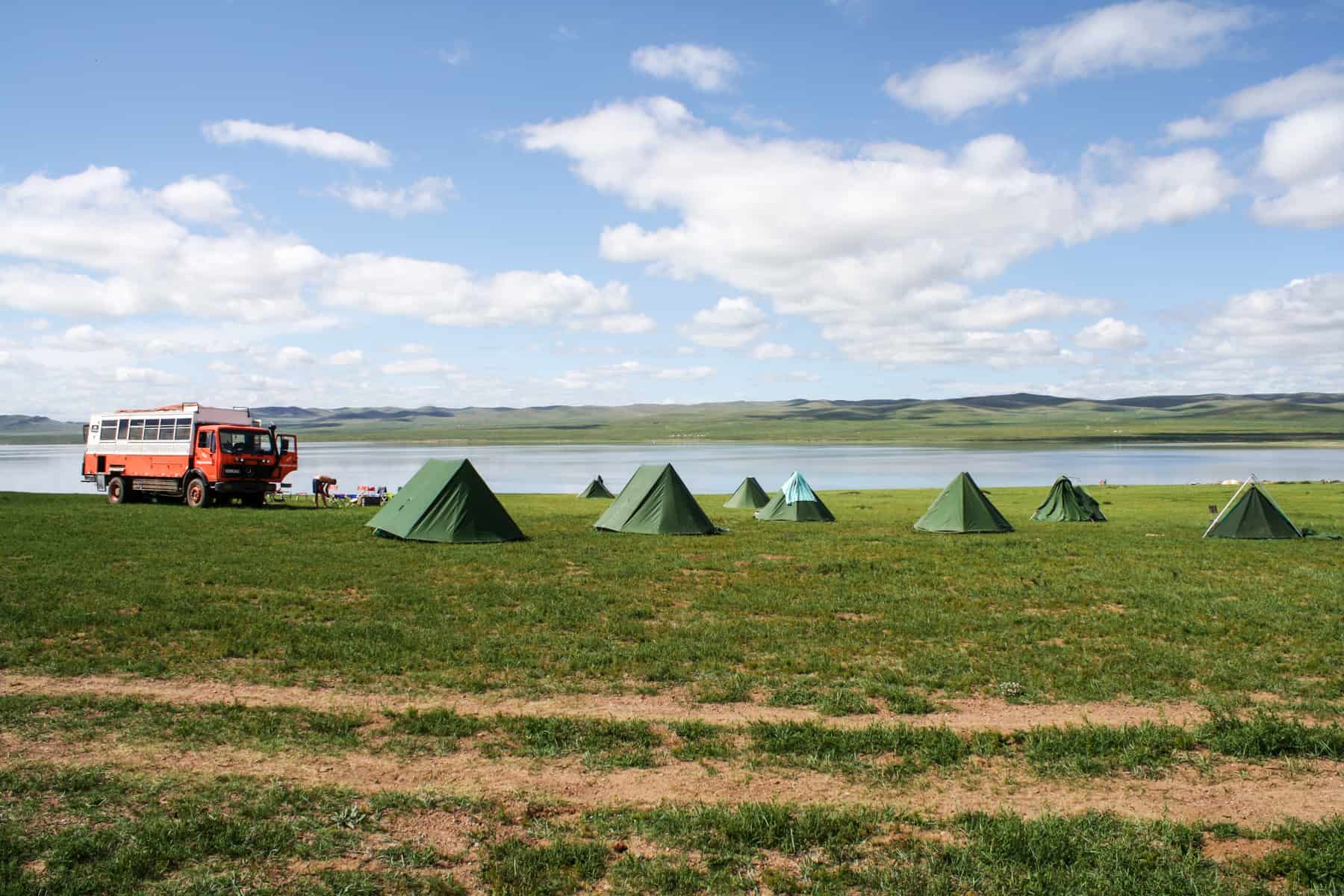
Adventure Travel , Mongolia
This is How to Travel to Mongolia – Overlanding the Least Densely Populated Country in the World
Disclaimer: This post contains affiliate links to handpicked partners, including tours, gear and booking sites. If you click through or buy something via one of them, I may receive a small commission. This is at no extra cost to you and allows this site to keep running.
Want to get to somewhere lesser-known and travel differently? This Mongolia travel guide shows how to go overlanding in the world’s least densely populated country.
Travel to Mongolia means tackling a land of extremes. Both in the landscape, from its vast desert lands and towering dunes to its lush green mountainous national parks, and in its lack of infrastructure, where you become just as frustrated as you are in awe by the country’s areas of extreme isolation.
Visiting Mongolia is to find a canvas of rugged beauty capped by a sky so blue that pollution isn’t even a word that exists here. Passing only wild horses, herds of cattle, an isolated ger in the distance, and the odd truck also on its way to the city, life here is at its purest and most beautiful.
Outside of its unkempt capital, Ulaanbaatar, Mongolia exists with limited facilities, but that’s what makes it attractive. On the road, it can take hours of driving before you pass a small ger community, a Mongolian on horseback or another vehicle, and in between blessed with the most stunning views of a country so desolate that you know you’ve reached the real heart of it.
Overlanding through Mongolia, rather than flying or taking the train, is one of the best decisions I have ever made. This guide will show you how to travel Mongolia from China by land, in a vast loop that takes in some of the country’s most treasured hotspots and wilderness hideaways.
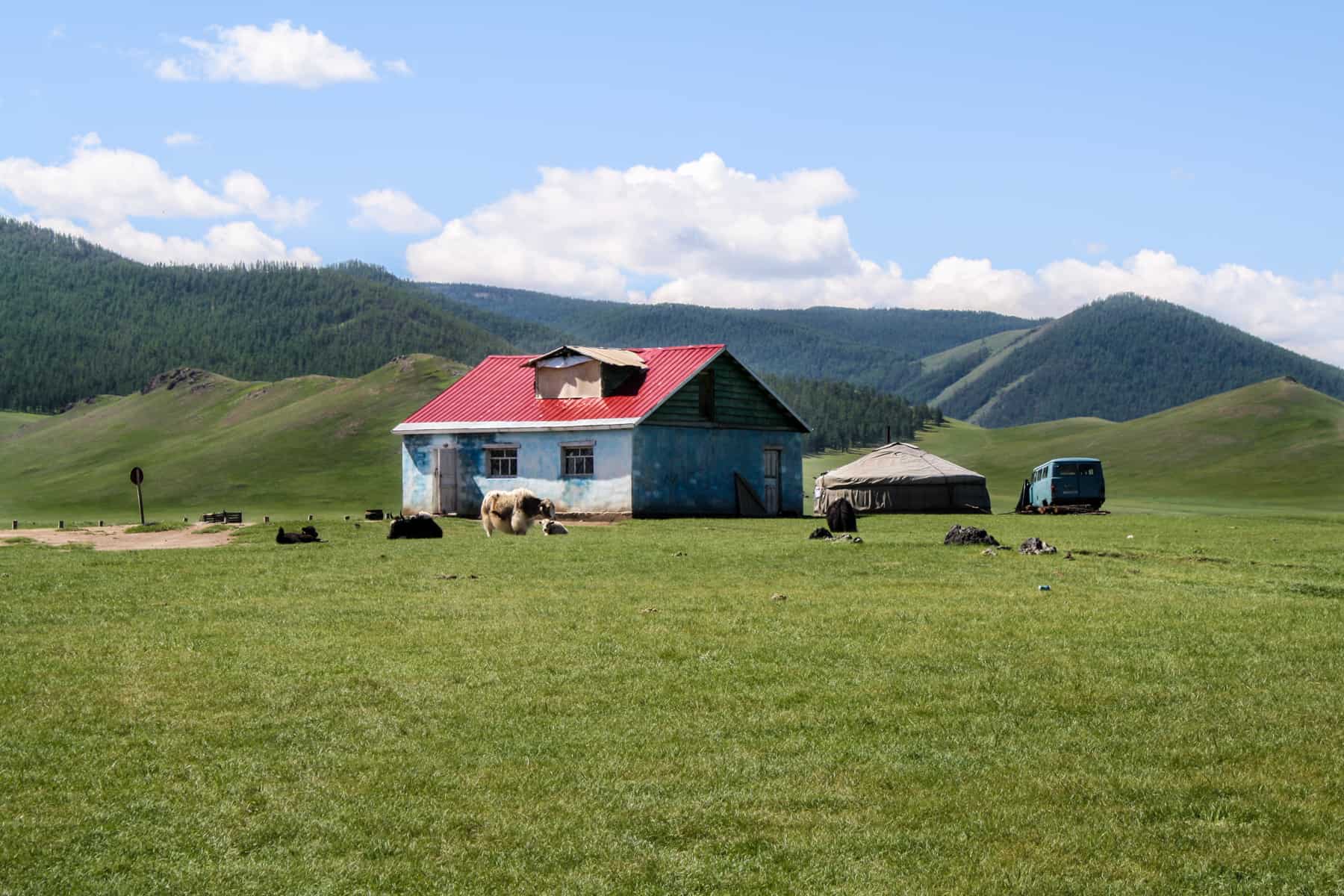
Visit the Least Densely Populated Country in the World
Off the beaten track adventure, when is the best time to go to mongolia, it pays to know a local, classic nomadic mongolia, local living mongolia, discover mongolia – national geographic journeys, experience the naadam festival in mongolia, is mongolia expensive to travel, mongolia visa on arrival, visa-free access to mongolia, day 1: visiting ulaanbaatar, day 2: getting from ulaanbaatar to the gobi desert, day 3: visit the baga gazryn chuluu rock formations, day 4: sleep at a ger camp in the gobi desert, day 5: dalanzagad to gobi discovery ger camp, day 6: hiking in yolin am – mongolia’s ice valley, day 7: a trip to the gobi desert khongoryn els sand dunes, day 8: visiting the bayanzag flaming cliffs, day 9: seeing ongii monastery and driving to arvaikhee, day 10: stuck in mongolia, day 11: hiking in orkhon valley, day 12: seeing the orkhon valley waterfalls, day 13: visiting a mongolian family in a ger, day 14: erdene zuu monastery in kharkhorin, day 15: camping at ugii lake, day 16: visiting hustain national park and seeing przewalski’s horses, day 17: driving to ulaanbaatar and visiting terelj national park, day 18: hiking terelj national park and seeing turtle rock, day 19: a trip to the ghengis khan statue on the tuul river, day 20: back to ulaanbaatar, how to overland in mongolia, building a road in mongolia, getting stuck in the mud, the unexpected river crossing, what to pack for mongolia, planning mongolia travel pin it, why travel to mongolia .
Mongolia travel changes you and makes you appreciate the beautiful patches on the earth’s surface not ruined by extreme modernisation, pollution and overpopulation.
My time in Mongolia meant experiencing everything from bush camping to ger camps, being at one with nature (and not care who sees you squatting in the process) and realising that animals like to roam and Mongolians love to chat – right outside your Ger from 5 am.
I saw a night sky so clear that I didn’t think you could ever see so many stars. I traversed a land so serene in isolation and culture so welcoming that I hope it never, ever becomes ruined by tourist traps or the tight grips of mass capitalism (currently contained to Ulaanbaatar).
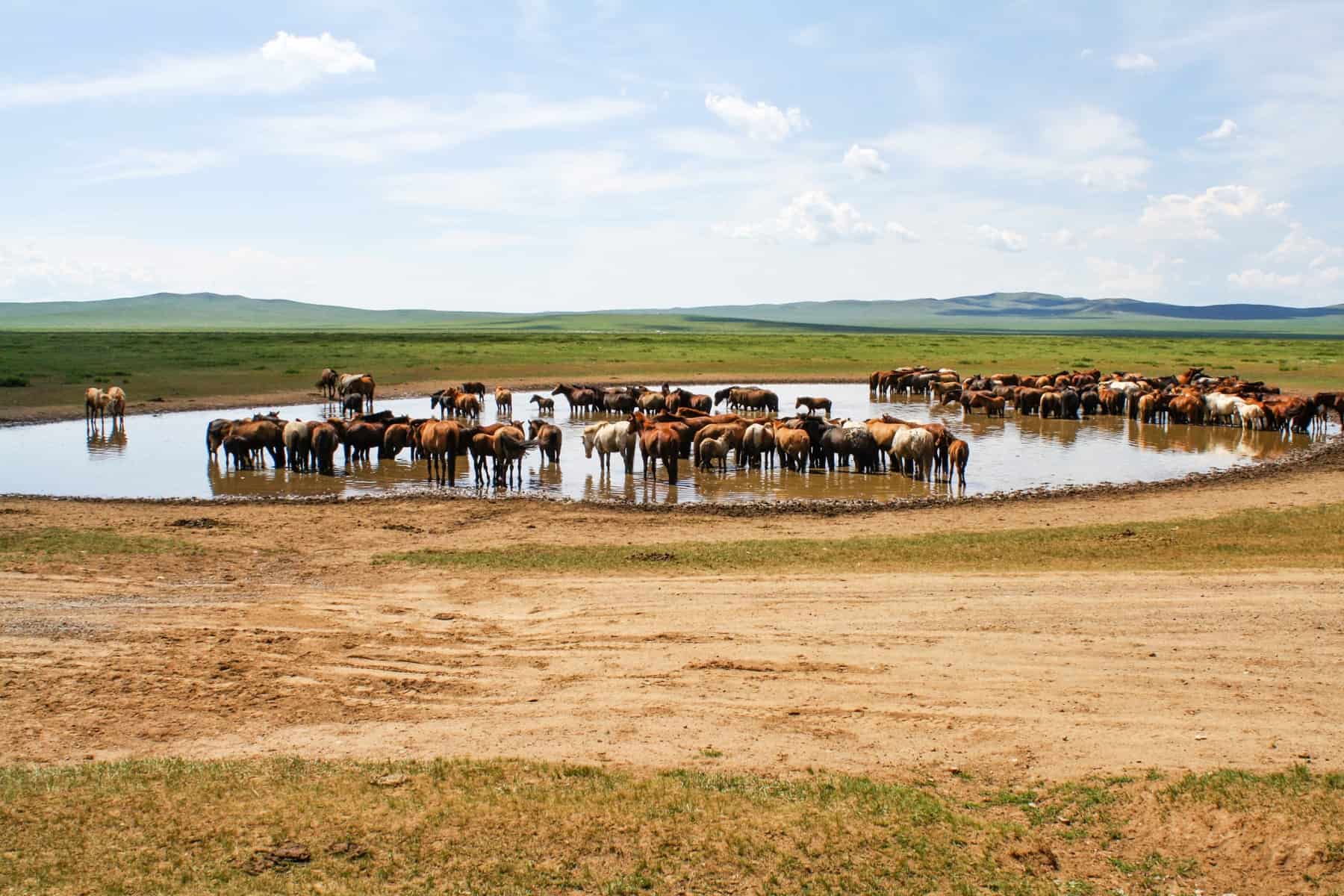
Wild horses in the vast Mongolian landscape
If you want to get off the beaten track, not be on any set grid and take each day as it comes, you will love Mongolia. But this also comes with its frustrations where you need droves of patience and a good chunk of travel time to spare.
There are hardly any roads. Roads are dirt tracks or pre-made grooves in the land pointing the way, and paved highroads are very few and far between.
Mongolia is prone to unpredictable weather conditions. That means random onslaughts of rain and the likelihood that you are likely to get bogged at some point. There were countless numbers of times where we had to dig out and push the truck or find locals to come to the rescue – tractors are a saving grace here.
It’s a vast country that you could get lost in for weeks on end, and when you accept the setbacks, you start to see them as part of the big adventure – travel at its most raw. Back to basics, getting dirty and struggling with the lack of modern amenities we too often take for granted is part of what travelling in Mongolia is all about.
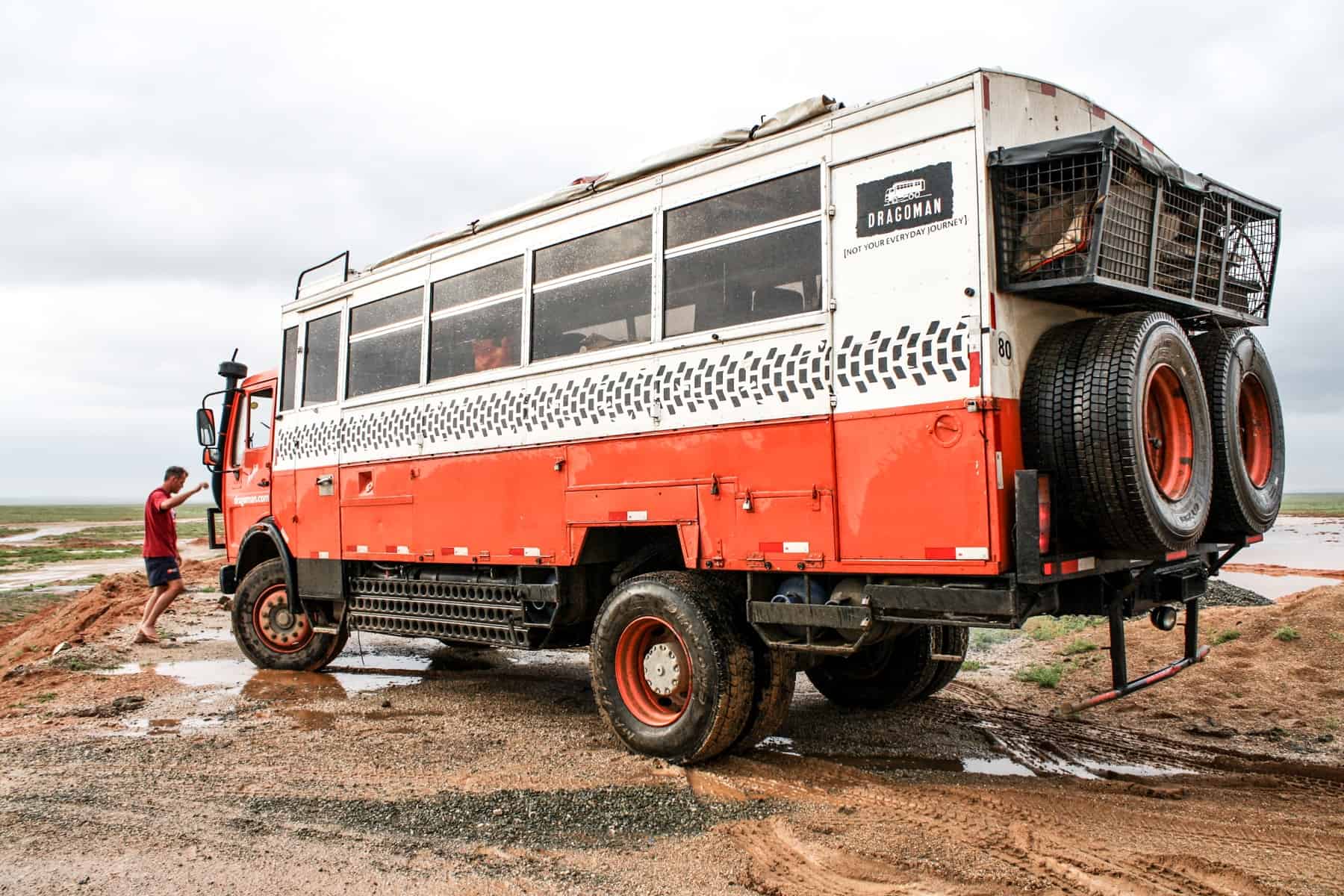
The Overlanding vehicle used to travel to Mongolia and around.
The summer season between May to September is said to be the best time to go to Mongolia. July and August are the hottest months, with temperatures in the Gobi Desert reaching 40°C. Rainfall is at its highest between June and September, balancing out the heat while keeping the forest and valley lands, in particular, lush and fertile. I travelled to Mongolia in July and experienced a lot of rainfall alongside high temperatures.
Mongolia’s winter season is from November to February. While some people like to experience the landscape in this snowy season, temperatures can drop to below minus 20°C – a harsh and challenging environment to travel in. You’ll find that not many companies run tours during this time.
Is it Safe to Travel to Mongolia Safe?
While petty crime and pickpocketing are common in the capital, Ulaanbataar, Mongolia is a relatively safe place to travel, and I never encountered any significant problems. It pays to be more streetwise and alert in the city, as you would in any other. As the landing and departure point for tourists, opportunism poses a higher risk.
Despite the lack of infrastructure and the relative isolation when travelling through the country, the only minor issue we encountered was related to the high levels of alcoholism in the country. We saw drunk drivers on our long drives and an occasion or two when inebriated locals came to our makeshift camp out of curiosity. Even then, it never felt threatening, and we were always within the safety of our group.
On the whole, we rarely saw other people, and when we did, we were met with kindness, invited into homes and welcomed into common spaces such as markets and small-town social spaces.
I also travelled alongside a Mongolian guide – someone who could speak the language when we got stuck, who could walk to a nearby home and explain the need for assistance and who understood the land’s general navigation. Therefore, in Mongolia, it pays to get yourself a local guide, join a small group tour, formulate a small group of your own in Ulaanbataar or be equipped with general wilderness survival skills if going out there entirely on your own.
Mongolia Tours
When I was planning my trip to Mongolia, Dragoman was the only company offering Mongolia tours that lasted from ten days to two weeks. The 21-day overland journey was the first trip itinerary of its kind they were running here, which included Inner Mongolia. Today the 21-day trip, called Nomads & Wilds of Mongolia, is on a loop from Ulaanbaatar and includes Khovsgol Lake in the north. Although Dragoman suspended operations during the pandemic, they are back in 2024.
Adventure travel experts G Adventures, offer Mongolia tours that all start and end in Ulaanbaatar.
A 14-day trip, including all the highlights at an affordable price (from €1999), this Mongolia trip includes a Gobi Desert and Mongolian Grasslands stay, alongside packing in the major historical must-sees and cultural experiences that make Mongolia an unforgettable adventure.
This 10-day local living trip includes staying with three different families in Gers to experience life as a nomad. Mix historical monuments with cultural moments, exploring pastures, forests, lakes and national parks by foot and horseback while helping your host families prepare traditional dinners and learn the skills of their nomadic trades.
G Adventures, in partnership with National Geographic Journeys, offers a two-week comfort adventure through Mongolia . You get to visit Khustai National Park, Karakorum (the ancient capital of Mongolia), Tsenkher Hot Springs, the Orkhon Valley and more. You will also see a nomadic camel-herding family and dive deeper into Mongolia’s culture, as well as support the local community where tourists pass through.
Want to experience the Naadam Festival’s horseracing, archery and wrestling tournaments? This mini adventure takes you to it and throws you right into the buzz of traditional Mongolian festivities.
Mongolia is expensive to travel in and around due to the very nature that it is not overly touristic. Due to the lack of infrastructure, a tour with a local guide and appropriate transport can often be necessary to cover more ground.
- You will need to budget between $2400-$3600 for an extensive trip around the country.
- An average meal (if not making your own on the trip) costs around $5.
- Entrance fees to historic sites and museums average around $2 per ticket.
For those on a budget, day trips can be taken from Ulaanbaatar, or you can try and plan some shorter 3-5 day trips from the city. However, this can often depend on having a minimum amount of people signed up for the trip to run and isn’t always guaranteed.
Do you need a Visa for Mongolia?
If you are not a national of one of the visa-exempt countries listed below, you will need a Mongolia visa.
- A single-entry visa (valid for three months from the date of issue) for up to 30 days – £40/$50
- A double-entry visa (valid for three months from the date of issue) for up to 30 days – £55/$65
It is cheaper to apply directly at a Mongolian Embassy (either at home before you leave or in the country you are travelling in prior). You will need a valid passport, passport photos and supporting trip documents alongside a completed application.
Allow one working week for processing. Some Embassies provide a one-day service for an extra charge.
A 30-day tourist visa on arrival is available for tourists coming from European and other countries where there are no Mongolian Embassies present, obtained at Ulanbataar Airport or the Mongolian land borders. I got my visa in London months before my trip.
The following countries are granted visa-free entry to Mongolia.
Visa-free entry for 90 days: Argentina, Belarus, Brazil, Chile, Kazakhstan, Kyrgyzstan, Serbia, United States (US). Those from Ukraine require a form of invitation.
Visa-free entry for 30 days: Canada, Cuba, Germany, Israel, Japan, Laos, Malaysia, Russia, Singapore, Turkey, Thailand, Uruguay.
Visa-free entry for 21 days: Philippines.
Visa-free entry for 14 days: Hong Kong.
You can find further information on the Embassy of Mongolia website .
Where to Go in Mongolia – Itinerary
I spent 20 days Overlanding in and across the central and western Mongolian plains. We travelled in a big clockwise circle from Ulaanbaatar, through the scorching Gobi Desert to beautiful lakes, forests, canyons and waterfalls, all the while passing vast herds of wild horses, camels, goats, yaks and cows.
Overlanding in Mongolia for Three Weeks:
Kilometres travelled: 2492
Number of significant times the truck got stuck: 2
Number of minor times the truck got stuck: 12
Number of incredible driving days: 15
We spent a full day in Ulaanbaatar exploring outside of the stark Soviet communist-style architecture and moving past the city’s general dodgy feeling. There’s plenty to see and do here, including a walk through the modern Sukhbaatar (Parliament) Square, the Gandan Monastery, the National History Museum and the shopping paradise of the Black Market . In the evening, check out the singing, dancing and contortion talent at the Cultural Show before hitting a few bars and pubs. There’s so many you won’t know where to start.
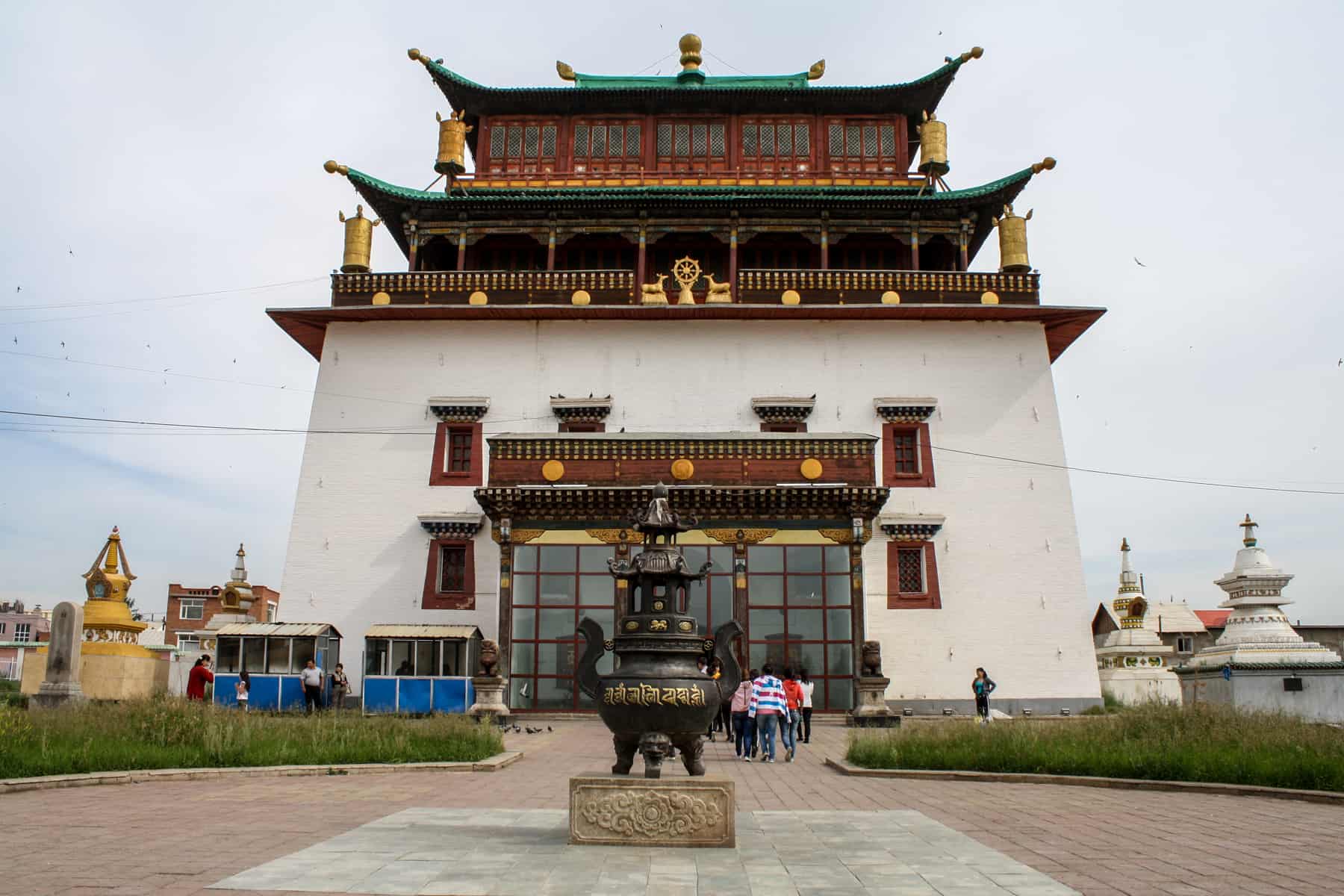
Gandan Monastery in Ulaanbaatar, Mongolia
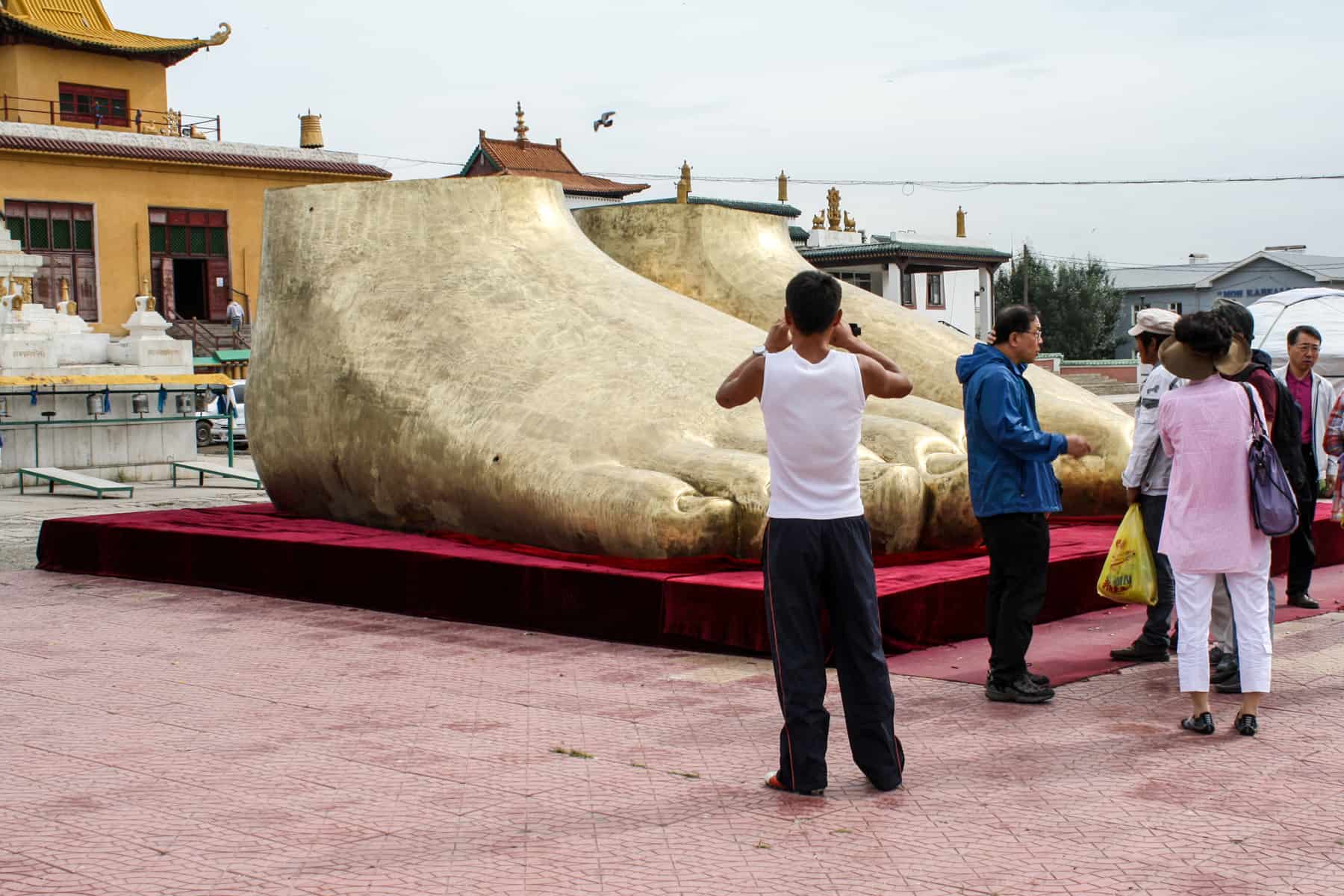
The golden feet outside the Gandan Monastery Ulaanbaatar
We set off in the truck from Ulaanbaatar to drive to the Baga Gazryn Chuluu rock formations in the Gobi desert. Due to heavy traffic when getting out of the city and general road conditions we got delayed and so decided to set up bush camp for the evening. Be prepared for delays in Mongolia but delight in being the only people in the area. All the space is yours.
We got to Baga Gazryn Chuluu – rock formations worshipped by locals who make pilgrimages here partly because legend states that Ghengis Khan camped here – before journeying to the Gobi Desert.
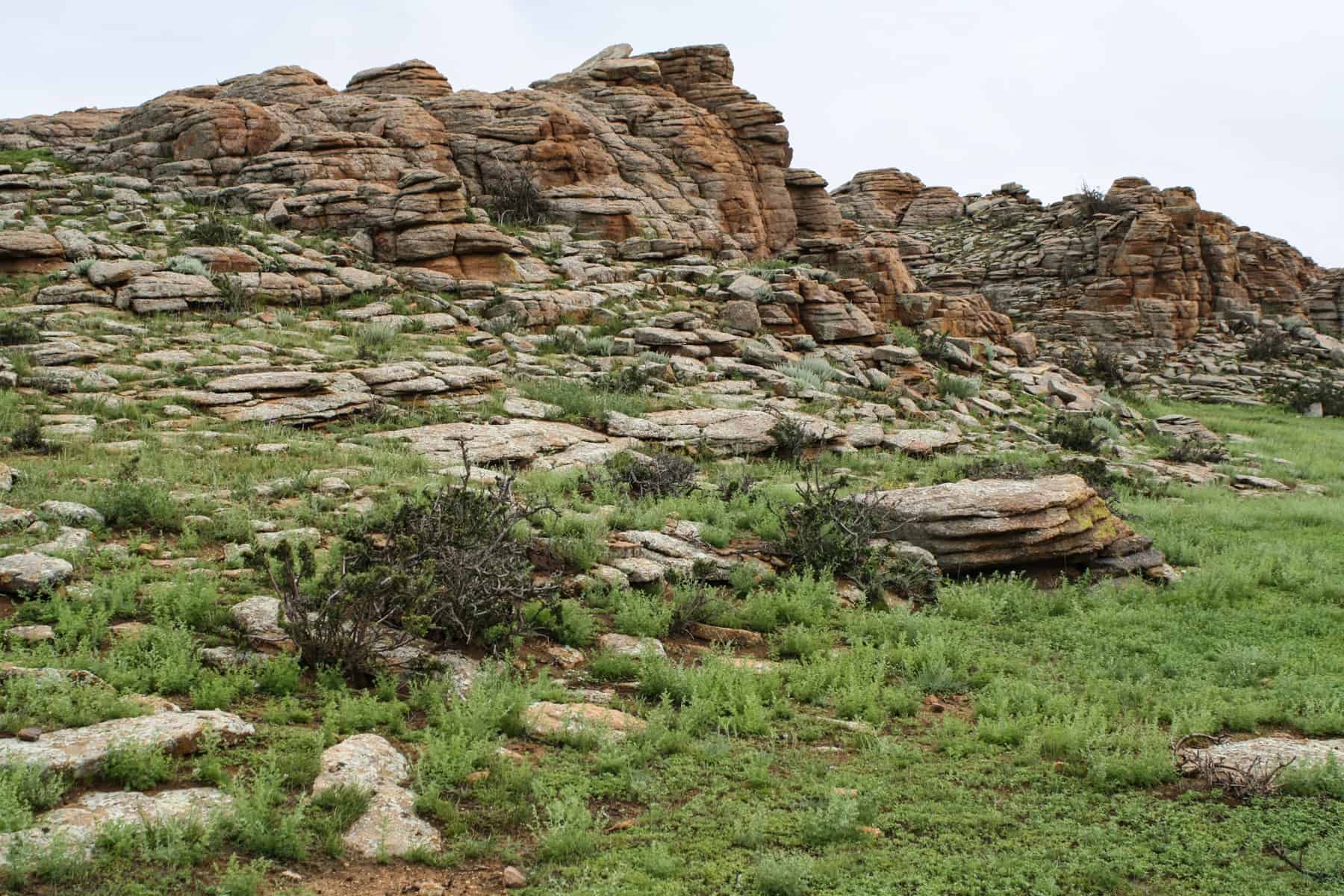
Layers of Baga Gazryn Chuluu rock formations in Mongolia
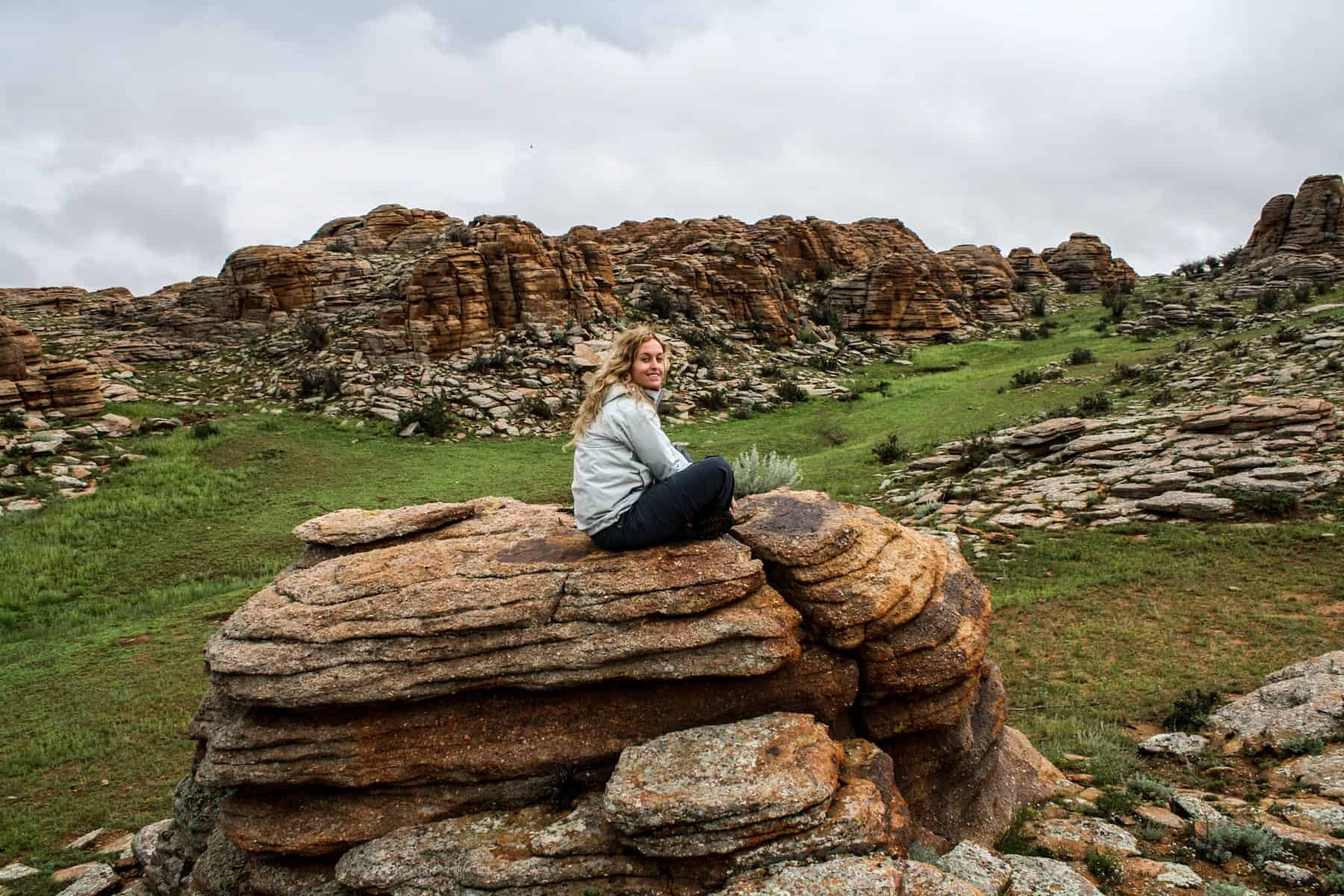
A hike to Baga Gazryn Chuluu as part of a Mongolia travel itinerary
On the way, we got to experience the famous Nadaam Festival when we passed through the local town of Mandal Govi . It was full of wrestling, horse racing, archery and fairground style fun. Nadaam means ‘games’, and the buzz was all around us as the only Westerners there. It was great to be a part of a traditional Mongolian community celebration, even if the afternoon was marred by a bogging, which resulted in the truck not being released from the soft mud until midnight.
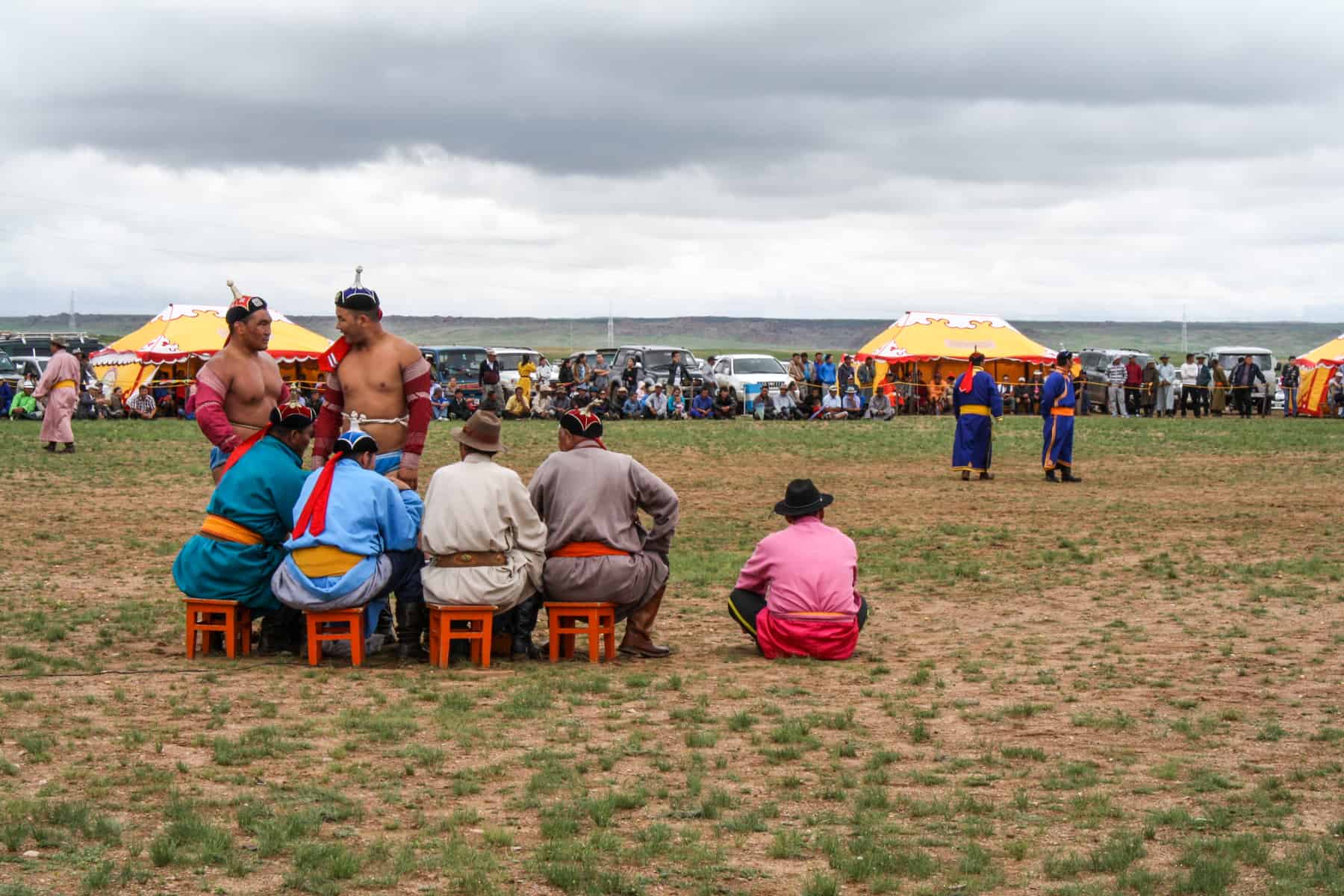
Watching the wrestling at the Nadaam Festival in Mongolia
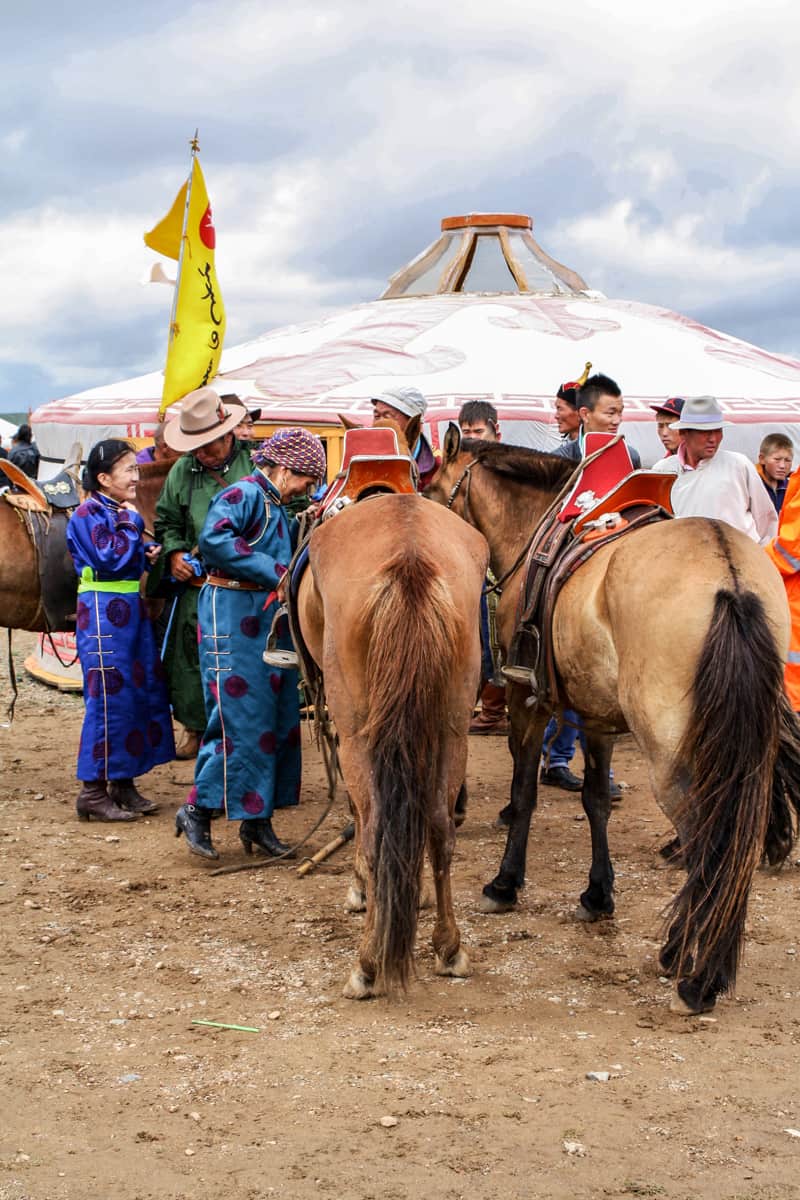
Mongolian locals enjoy the Nadaam Festival.
The plan was to get to our first ger camp, but after approximately 30 kilometres, we encountered a large ditch of water on the road. It resulted in us having to drain the water by hand and build a road and a dam for most of the afternoon to help us get across. Although this sounds horrendous, it created a great sense of camaraderie and, ultimately, an immense sense of achievement. We got to camp on a high point of the Gobi Desert instead near the town of Tsogoovi .
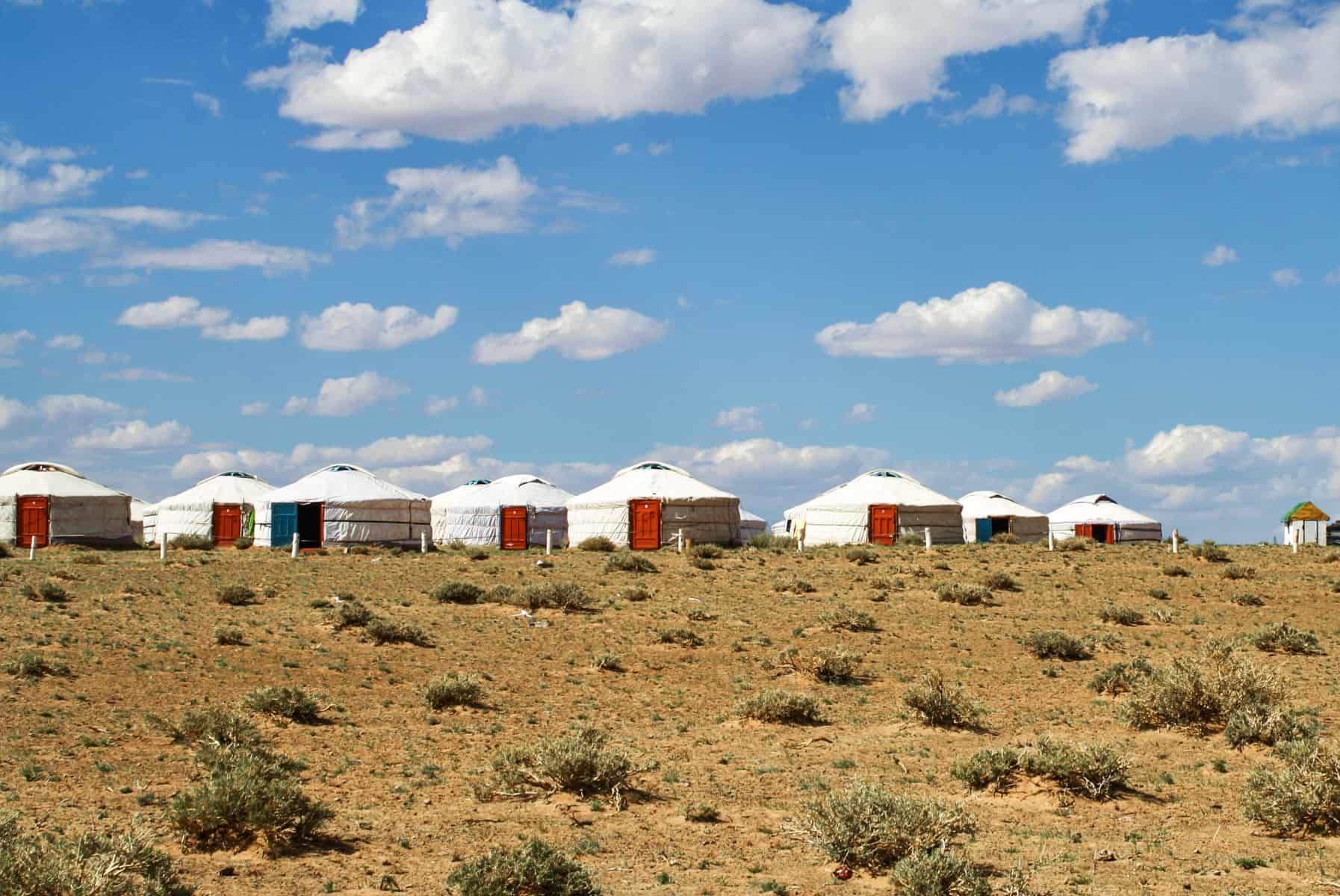
A Ger Camp on a hilltop in the Gobi Desert, Mongolia
We began our journey without a hitch to the ger Camp called Gobi Discovery, stopping at the town of Dalanzagad on the way. Mongolian towns are typically tiny and compact settlements that are reasonably large but without the ruin of a city like Ulaanbaatar.
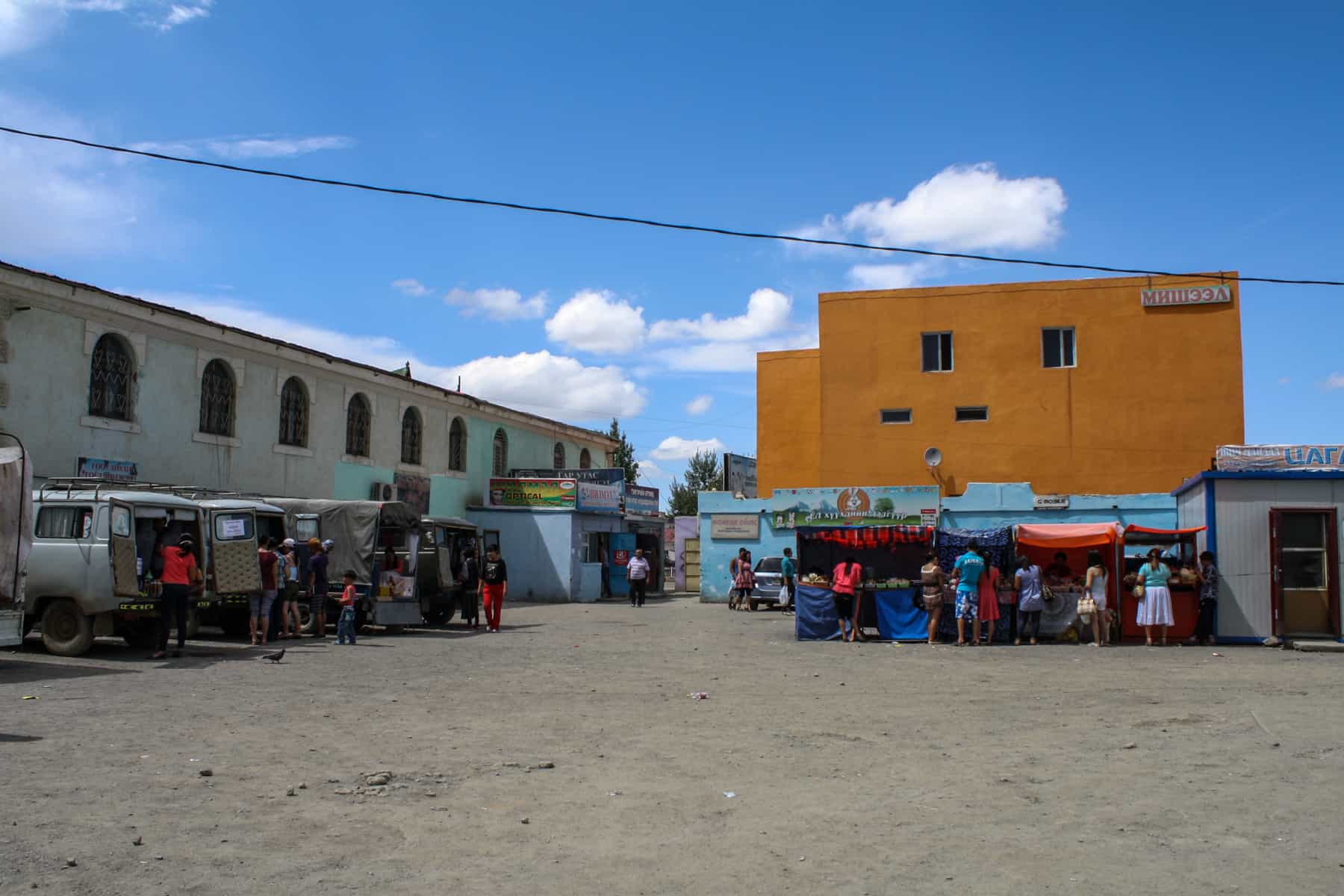
Market time in the town of Dalanzagad, Mongolia
We hiked in Yolin Am , a beautiful canyon in the Gobi, an ice valley, which hosts a colossal glacier all year round. The hike was spectacular, but, unfortunately for us, little of the iceberg remained, although we had lots of fun playing with what little ice there was regardless.
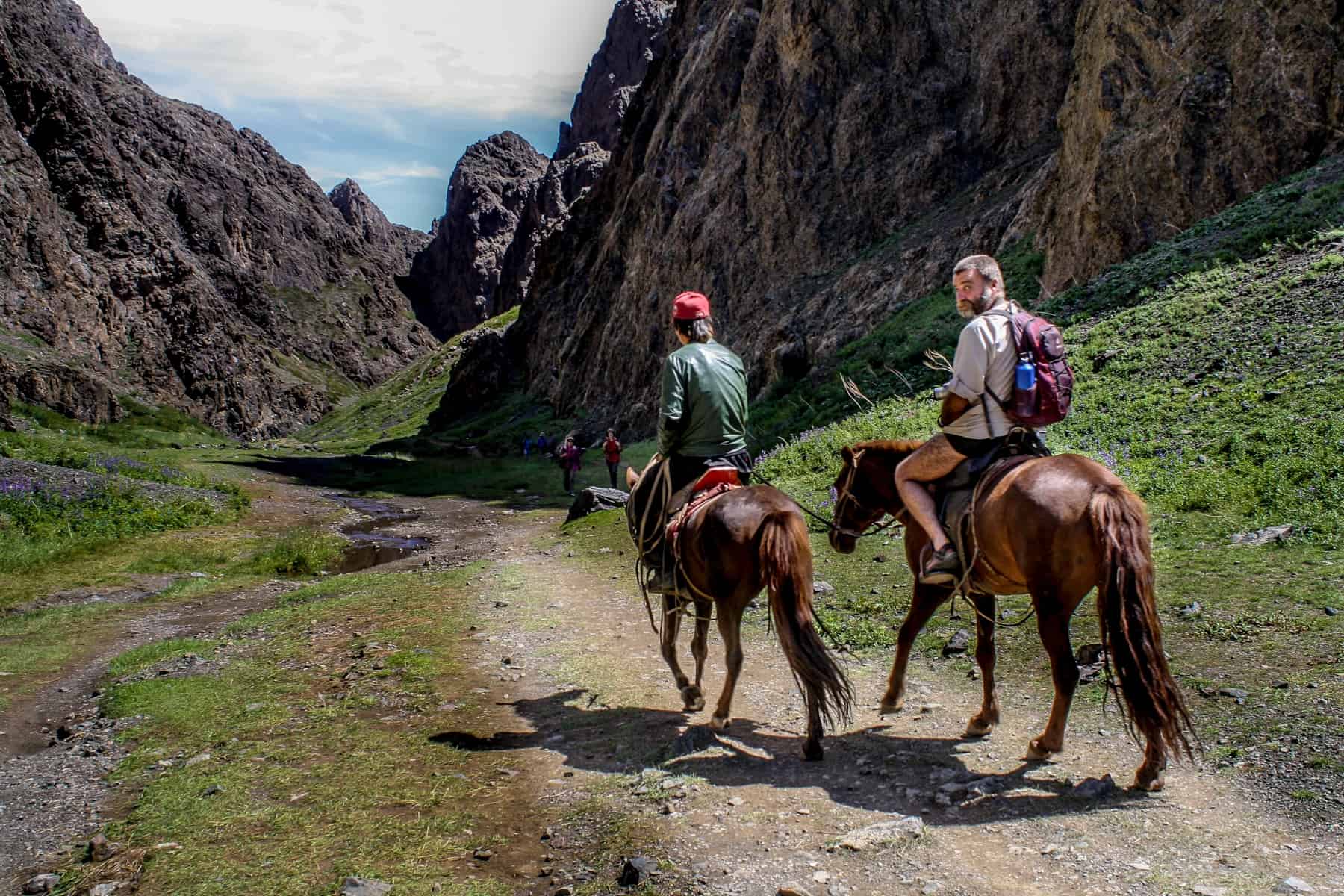
Hike or horseback in the Yolin Am Valley in Mongolia
Many sandy riverbed crossings eventually led us to our second Ger camp, Khongoryn Els Ger Camp. Here, you only have to open your ger door to be greeted with a breathtaking view of the Gobi and the Khongoryn Els Sand Dunes , which I later climbed, drank beer on and ran down. That was after a camel ride, of course.
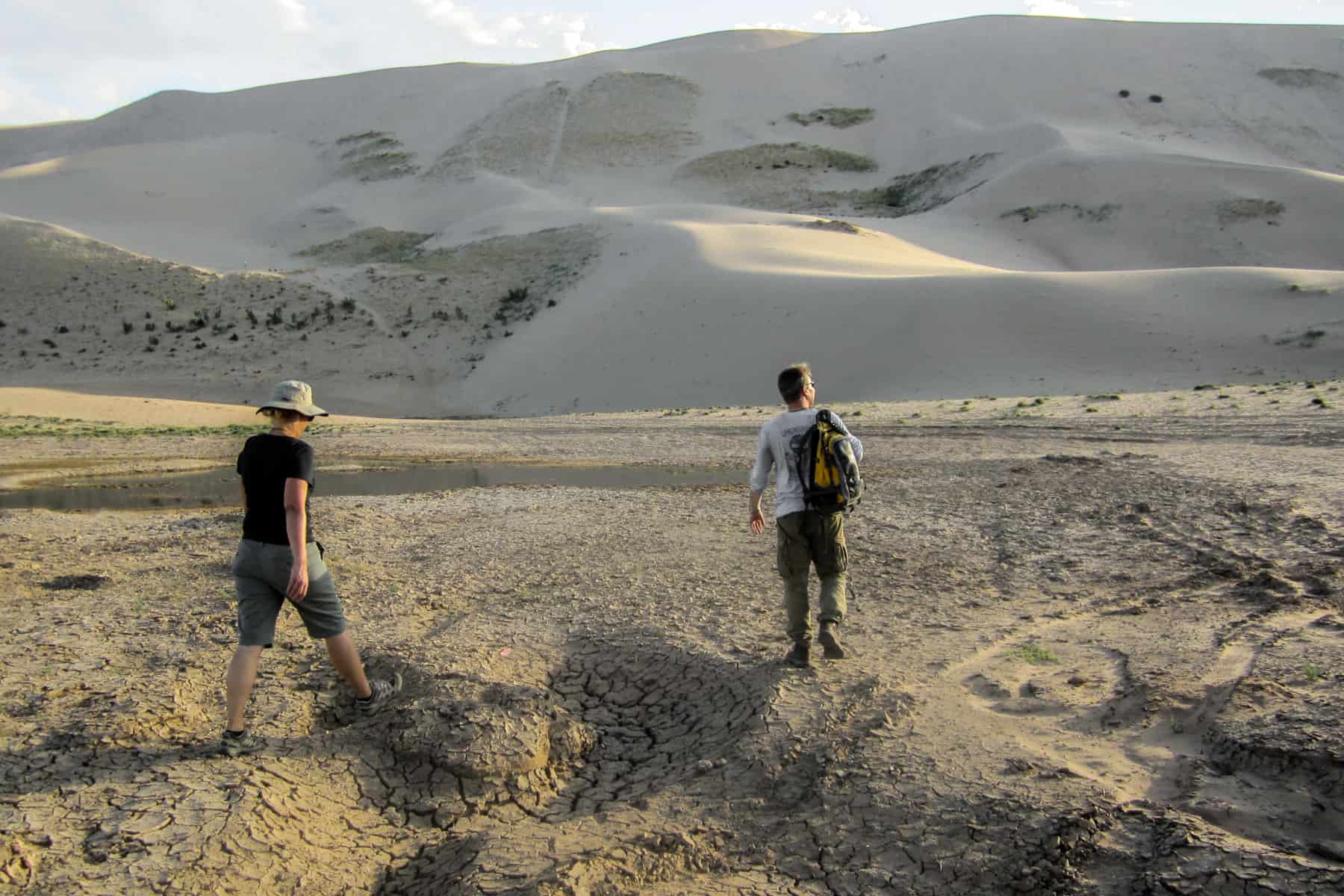
The glorious Gobi Desert Khongoryn Els Sand Dunes
Bumpy mountain roads took us to the spectacular Bayanzag Flaming Cliffs , which are a Mongolian version of the Grand Canyon, but smaller. It’s a significant site that unearthed many dinosaur fossils and eggs, and it is also a stunning backdrop for bush camping.
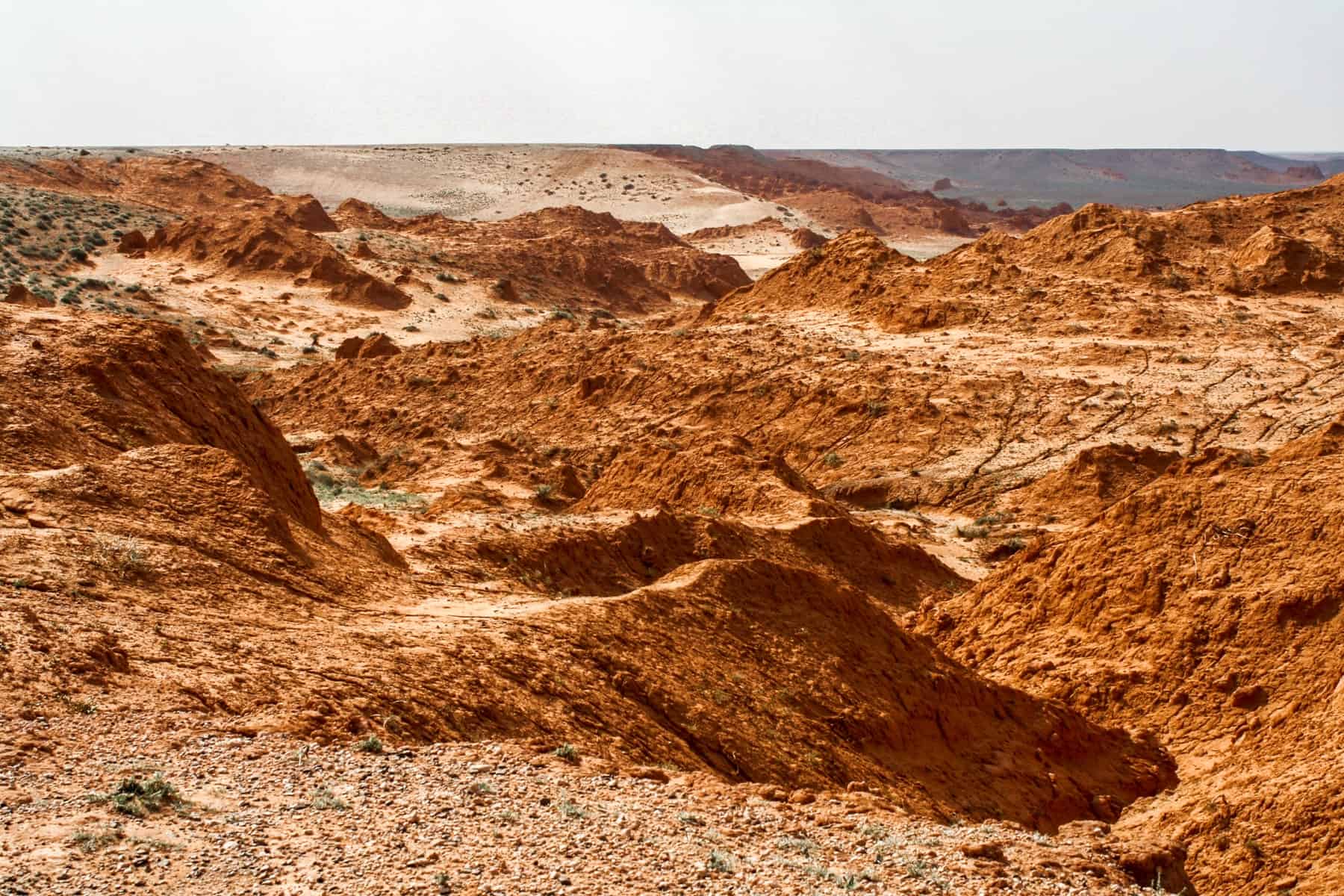
The blazing ochre colours of Mongolia’s Bayanzag Flaming Cliffs
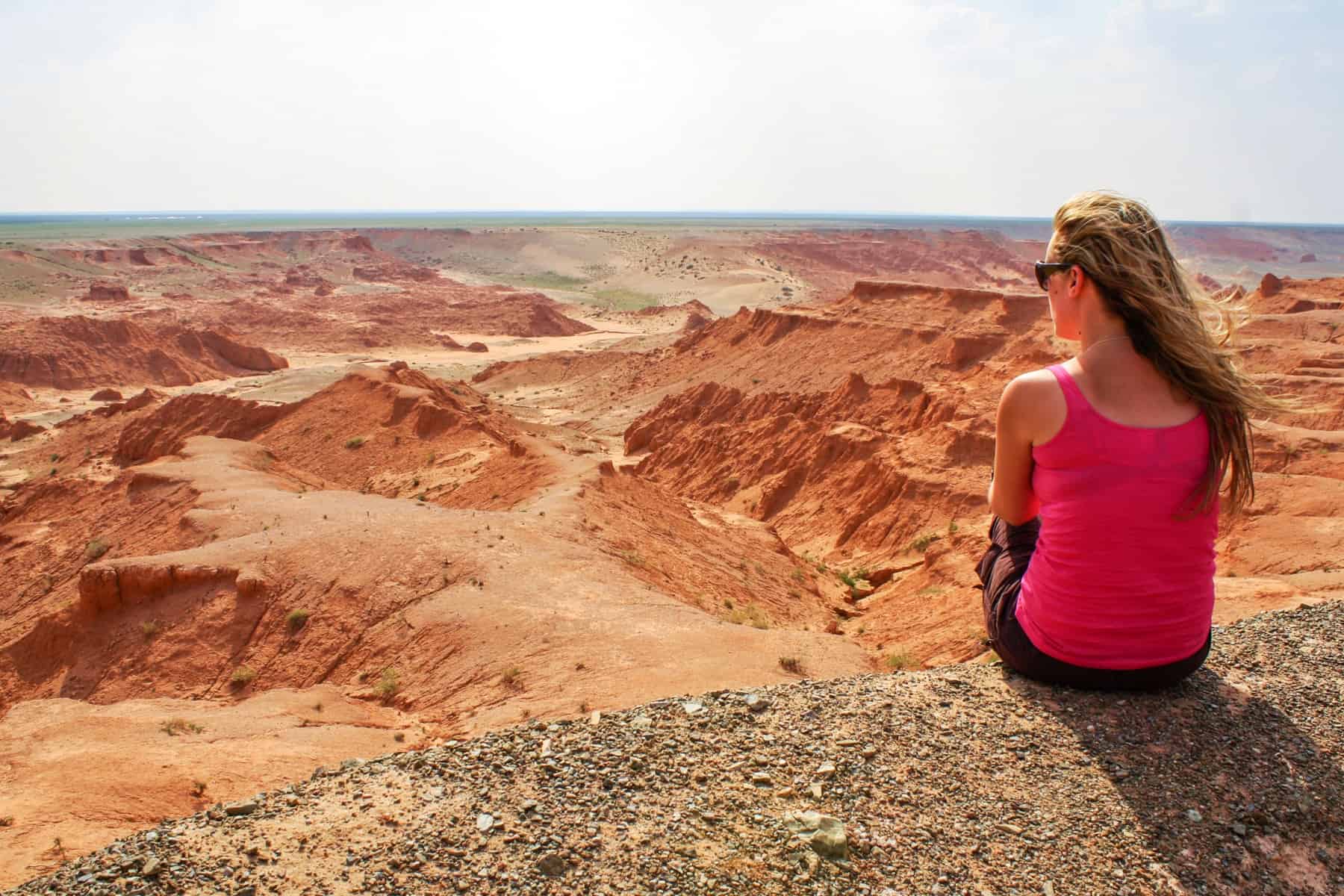
Marvel the mars-like landscape of Bayanzag Flaming Cliffs when you travel to Mongolia
When the communists invaded Mongolia in the 1930s (known as the Purges), nearly all Monasteries were destroyed. Ongii Monastery was one of them, and we visited the ruins here before driving to Arvaikheer, where heavy rain forced us into a hotel for the night. At times, random bad weather makes bush camping in Mongolia impossible, so it is essential to prepare for a budget recount at any given time.
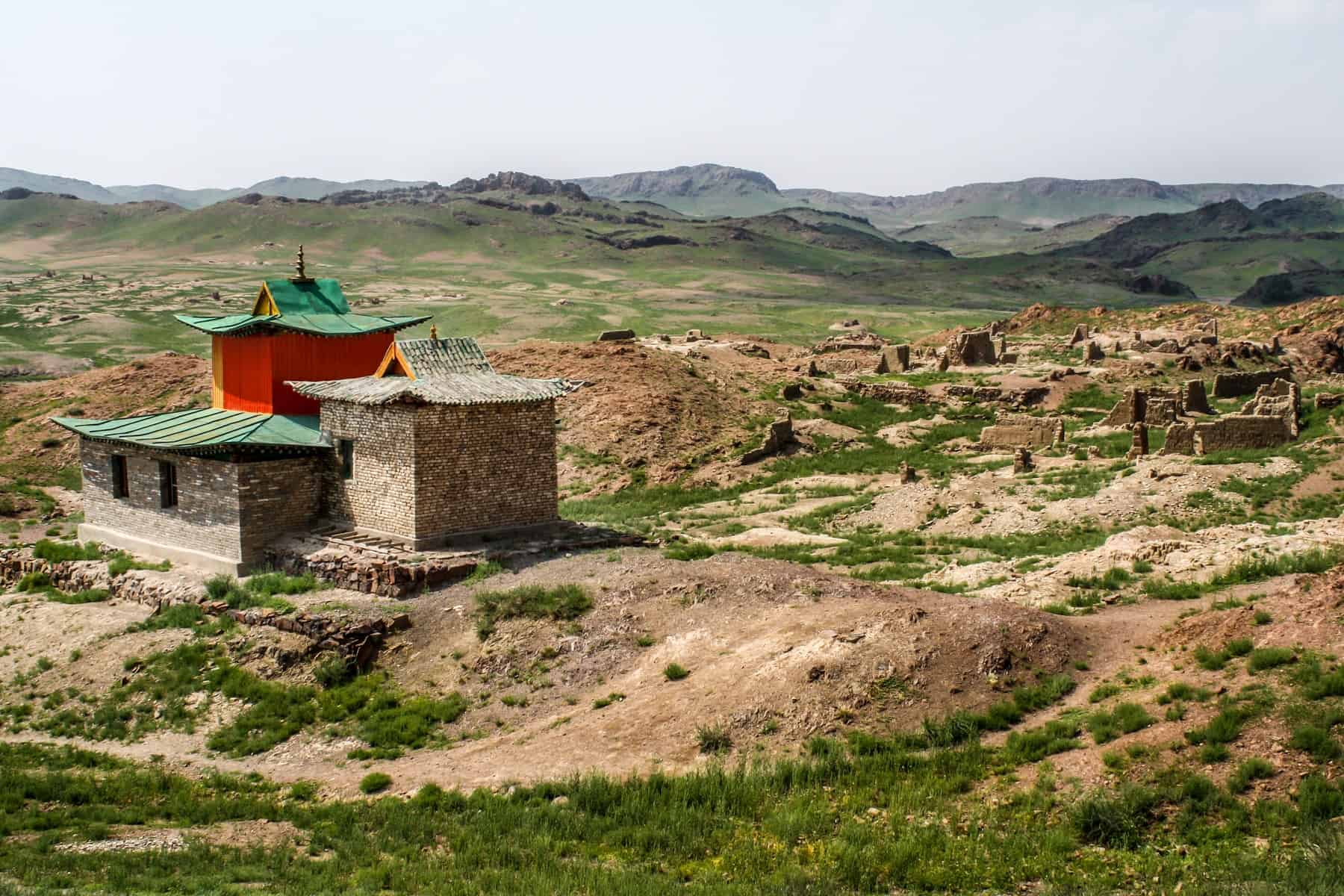
The site of the Ongii Monastery in Mongolia
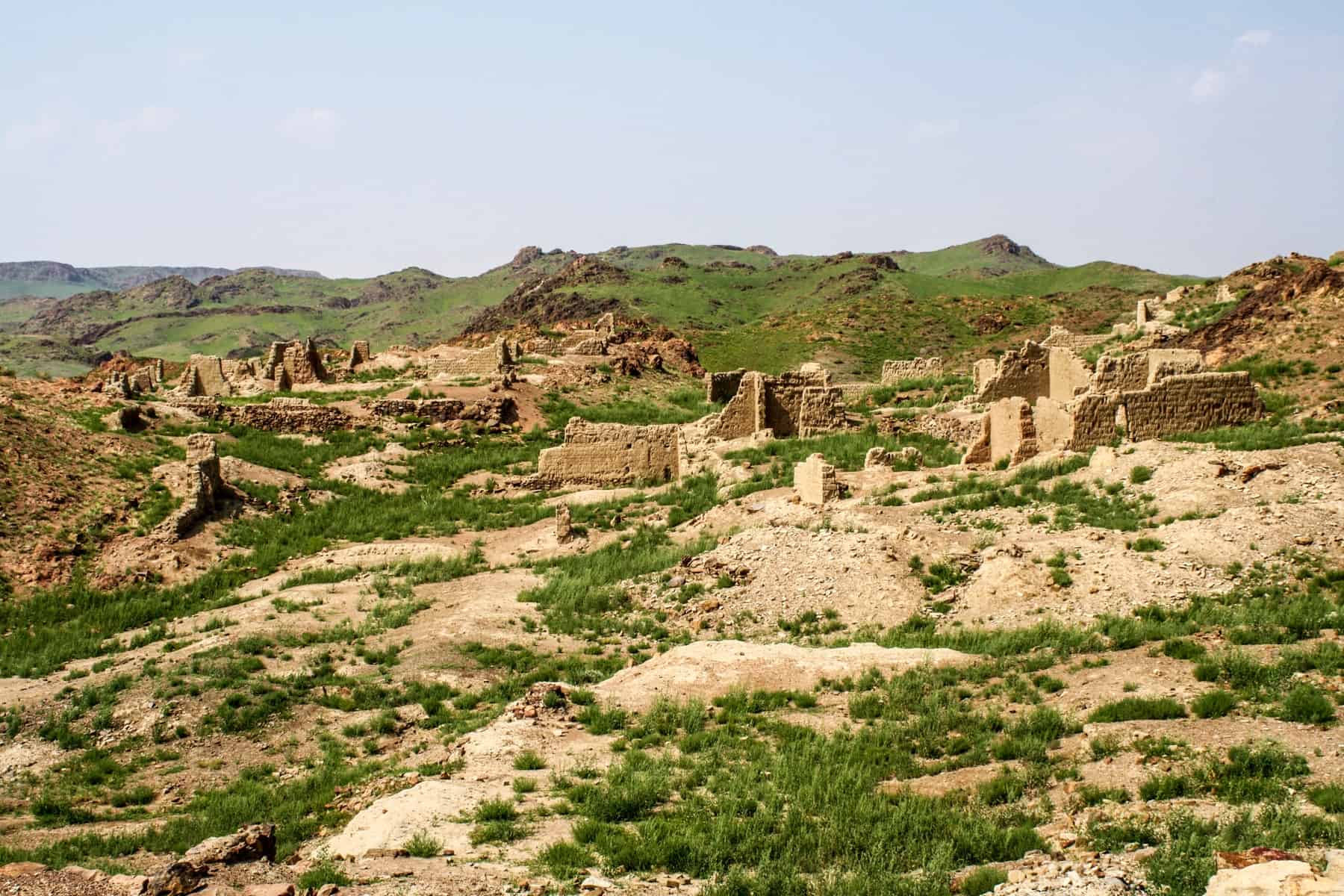
The scattered stone ruins of Ongii Monastery in Mongolia
We began our journey to the third ger camp but got badly bogged around midday after the truck had to swerve slightly, of course, to miss a drunk driver who came in our path (sadly, a lot of people drink and drive here). It took over five hours to get out, with the help of a small local tractor, and during that time, a few of us who remained to help with the truck (local jeeps rescued a few) lost our minds. It was a hilarious few hours that would have made an excellent documentary, probably how a Lord of the Flies scenario starts.
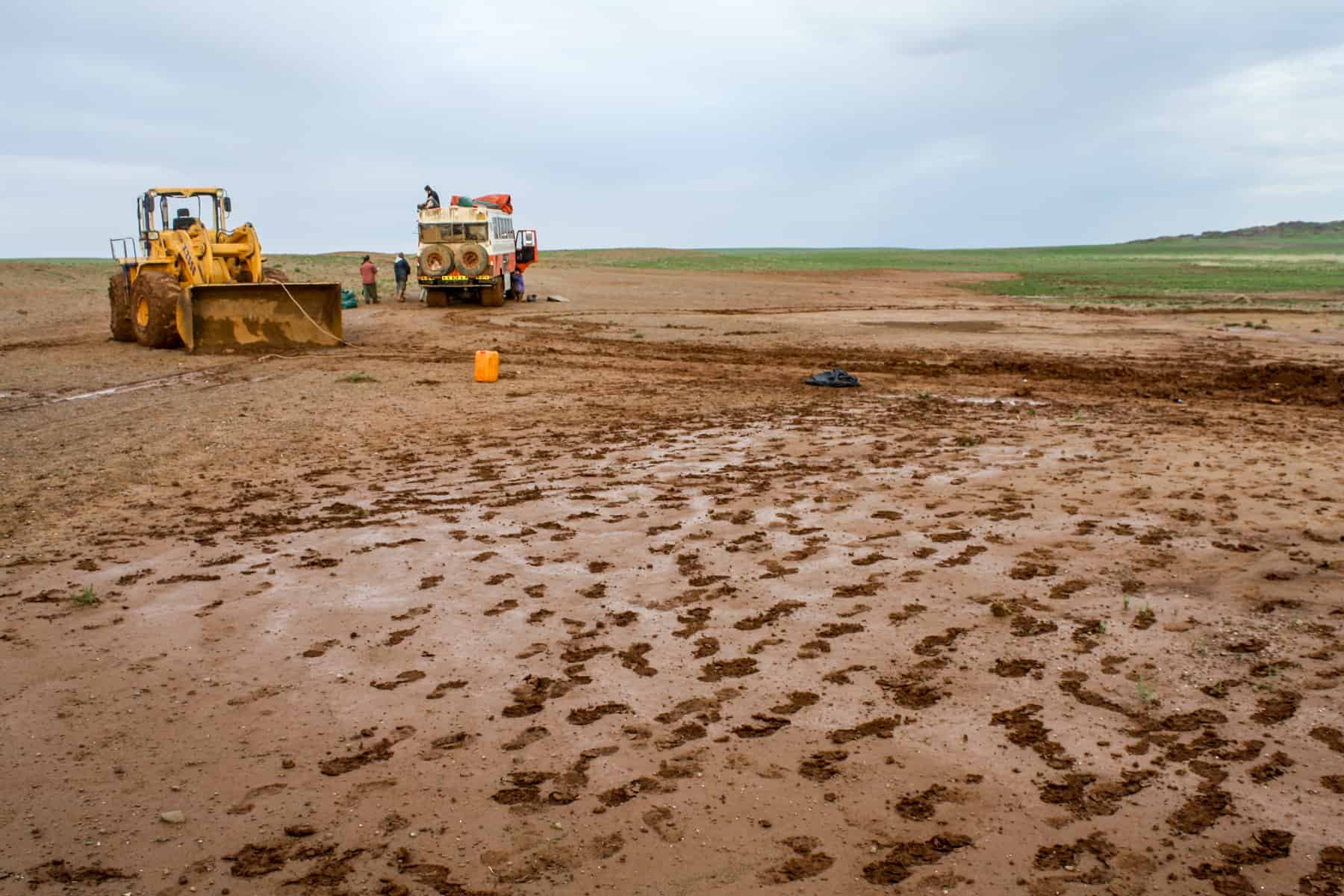
Tractors help pull the Overlanding truck out of the sticky mud in Mongolia’s rural landscape.
The roads were not rigid and stable enough for the truck to continue, especially with all the hills. After setting up tents and cooking dinner, two small vans came to the rescue to take us on our two-hour journey to the Ger Camp. It was a scary ride in the dark, where we stopped at the driver’s backyard and where a small boy jumped into the hold of the van for the rest of the journey.
I highly recommend staying in a ger camp in the beautiful Orkhon Valley . There’s nothing like a pleasant hike through the beautiful forest to reach the Tuvkhon Monastery and see the surrounding area. Pure bliss.
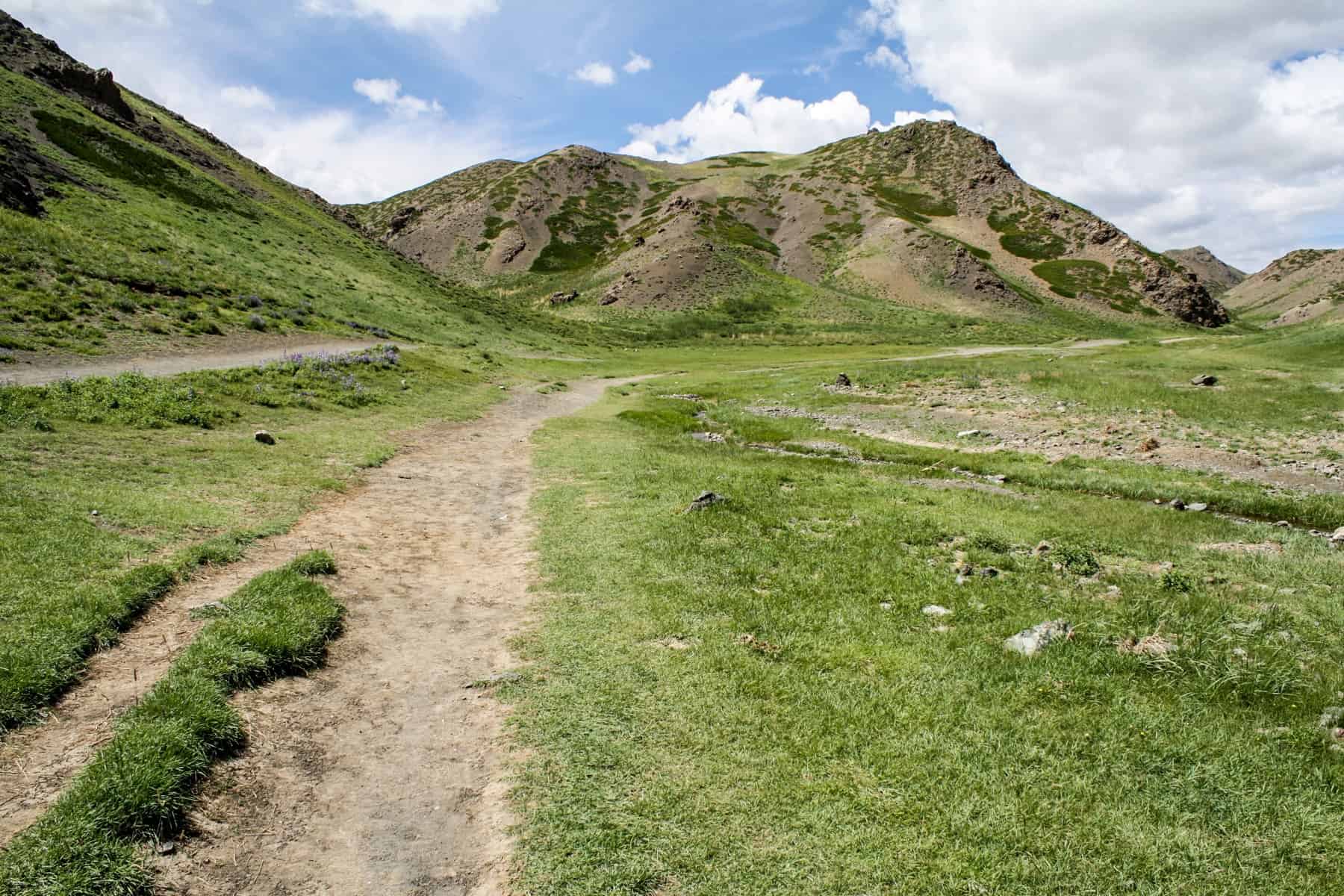
The lush green leading to the soft peaks in the Orkhon Valley Mongolia
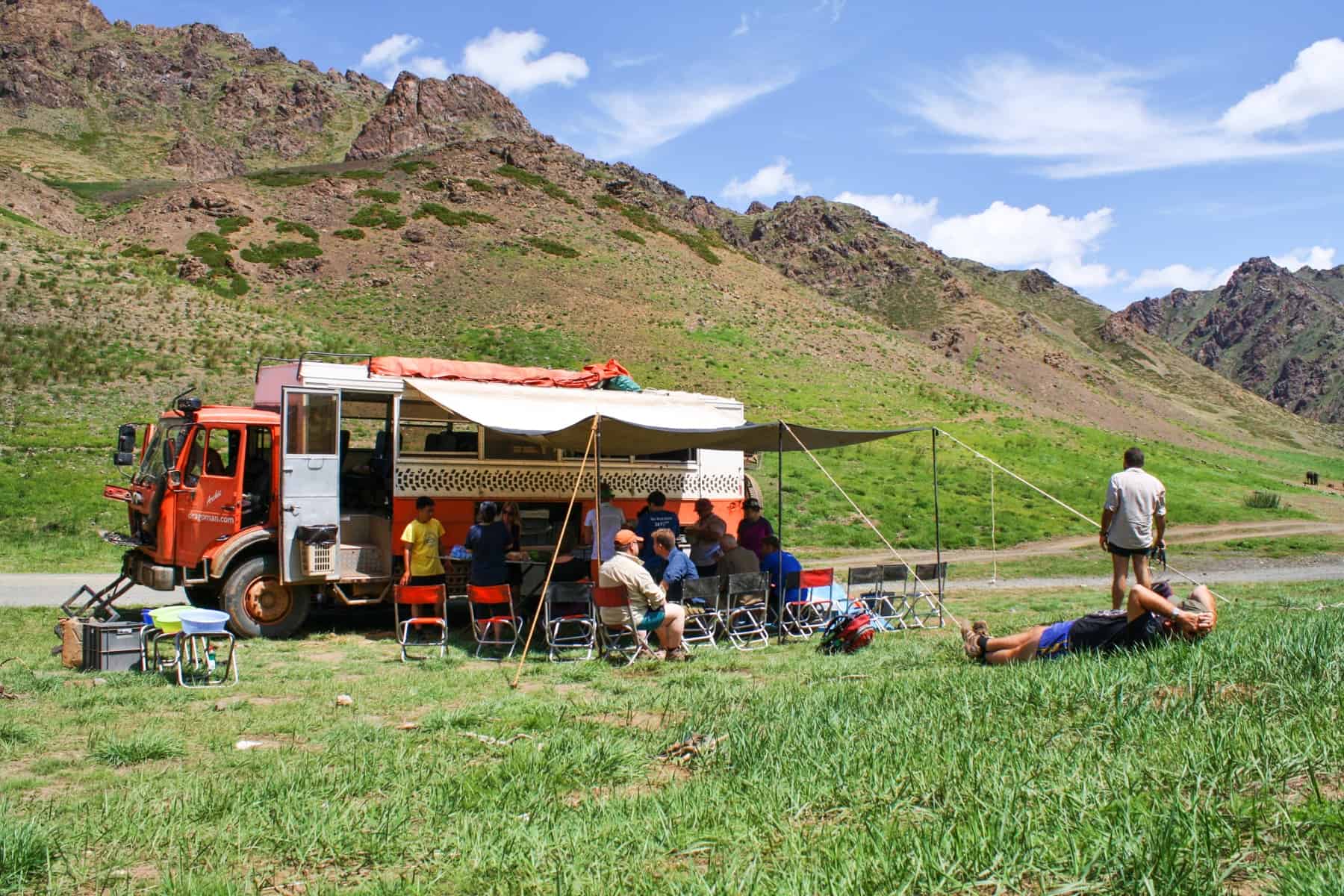
A rest stop in the scenic Orkhon Valley landscape
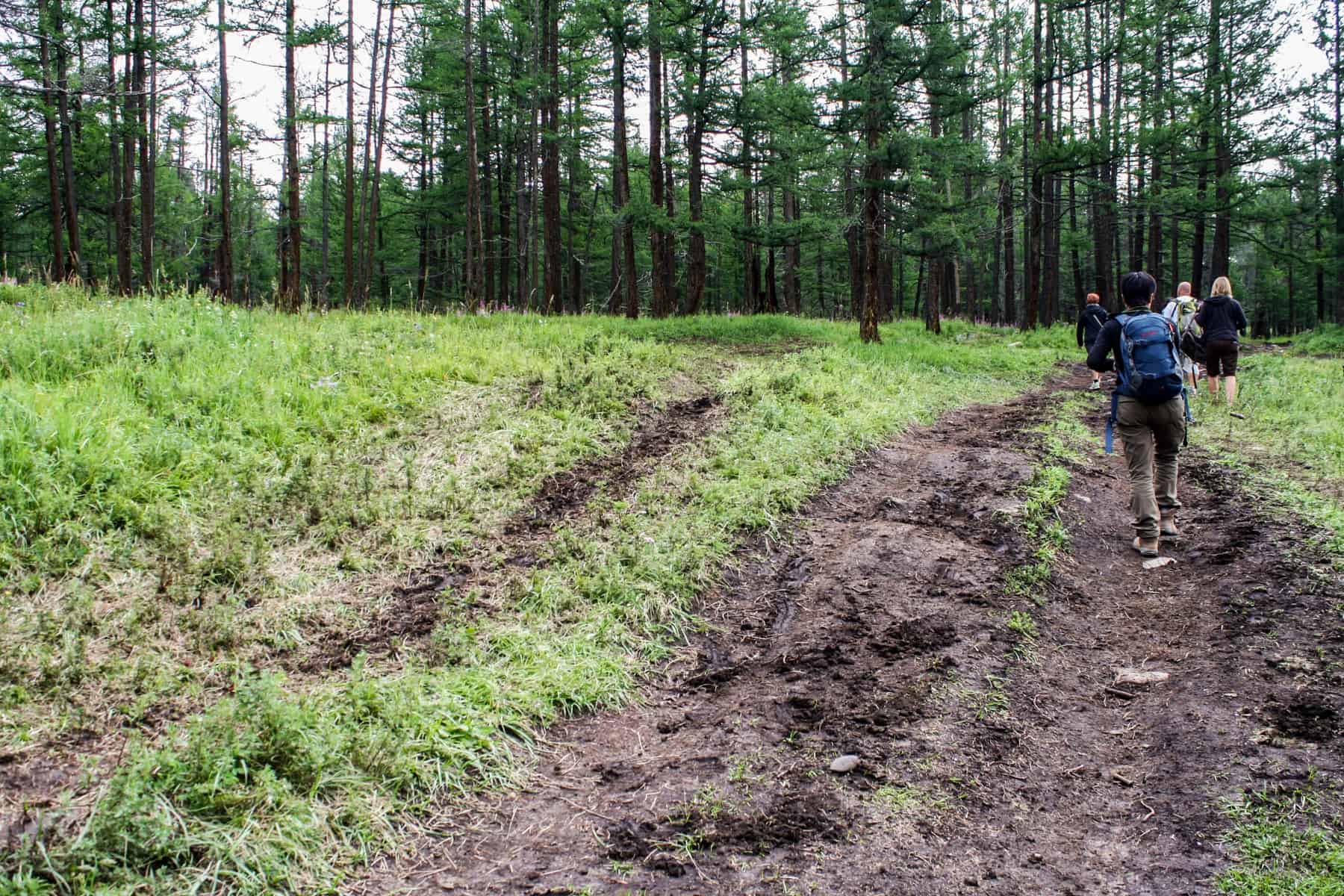
Hiking the forest trails of Mongolia’s Orkhon Valley

The rocky plateau that surrounds the Tövkhön Monastery in Mongolia

The colourful entrance to the Tövkhön Monastery
The Orkhon Valley waterfall was the next stop on our five-hour drive to the next ger camp. This camp plays host to the famous hot springs in the region, where we went skinny dipping and enjoyed a few refreshing beers.
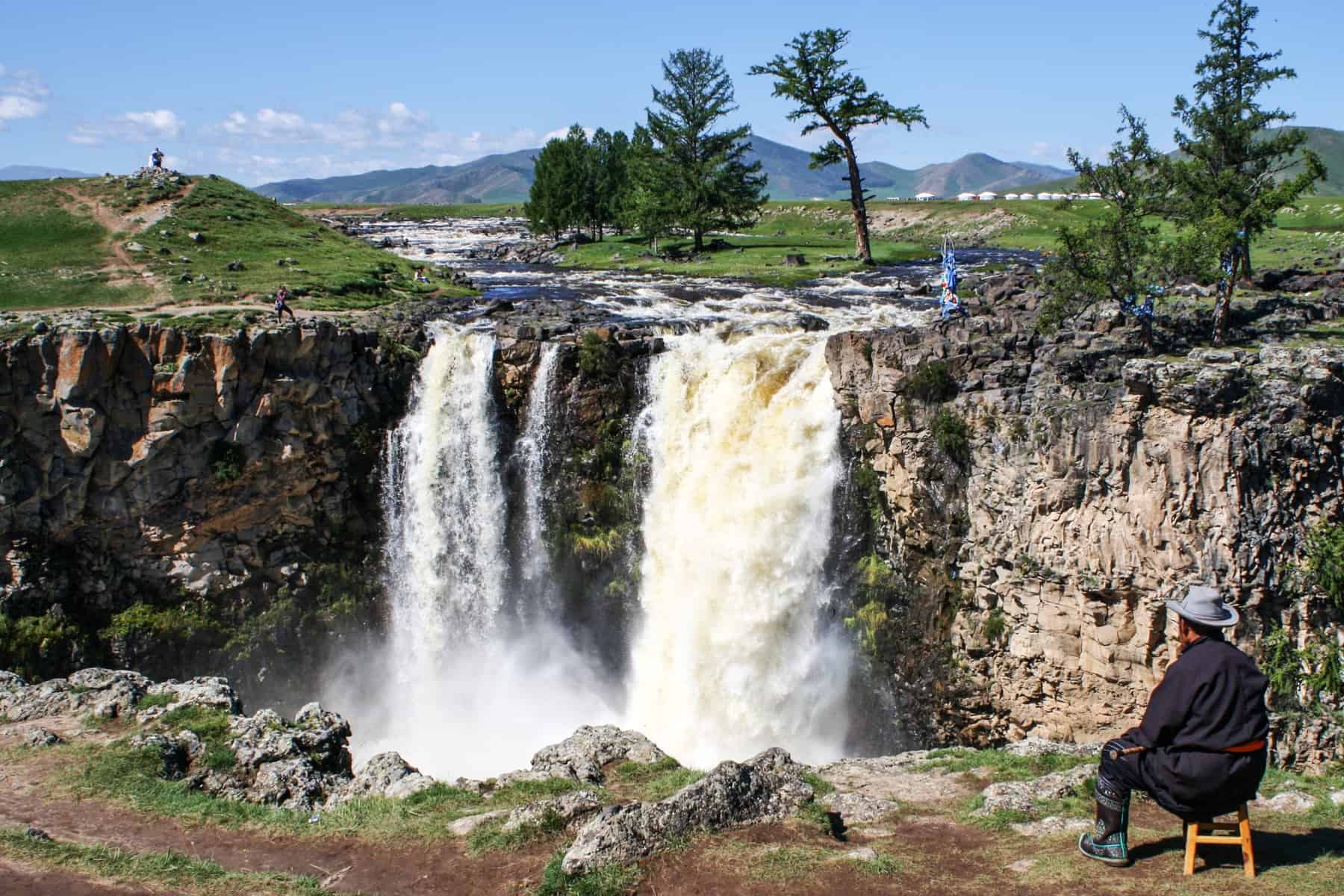
A Mongolian man sits in a chair peacefully enjoying the backdrop of the Orkhon Valley Waterfalls in Mongolia.
Fully clothed, of course, we took a short hike through the lush green forest to visit the source of the hot springs. When you come across your first sighting of trees after two weeks of barren land, you begin to appreciate such incredible surroundings.
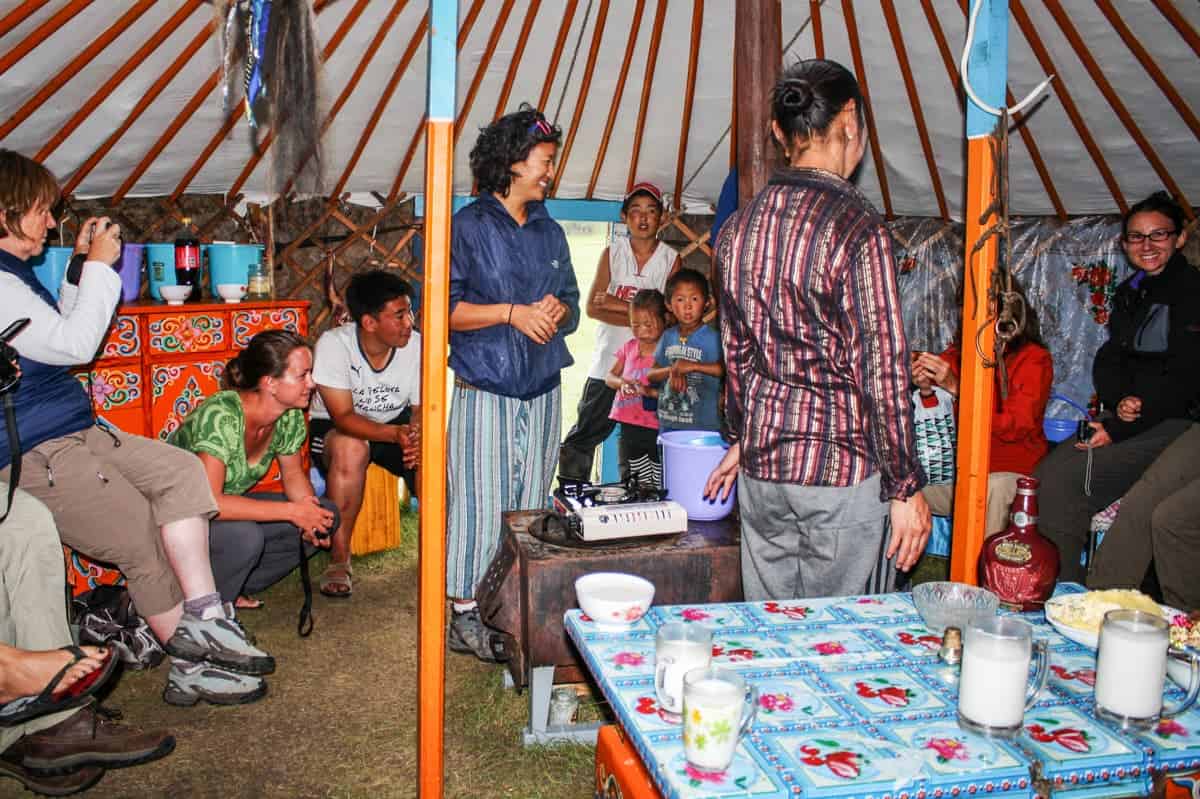
Visiting a local nomadic family in their ger in Mongolia
As we had two Mongolian guides with us (invaluable support in a country where very little or no English is spoken or understood), we could visit a Mongolian ger and a local family to learn about nomadic life.
It wasn’t a tourist set up, but a traditional, local family who lived on an isolated patch of land in the valley. We tried their dairy products (their source of income), including fermented mare’s milk, curd and butter, before learning about ger rules and traditions and asking each other many questions!
READ MORE: Visiting a Mongolian Ger – Understanding the Nomadic Culture of Mongolia
We needed a quick stop in the nearby town of Tsetserleg to stock up on food supplies. It was a market day with an electric atmosphere. I get a high from moments when you don’t know where you are and what to do, and where you have to work hard to communicate and negotiate.
We later visited the most important Monastery in the country, Erdene Zuu Monastery in Kharkhorin – the first Buddhist monastery in Mongolia that had up to 100 temples and 1,000 monks before the purges in 1937. Only three temples remained, alongside several statues and other items.
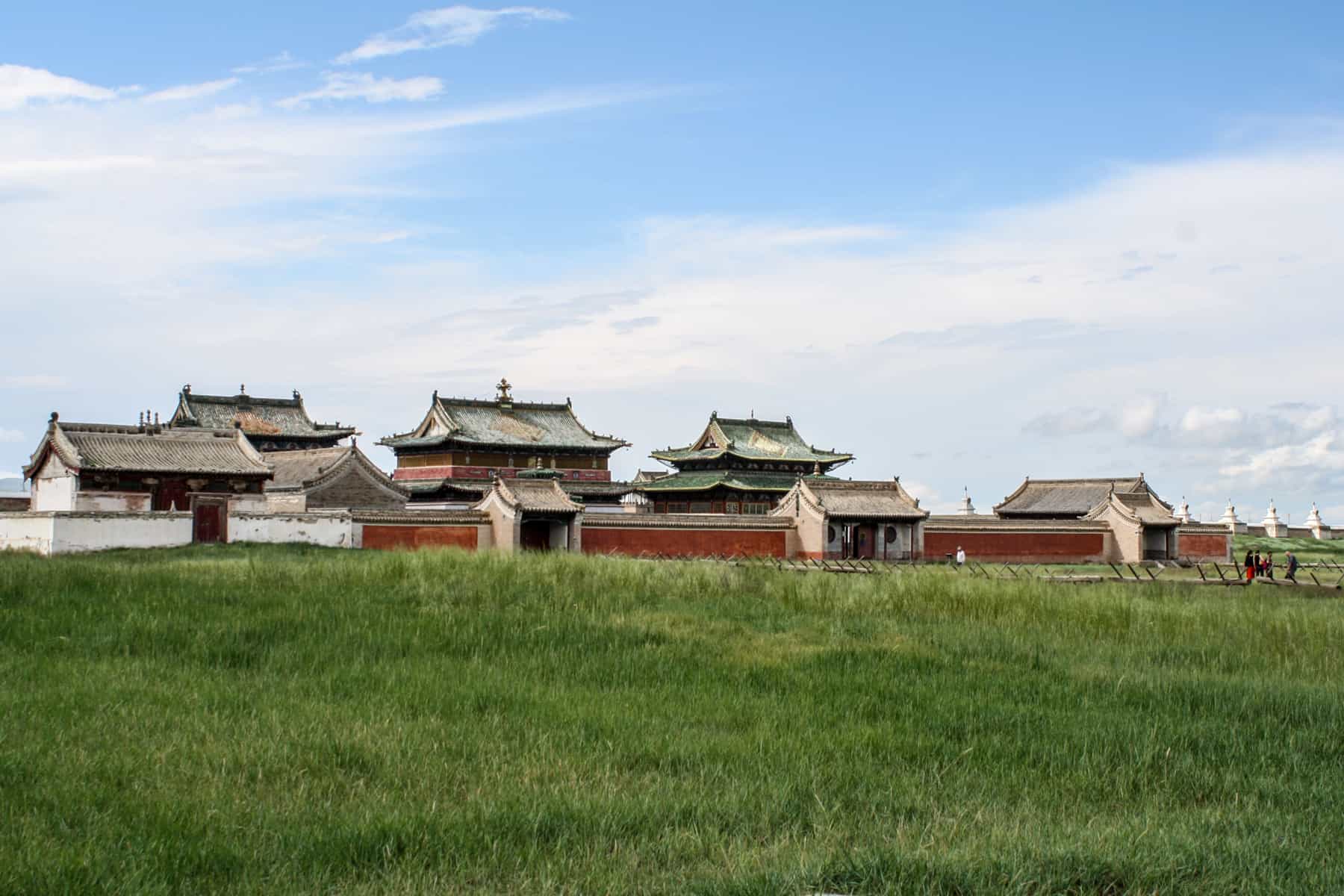
The exterior walls of the Erdene Zuu Monastery, Mongolia
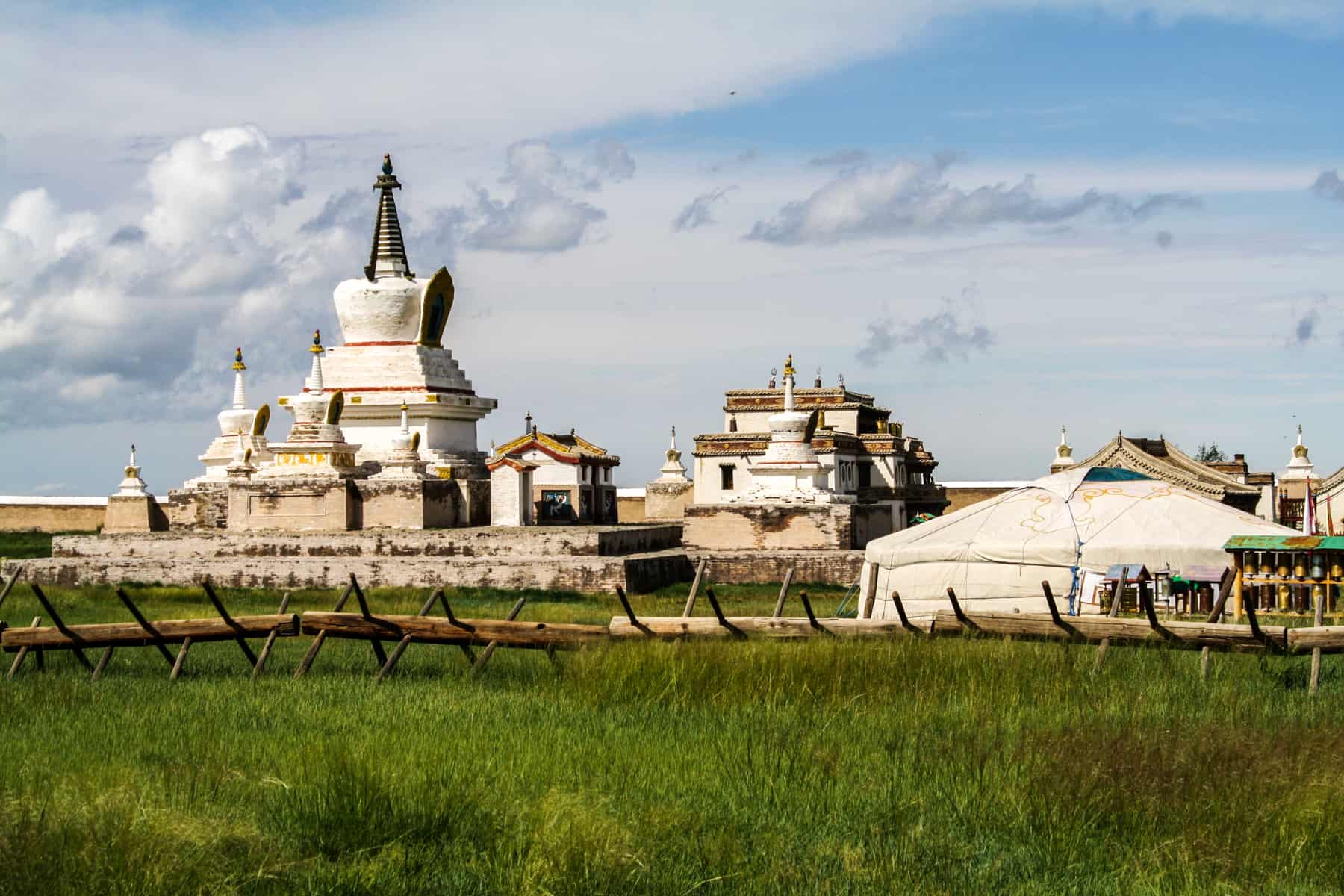
Part of the temple complex inside Mongolia’s Erdene Zuu Monastery
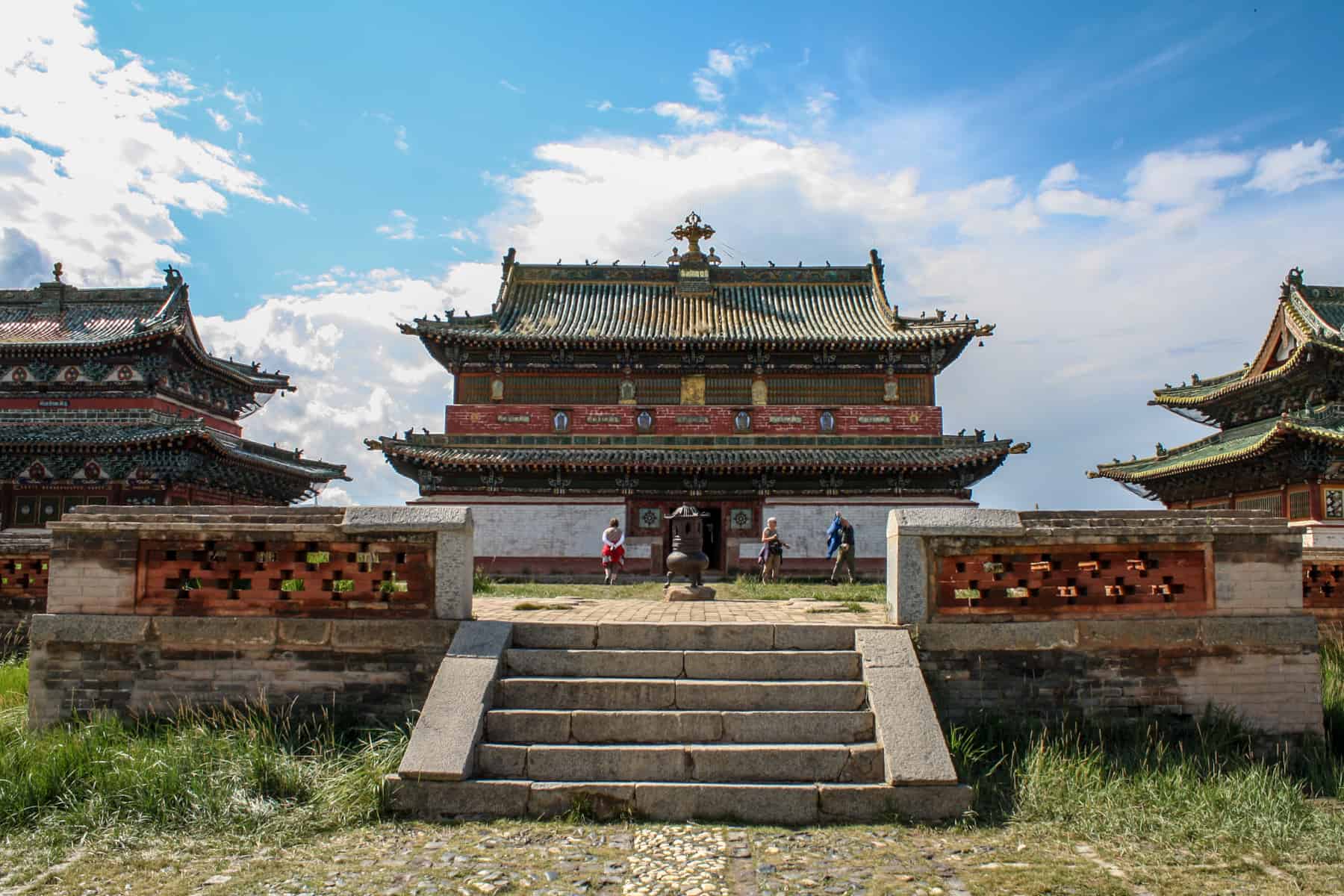
The red, gold and green temple structures at Erdene Zuu Monastery
A visit to the museum we camped next to – the Kultigen Monument, housing artefacts from the Turkish empire – set us on the way to the nearby Ugii Lake, where we would relax all day and camp for one night.
Ugii lake emits a calming atmosphere and invites you to traverse it slowly. While it would take almost a day to walk around, it’s a great place to unwind and reflect. I count this as one of my most favourite spots in all of Mongolia.
Our camping set-up beside Ugii Lake in Mongolia
We arrived at Hustain National Park in the afternoon to settle into a ger camp. This National Park is known for the rare Przewalski’s horse, unique to Mongolia. When you finally track down a small group, it’s still hard to see their beauty up close as you can’t get that close to them.
Still, we got to meet the ‘Best Mongolian Folk Band in Mongolia’ called Domog in the evening after a fantastic show where they performed rock-style tunes via the famed throat singing. I guess it is the equivalent of meeting Westlife in Ireland. Seriously.
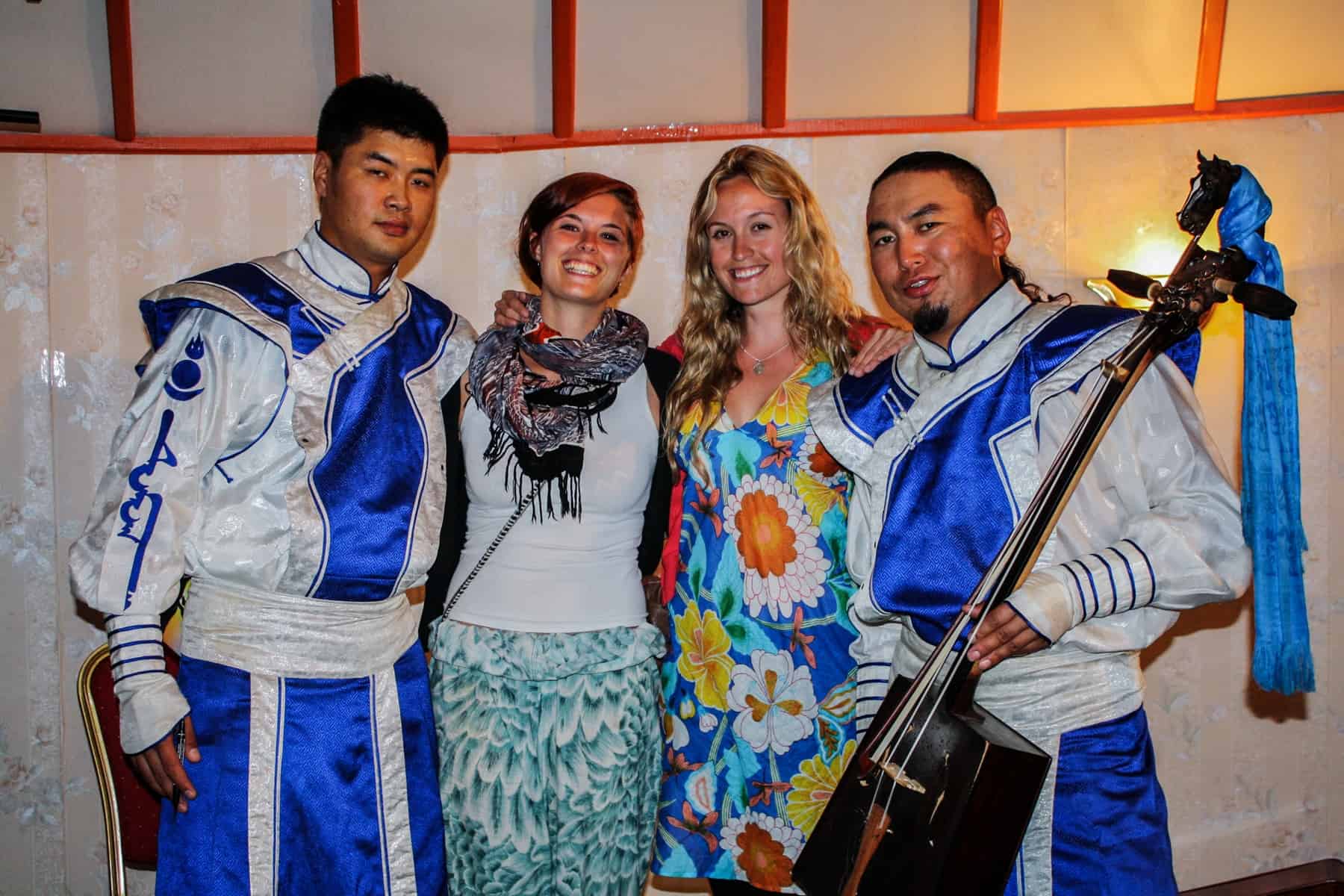
Meeting Damog, the Best Mongolian Folk Band in Mongolia
We had to journey back through the crazy, construction-overloaded, traffic-ridden Ulaanbaatar to get to Terelj National Park and the last ger camp of the trip (we were due to bush camp the weather put a stop to that).
It’s incredible how a few hours down the road from the capital brings you to some of the country’s most spectacular landscapes.
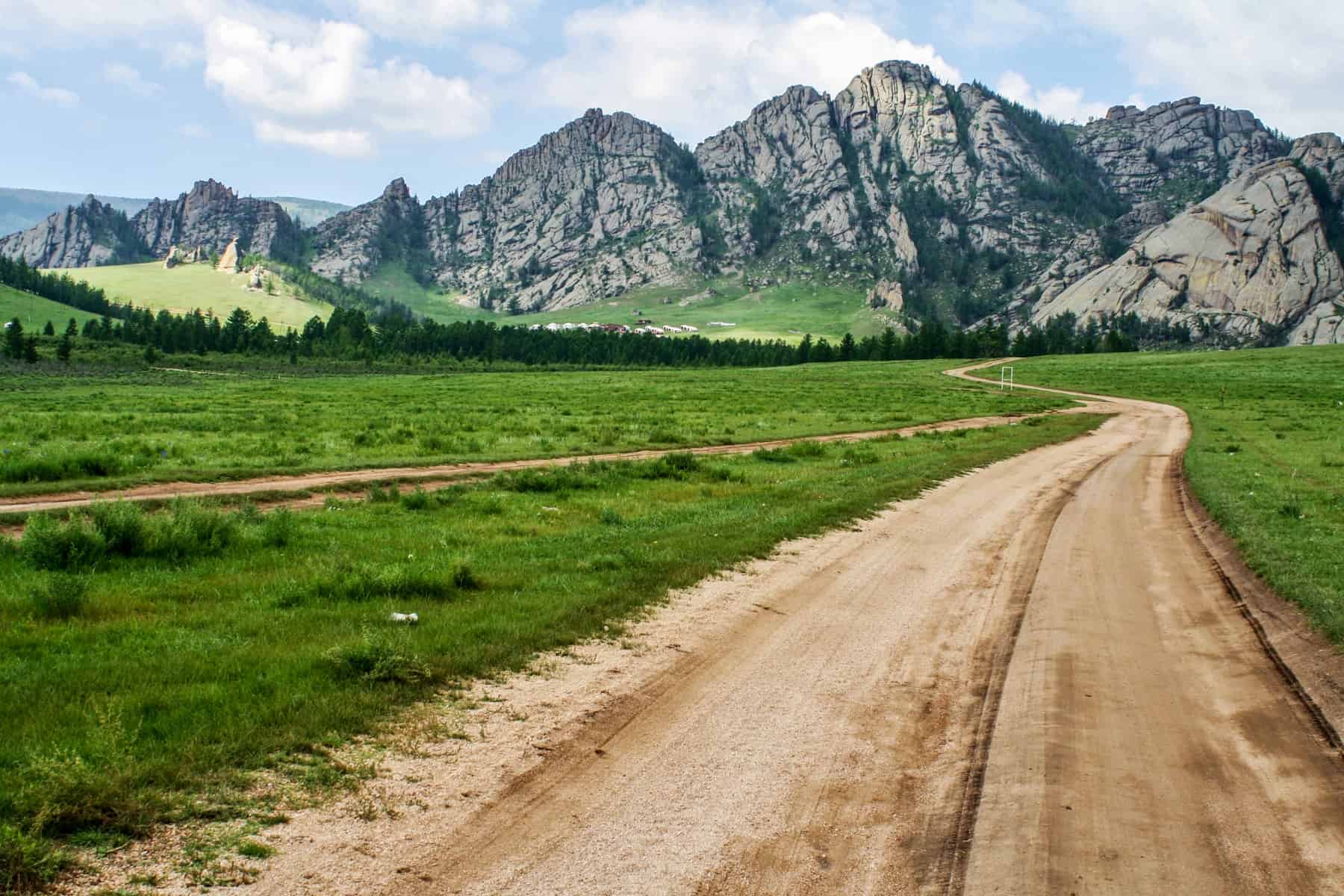
The road that leads to the heart of Terelj National Park, Mongolia
If you love walking and hiking, you will love Terelj National Park. Here you can wander for hours, hike to a Monastery and horse ride through the forests and rocky hilltops. Make sure you check out ‘Turtle Rock’ too. You may think it looks like something else from a certain angle!
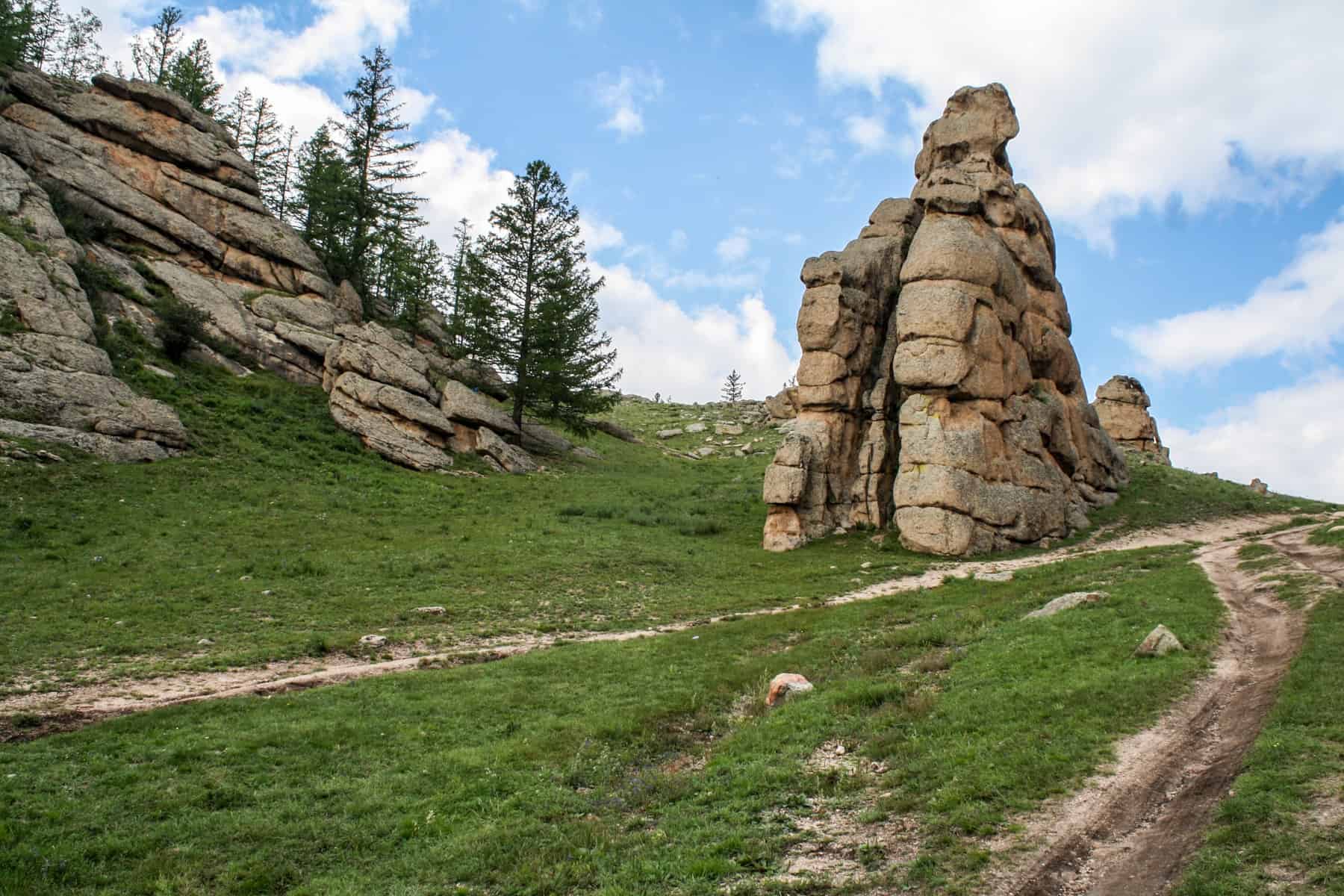
One of the layered rock formations in Terelj National Park in Mongolia
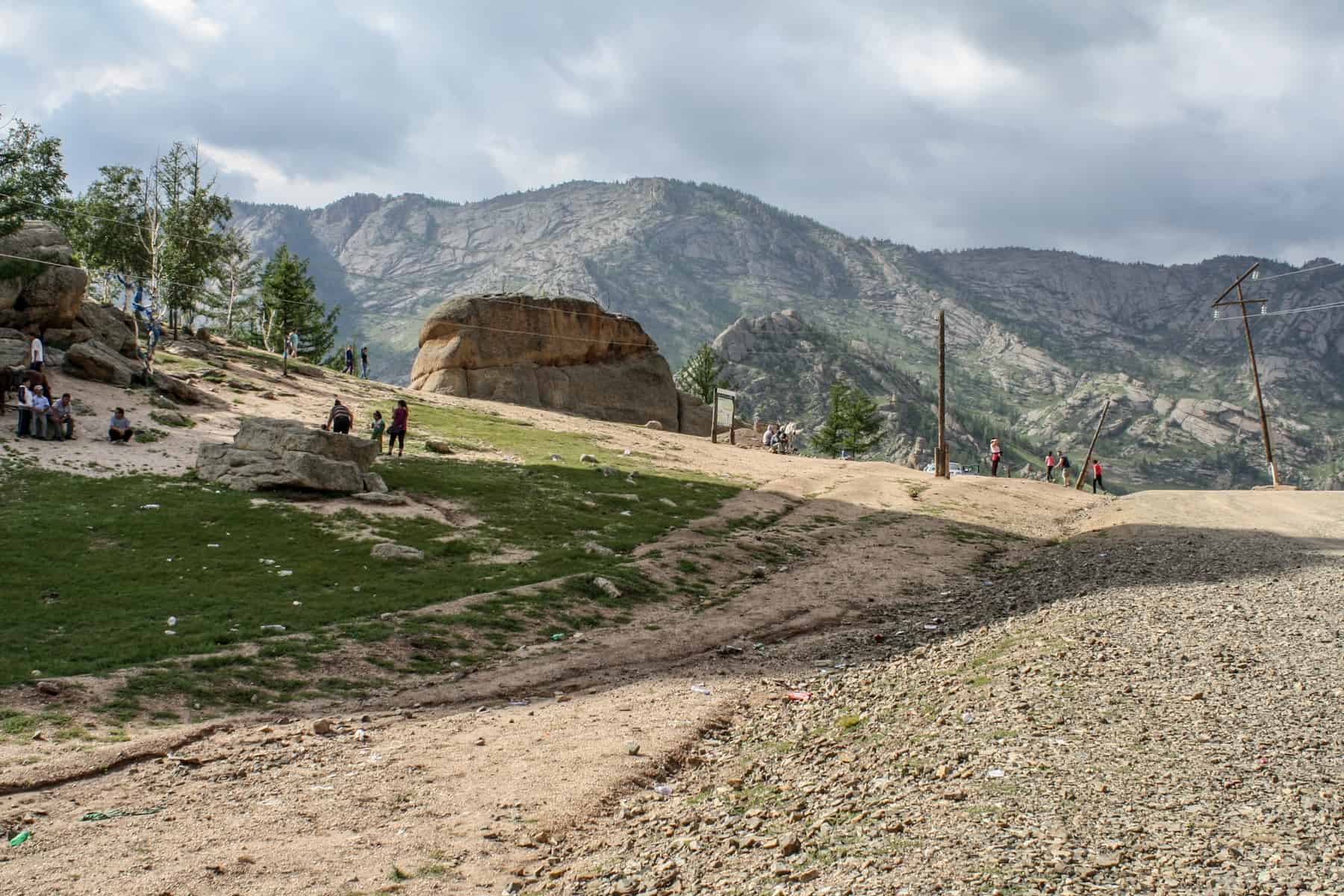
Visiting Turtle Rock in Terelj National Park Mongolia, named for its shape similar to the animal
Nothing beats the end of the wilderness journey than a visit to the giant 40-metre tall silver Ghengis Khan statue just outside of Ulaanbaatar on the banks of the Tuul River. Legend has it that it was at this spot that Ghengis Khan found his golden whip. Anyhow, a bit of a pilgrimage spot for locals, it was fascinating (if not a bit odd and imposing in the same way a colossal silver statue of Hitler in Germany would probably evoke the same feeling).
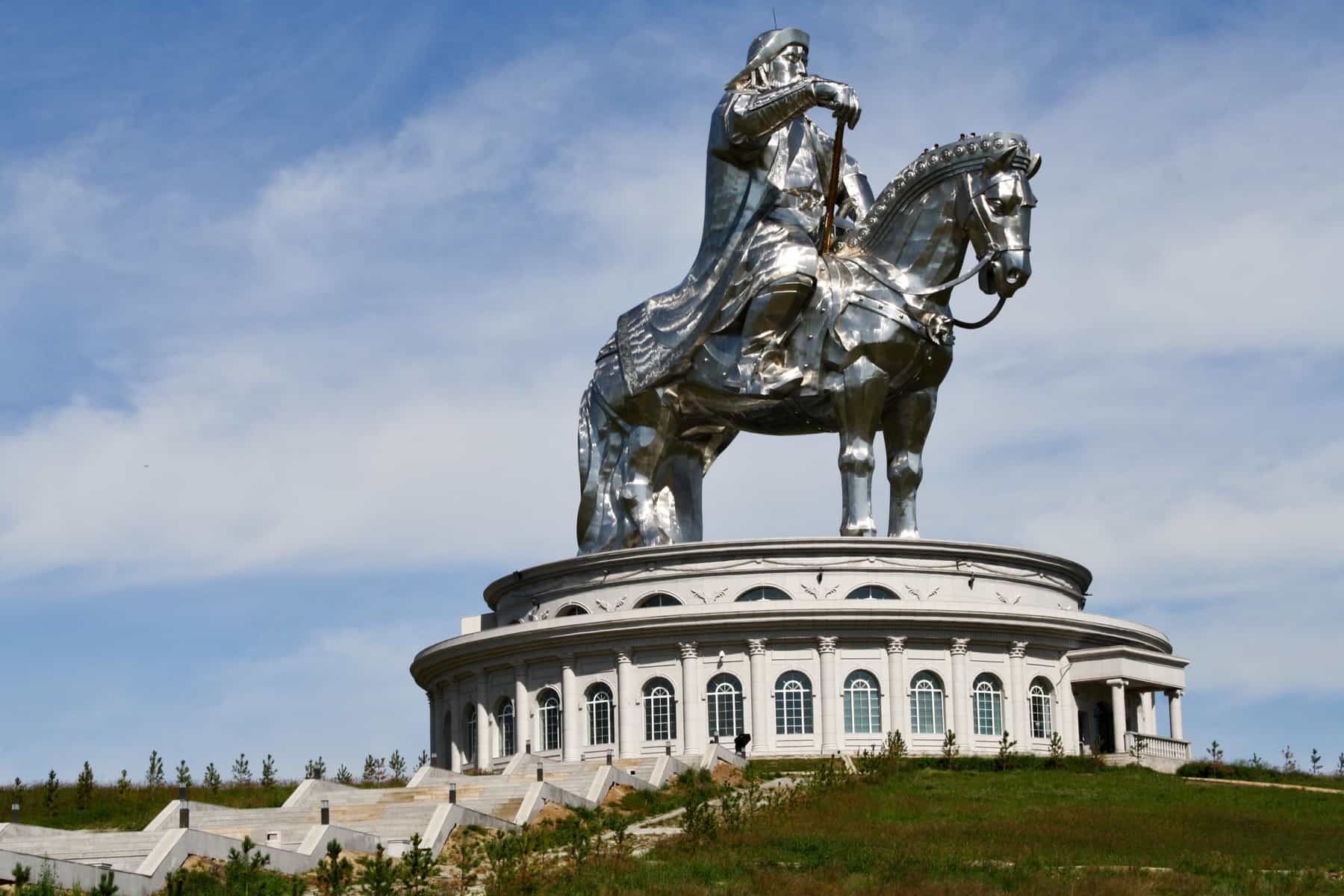
40-metre tall silver Ghengis Khan statue just outside of Ulaanbaatar, Mongolia
Back in Ulaanbaatar, I turned my hostel room into an office and distracted myself with a pizza slice, cake and coffee at Wendy’s Bakery – worth a visit alongside the State Department Store, which is right next to the hostel area. It’s an excellent chance to rest up after adventure through the vast landscapes of Mongolia.
The Dragoman overland truck is what we called home, except we didn’t sleep on it overnight. Instead, we went wild camping and every night, checking into a hotel once when the rains were too much to settle a tent comfortably.
The Outside
The truck’s exterior has lots of compartments – storage for luggage and tents and a clean water supply, mealtime equipment and food supplies. It’s a travelling transformer, and everyone has to lend a hand setting up and packing down for breakfast, lunch and dinner.
If you have no sense of camaraderie or hate getting dirty, then this isn’t the kind of adventure trip for you. I embraced it and loved every minute of ‘roughing it’.
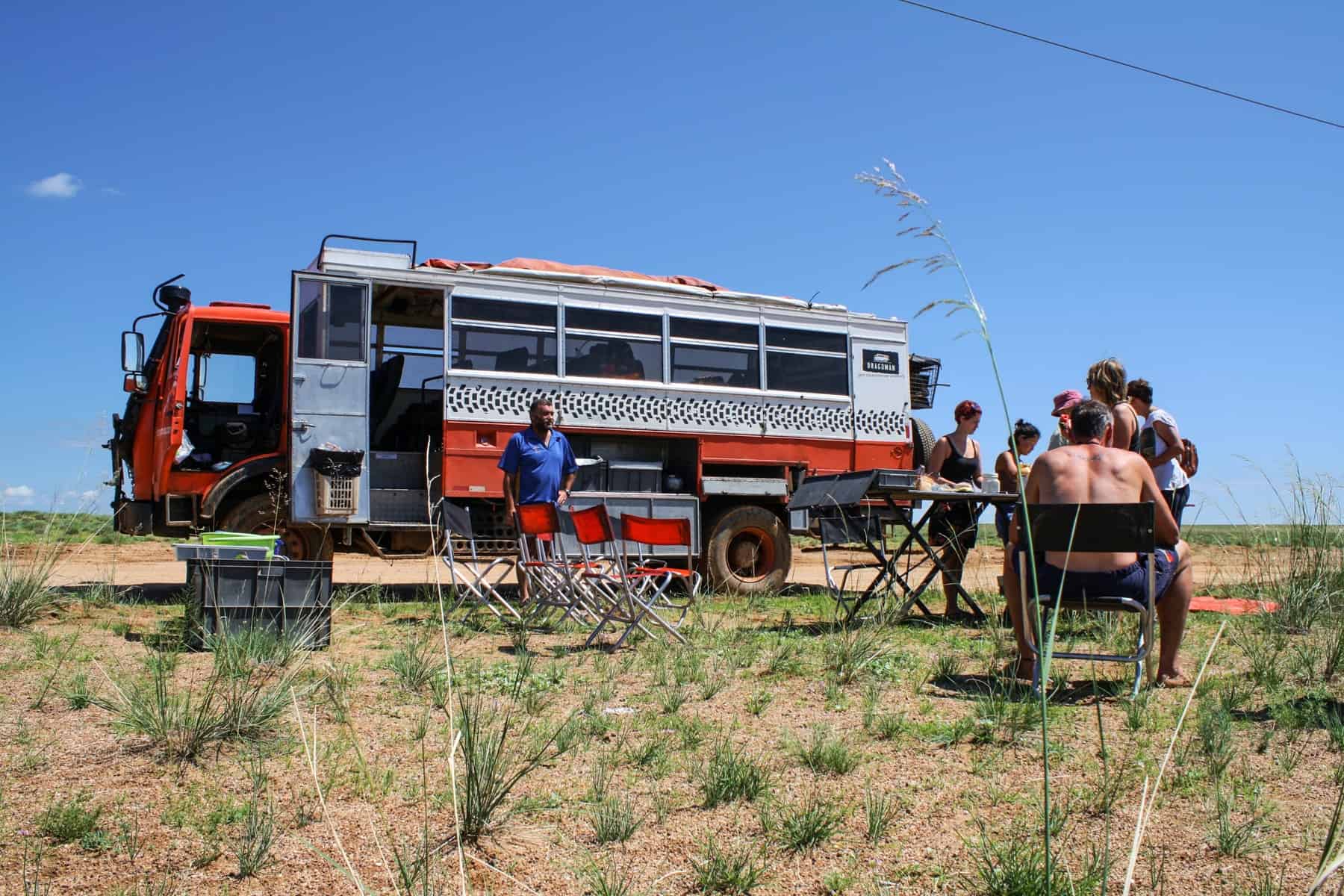
Travel in Mongolia was mostly about camping.
Twenty-three seats, a fridge, a safe, a bookshelf, prominent speakers and a place to recharge equipment, this is where we spend hours at a time, or what could end up being an entire day, traversing the landscape. We filled it with our belongings like a messy bedroom and made it cosy.
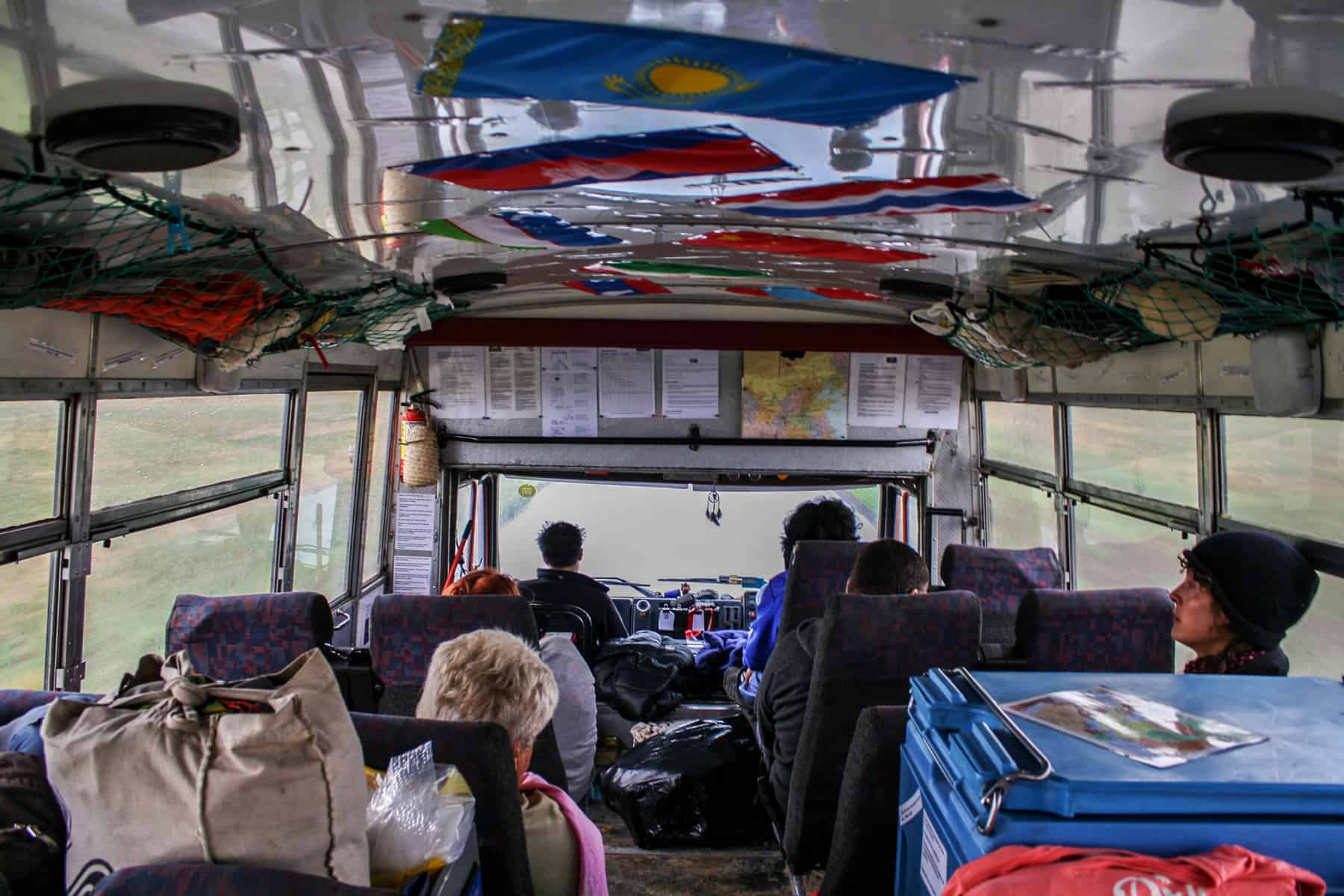
Inside the Overlanding truck on the journey travelling Mongolia
Along the Way
The two drivers are the mechanics, the navigators and the troubleshooters. Everything about the truck, from where it goes and how it gets there, hangs on their decision making, alongside our Mongolian guide who knew the land better than anyone else and could speak the language when we needed to call upon locals for help.
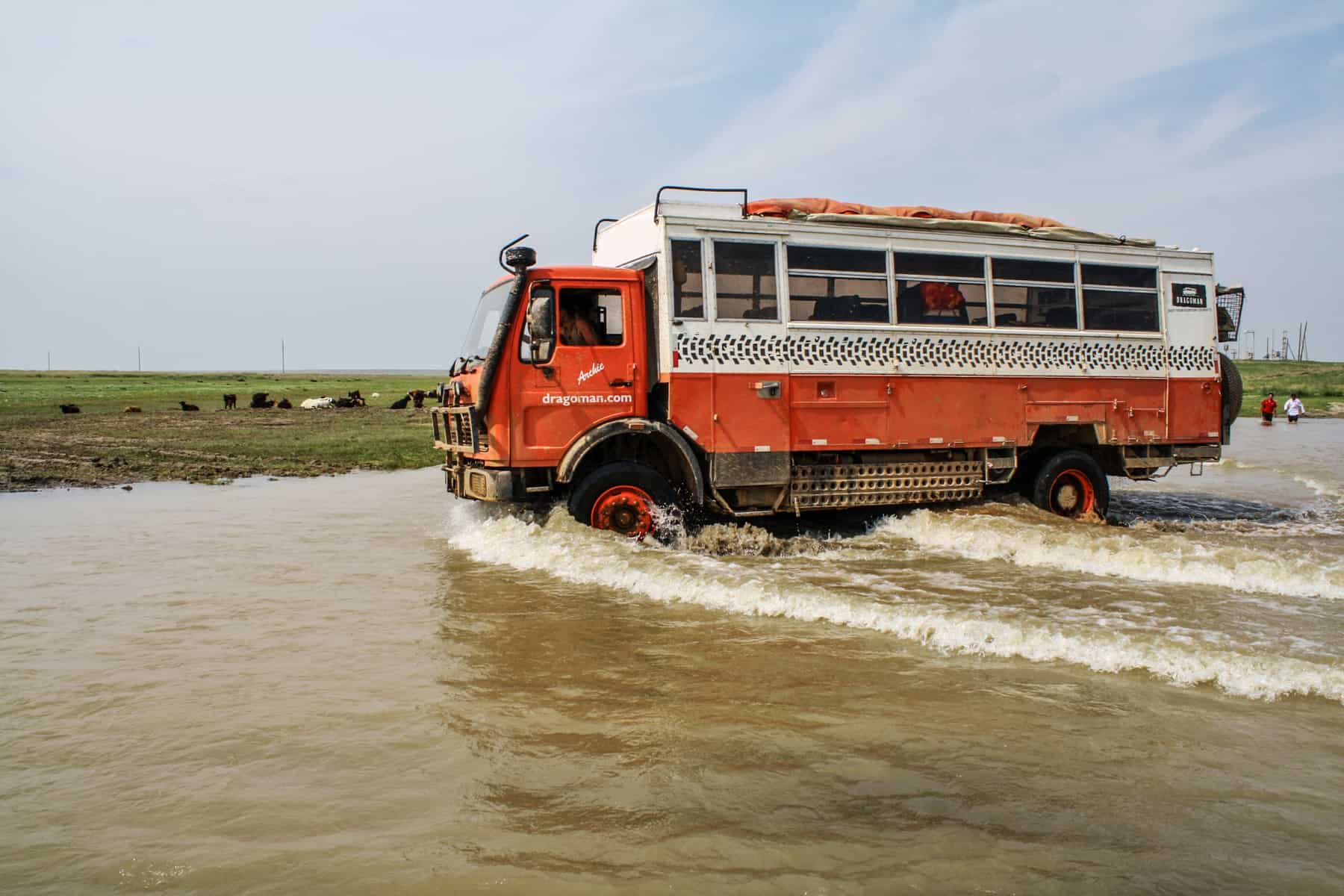
Overlanding in Mongolia was a real adventure.
Although the drivers would jump out to check the road, walking far ahead to determine the best track to take or check waterlogged areas (often by getting in the water) to limit the truck’s chances of getting bogged. We often stopped to help locals whose cars were stuck, knowing that karma would need to be returned one day.
The Realities of Rural Travel in Mongolia
“Ok, guys, you have to get off. It’s not looking good.” This phrase, accompanied by the engine’s low hum and strain as it finally gave up, became a regular occurrence during the three weeks I spent in Mongolia. Getting dirty in Mongolia is a given, but I never thought on my travels that I would push a truck out of thick, stodgy mud, build a road complete with a dam or wade knee-deep through a river to get to the other side.
In Mongolia, aside from the small handful of roads available, you will take the path less travelled, one that hasn’t been used for days or worn in by other vehicles for an easy pass. You could call it bad luck, or you could call it a reality, but travel comes with its challenges and getting stuck in Mongolia is by far the most common. While I wasn’t expecting substantial bogging incidents on this trip, I began to embrace them when they did happen. After all, the locals have to face these situations regularly. It became a part of what Mongolia is and what it means to cross her lands.
The drivers of the truck were responsible for assessing each situation when it arose. They were the first to get dirty, walk through the water and determine the outcome. At times it put you on edge, wondering how long you would be stuck somewhere with no one passing by for hours. At other times it merely meant us having to walk a short distance to lighten the truck.
Either way, the result was a massive whoop and roar for our truck, Archie, when he made it through. It felt good, and we then knew the next stage of the journey could begin. These are the times I’ll always remember.
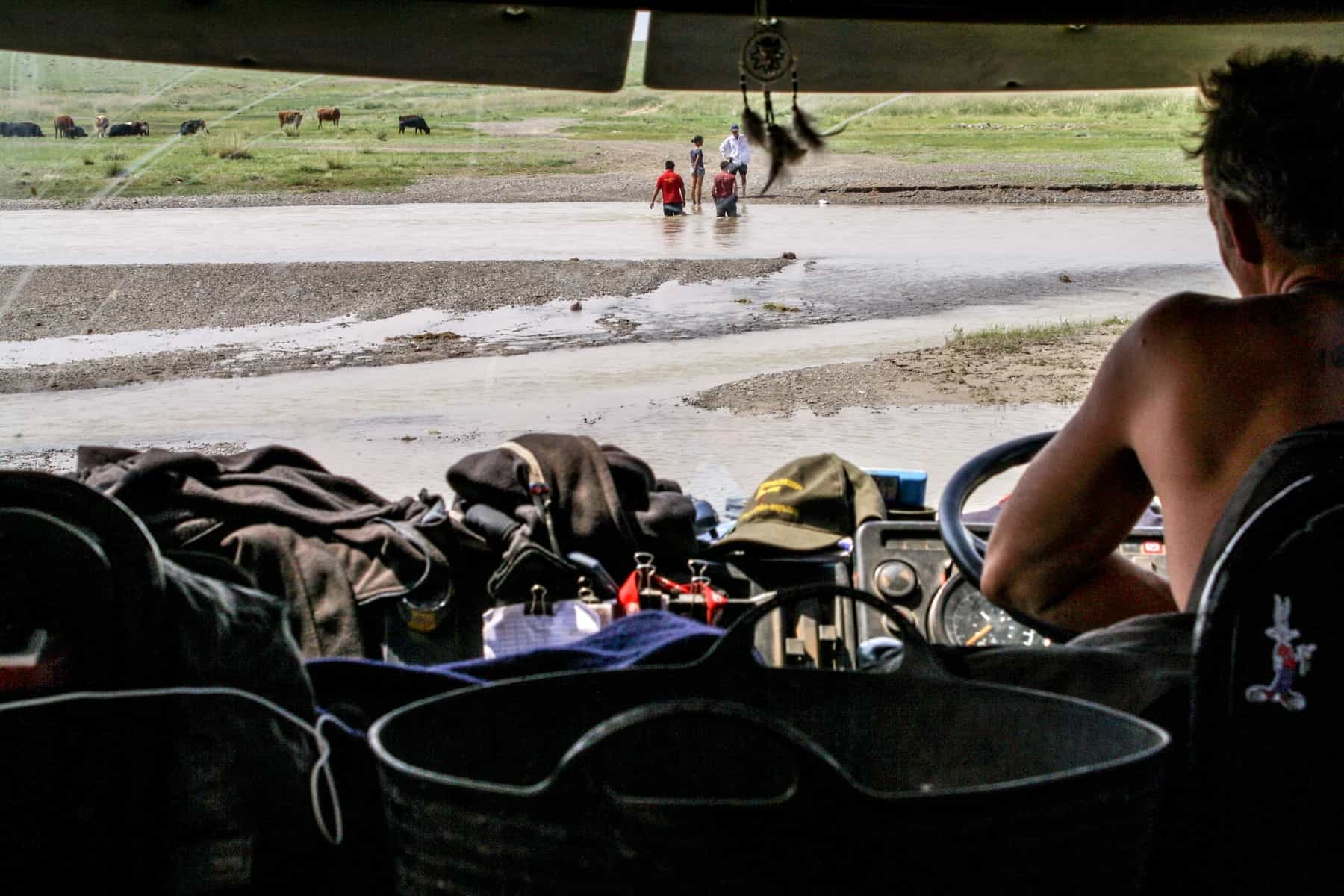
Our group helps find a track in the water for the truck to pass in Mongolia.
It had been raining on and off for a few days, mainly in short spurts in the evenings, and we were bumping along the wet dirt tracks just fine. When the truck stopped, and we saw that two pools of water had filled two road tracks, we knew a bogging incident was imminent. The drivers walked, pondered and walked through the water. Could we drive through it without getting stuck?
The usual scenario rested on two possibilities – drive through it or find hard enough ground around it. Except that this time it was different. We were told: “We need to empty this road of water and then let the ground dry out so we can cross over it.”
Cue the mad dash to empty our camping gear to find our plastic washing-up bowls and any other form of a plastic container to begin the removal process. The ladies rolled up their shorts to get right in there and scoop out the water as the men started digging to create a road. Everyone built a dam by hand on each side of the tyre track grooves so that the emptied water wouldn’t flow back in.
It was hard work, but we became a team, a great team. The sun was shining that day which meant we only had to wait a couple of hours while the heat dried out our creation. We ate, we played, we sang, and we marvelled at what resourceful people we were. It was a scary moment when Archie made his move to cross our road (our beautifully crafted highway that could be crushed in seconds and need rebuilding), but he made it in one unbeaten run, and our handmade route was left to the land and in nature’s control.
Happening upon grassy, muddy areas is sporadic. You can never tell exactly how hard the ground is beneath it. After bouts of rain, the ground softens, and even though there were times when the truck had to work a little harder, it made it through.
We had just had a fantastic afternoon checking out a local Nadaam festival and were in high spirits, which we needed knowing that we would be driving for the rest of the day. Except we didn’t – we were soon stuck in thick, sticky mud, and no amount of pushing and revving was going to change it.
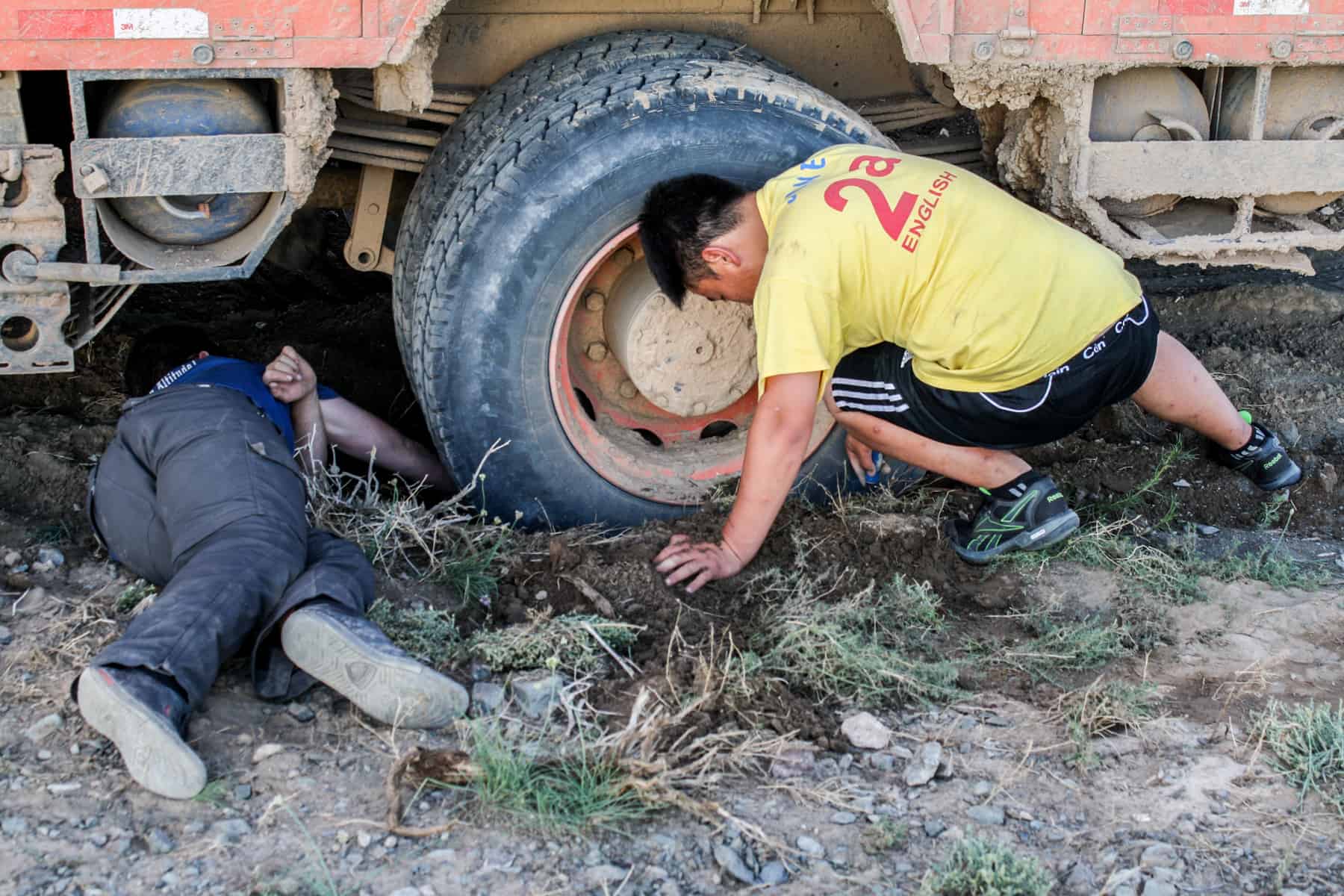
Digging out the truck wheels from the deep, wet mud in Mongolia
Our Mongolian guide walked to the nearest ger to get help, and the locals later returned on a motorbike to check out the situation. The whole family came out – we regularly became a source of fascination or amusement en route through the country. However, they kindly decided to use their big, industrial tractor to help pull the truck out of the mud – that too got stuck.
With two vehicles out of action and night starting to fall, we decided to set up camp on a drier patch of land nearby, and the drivers worked relentlessly with the locals throughout the evening. We got bogged at 5 pm, and it took until midnight for the truck to be pulled from sludge. It was a day wasted, but another example of how unpredictable travelling here can be.
When the truck stops dead at a deep area of water, you know the situation isn’t going to be resolved quickly. Can a truck this size pass through a river without sinking or getting stuck? Although we enjoyed paddling in the freshwater, we didn’t know whether we could have to completely re-route to get around it and lose more time.
The conclusion was that there was a distinct lack of knowledge about alternative roads around the river, and somehow we would have to find a way to get through it. With a small truck already stuck right in the middle, it was a scary prospect.
The drivers identified the most shallow and hard ground area in the water to pass, although we couldn’t be on the truck, unfortunately. You can imagine the chaos – a group of locals trying to rescue their vehicle and 20 non-locals trying to navigate through the water, knee-deep and screeching, scared of falling in.
My heart skipped a beat watching our truck splash through the water and wondering whether it would stop dead in its tracks and slowly swim in a sea of mud, taking all our belongings with it. But Archie made it, and this time, he got the biggest cheer. And a giant sigh of relief.
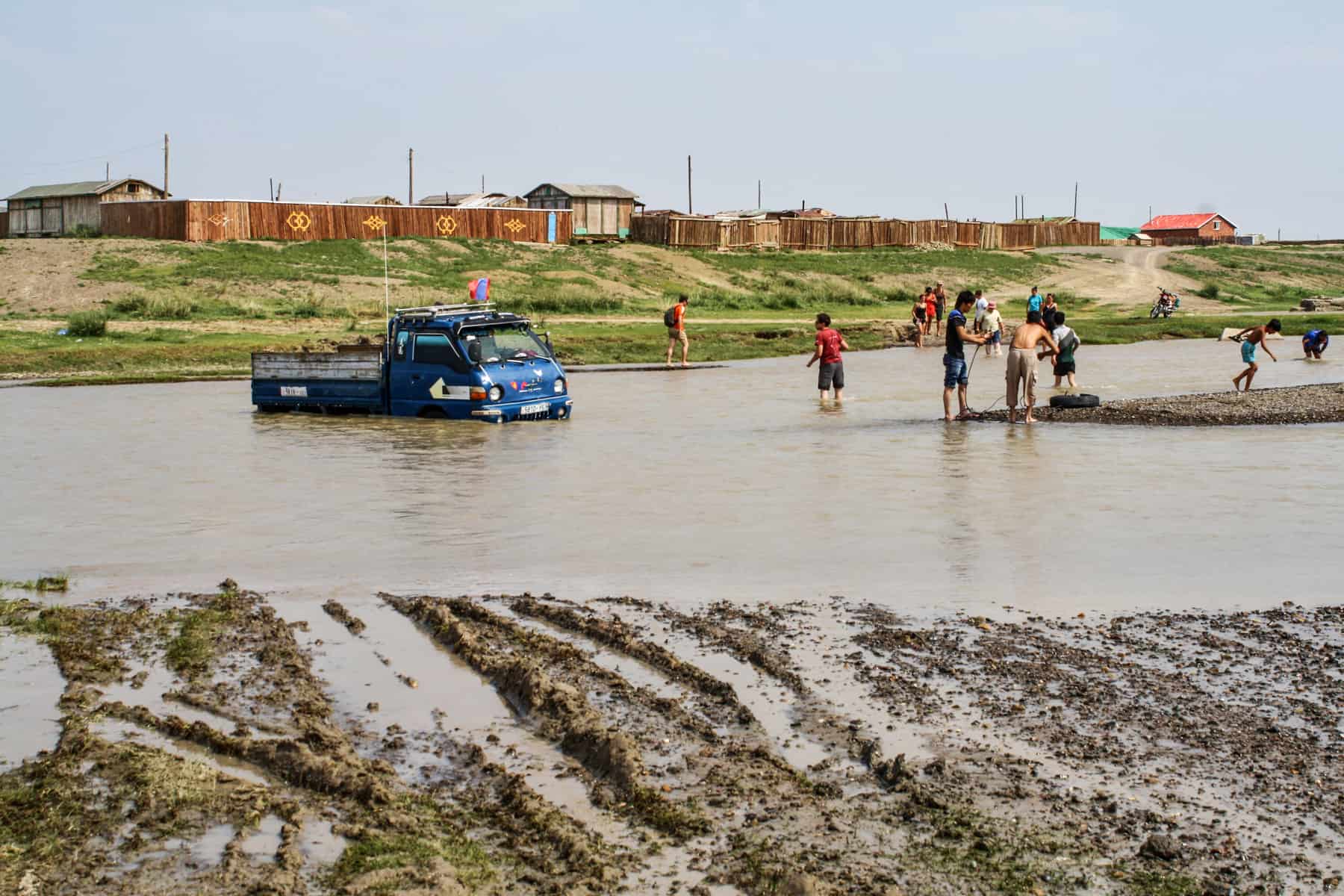
Typical river crossings in Mongolia and helping out locals who were also stuck
With unpredictable weather conditions, a challenging landscape to navigate and a trip mostly comprised of wild camping, packing for Mongolia requires some planning. In short, you need to factor in the following:
- Items of clothing that you don’t mind getting dirty and wholly ruined.
- Clothing layers for the constant switch of hot and cold climates – thermals to moisture-wicking and waterproof items.
- Sun protection and bug spray for mosquitos and sandflies.
- All medications you need as you’ll often be far from any significant stores or aid.
- Snacks from home as the food variation can get very repetitive.
For a more extensive overview, read my full Mongolia Packing List .
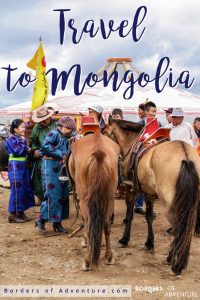
About Becki
Becki Enright is a British Travel Press Award-winning writer whose work focuses on changing perceptions about misunderstood aspects of destinations. Her writing combines storytelling with insight into the social, historical, political and economic factors that shape the country or place in relation to tourism. Becki has appeared live on Sky News and CNN and has contributed to high profile media including National Geographic, Time.com, Guardian online, New York Times, Grazia and Buzzfeed.
- Article Archives
- Work with me
- Privacy Policy


Mongolia Travel Guide
By Jessie Festa. This guide to Mongolia travel contains affiliate links to trusted partners.
Looking for an in-depth Mongolia travel guide ?
Then you’re in the right place!
This vast and enchanting country, nestled between Russia and China, offers a unique and unforgettable travel experience. With its rich history, stunning landscapes, nomadic traditions, and hospitable people, Mongolia beckons adventurous souls seeking an escape from the ordinary.
Geographically diverse, Mongolia boasts a landscape that ranges from sprawling grasslands and vast deserts to majestic mountains and crystal-clear lakes.
The Gobi Desert , a mesmerizing expanse of endless sand dunes and rugged cliffs, offers a surreal experience like no other.
On the hand, the Altai Mountains in western Mongolia captivate visitors with their snow-capped peaks, lush valleys, and abundant wildlife.
Then there is Lake Khuvsgul – aka the “Blue Pearl of Mongolia” – which draws travelers with its pristine waters and surrounding forests.
One of the most striking aspects of Mongolia is its nomadic heritage, a way of life that has endured for centuries. The nomadic people, known as herders, live in traditional felt-covered gers (similar to yurts) and graze their livestock on the vast grasslands.
Immersing yourself in this unique culture offers a chance to witness their timeless traditions, such as horseback riding, eagle hunting, and the art of making dairy products like airag (fermented mare’s milk) and aaruul (dried curd).
The capital city, Ulaanbaatar , serves as a gateway to the wonders of Mongolia. Bustling with energy, it blends modernity with a hint of the country’s ancient past. Explore the National Museum of Mongolia to delve into the rich history and culture of the region, or visit Gandan Monastery to witness the beauty of Buddhist architecture and observe the rituals of the monks.
Venturing beyond the city, you’ll discover a wealth of natural and historical treasures. The Orkhon Valley , a UNESCO World Heritage Site, is home to ancient ruins, including the legendary Karakorum , once the capital of the Mongol Empire.
For nature enthusiasts, Mongolia presents a playground of adventure. Embark on a multi-day trek through the Khentii Mountains , exploring hidden valleys and encountering rare wildlife such as the elusive snow leopard.
You can also hike to the top of the majestic Khorgo Volcano in the Terkhiin Tsagaan Nuur National Park for panoramic views of the surrounding landscapes, or indulge in a horse trek across the vast steppes, forging a deep connection with the land and its nomadic inhabitants.
Mongolia’s festivals provide a colorful window into its vibrant culture. The Naadam Festiva l, held annually in July, showcases the “Three Manly Games” of wrestling, horse racing, and archery. It is a celebration of athleticism, skill, and national pride that dates back centuries.
The Eagle Festival , held in the western part of the country, allows you to witness the ancient art of eagle hunting and experience the bond between hunters and their magnificent golden eagles.
Mongolia’s charm lies in its untouched landscapes, its rugged beauty, and the warmth of its people. Traveling through this land of open spaces and vast skies, you’ll be enchanted by the genuine hospitality and generosity of the Mongolian people, whose nomadic spirit is deeply rooted in their DNA.
Whether you seek adventure, cultural immersion, or a spiritual connection with nature, Mongolia has it all. So pack your bags, embrace the unknown, and let the Land of the Blue Sky captivate your heart and soul. Get ready for an unforgettable journey through a land where time seems to stand still and the spirit of the nomad roams freely!
Keep reading to dive into resources that will help you with planning a trip to Mongolia in Asia .
Note: This guide to Mongolia travel contains affiliate links to trusted partners!

Mongolia Map
Use this Mongolia travel map to begin planning your trip!
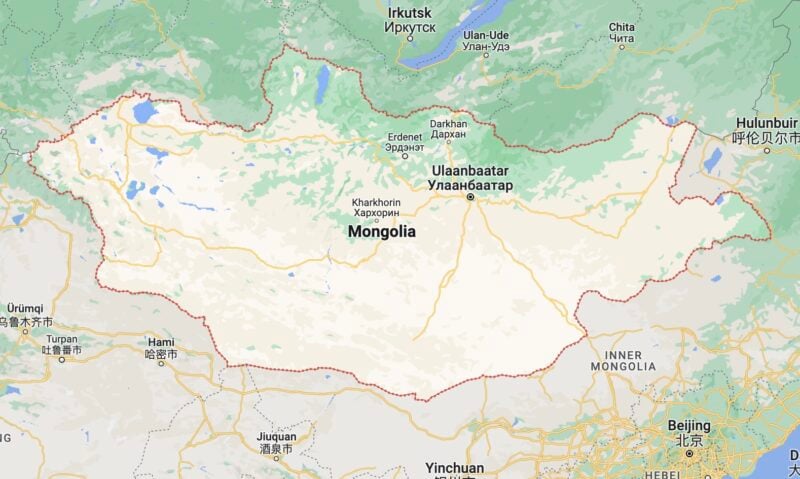
Click here for an interactive version of the above map.
Mongolia Travel Tips
Get advice on planning the perfect trip to Mongolia.
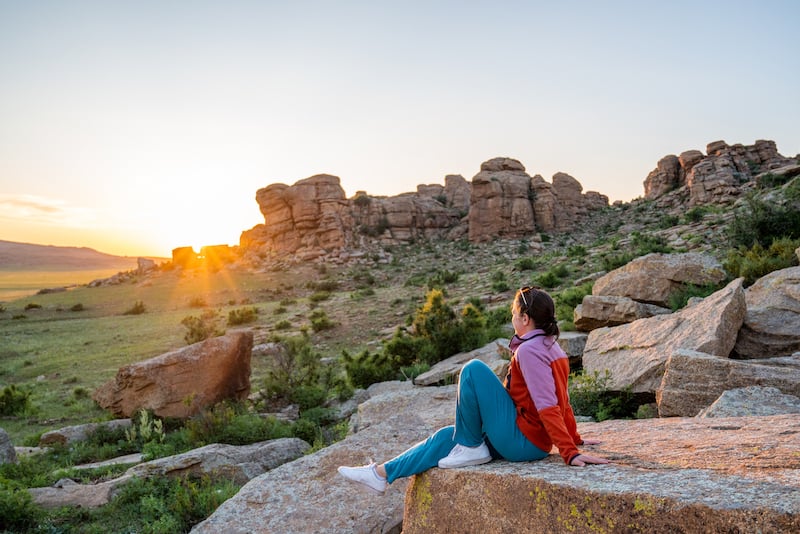
18 Best Places To Visit In Mongolia
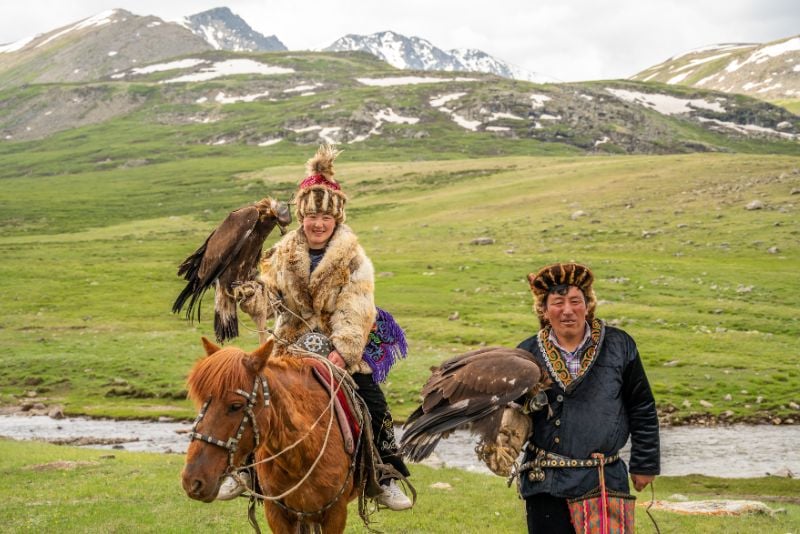
Altai Mountains Mongolia: How To Have An Unforgettable Trip
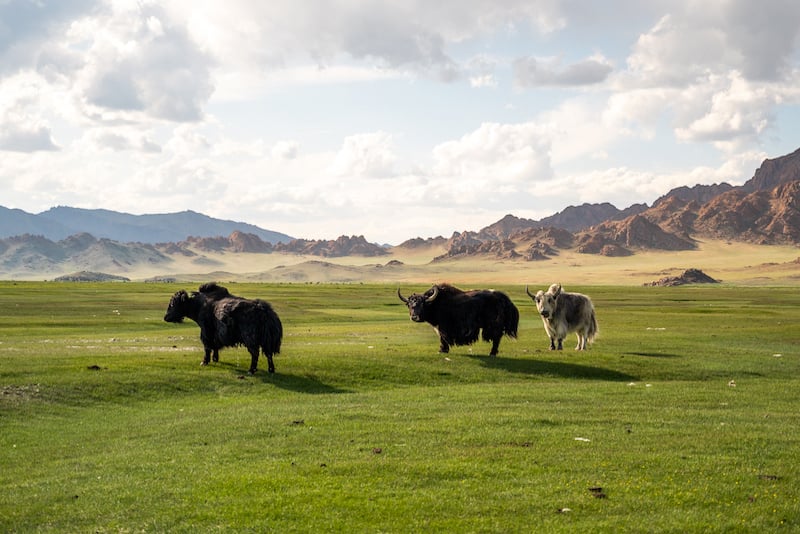
The Perfect 2 Week Mongolia Itinerary
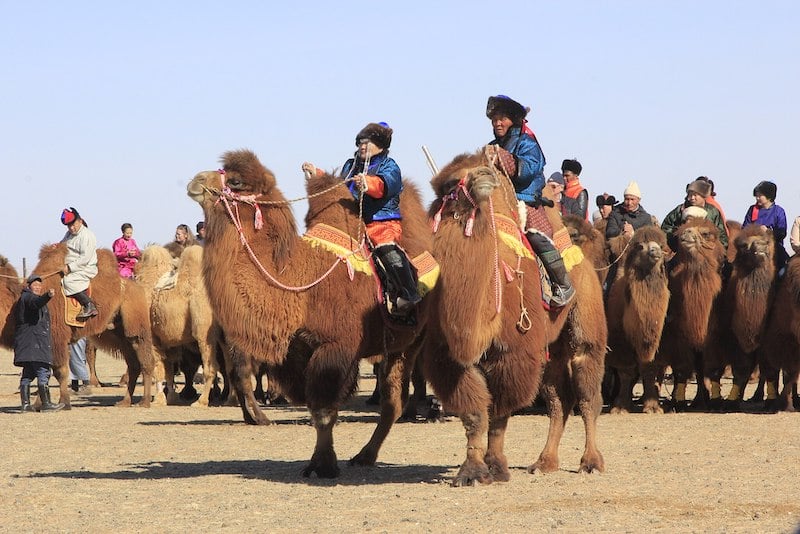
10 Festivals In Mongolia Worth The Trip
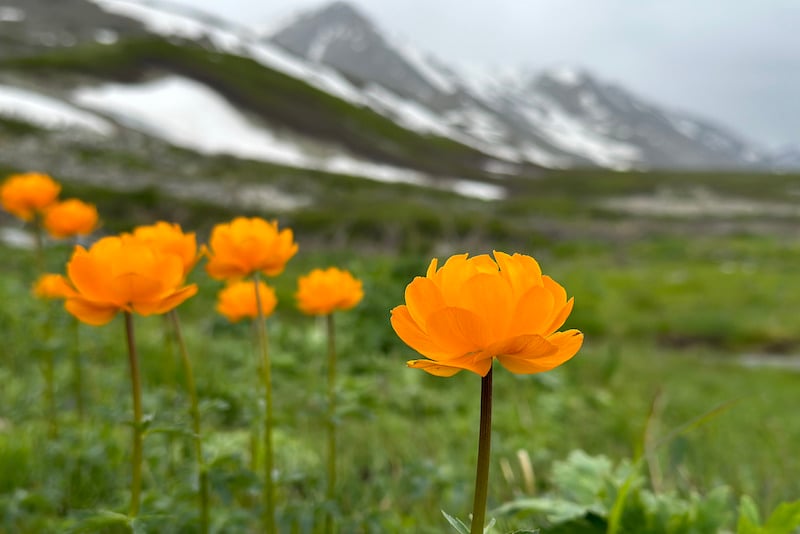
Best Time To Visit Mongolia
Asia Travel Tips
This Asia travel advice can help you plan the perfect trip.

24 Best Places For Solo Travel In Asia
Top Mongolia Tours
Book a Mongolia tour and get to know the culture through a local. A few top-rated Mongolia tours, each departing from Ulaanbaatar, include:
- Genghis Khan Statue with Terelj National Park & Aryabal Temple
- Cooking Class in a Traditional Ger Home in Ulaanbaatar Suburbs
- 4-Day Essencence on Mongolia Tour
- Full-Day Tour of Ulaanbaatar with Museum & Black Market
- Bogd Khan National Park Hiking Day Trip
Click here for a full list of Mongolia tours .
Mongolia Hotels
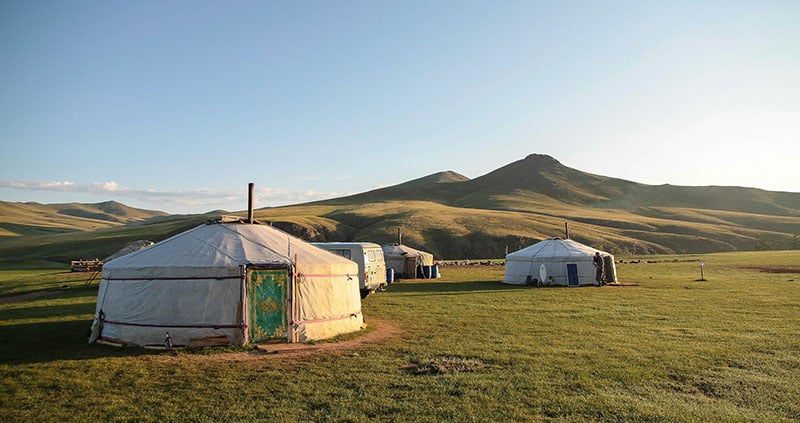
Click here to browse hotels in Mongolia!
Prefer self-contained stays?
Click here to check out unique local rentals!
You can also use this map to search for local stays. It’s currently set to Ulaanbaatar, but you can easily change it to your preferred Mongolian destination:
Mongolia Travel Insurance
It doesn’t matter if you’re traveling solo or with a group on a Mongolia tour. When visiting Mongolia — or any other country in the world — make sure to get travel insurance to protect your health and safety.
In my opinion, the best travel medical insurance for travelers is SafetyWing as they’ve got a large network and offer both short-term and long-term coverage — including coverage if you’re traveling for months as well as limited coverage in your home country).
Additionally, SafetyWing is budget-friendly and offers $250,000 worth of coverage with just one low overall deductible of $250.
With coverage, you’ll have peace of mind as you embark on your Mongolia itinerary.
Click my referral link here to price out travel insurance for your trip in just a few clicks .
Mongolia Travel Guide FAQ
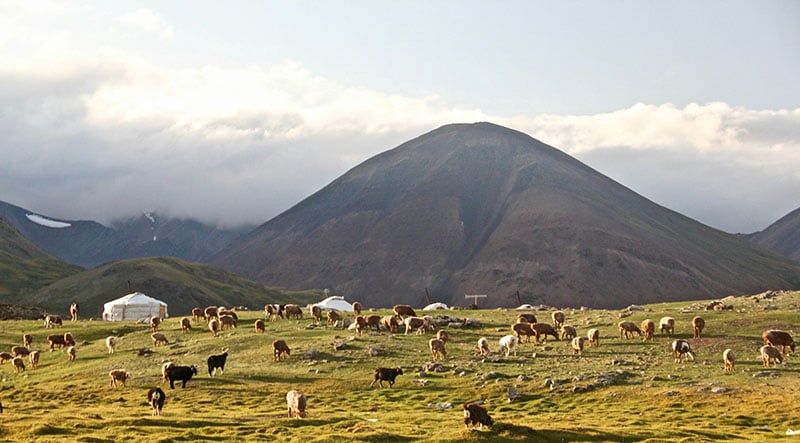
Below, find answers to frequently asked questions about traveling Mongolia .
Q) What is Mongolia best known for?
Mongolia is known for its diverse landscapes, nomadic culture, rich history – including Genghis Khan and the Mongol Empire – and world-renowned tourist attractions like the Gobi Desert.
Q) Is Mongolia safe?
According to Travel-Safe Abroad , the risk of being the victim of a violent crime in Mongolia is low. That being said, you should be careful of pickpockets and other scams in the capital city of Ulaanbaatar.
Q) Is Mongolia an expensive country?
While someone’s opinion on a country being cheap or expensive is relative, in general, Mongolia is considered a very budget-friendly country to travel through. Budget travelers can expect to spend around $30 to $50 per day, while mid-range travelers may spend approximately $70 to $100 per day.
Q) What is the best time to visit Mongolia?
While you can visit Mongolia any time of year, summer (mid-June to late August) is typically considered the best time to visit. This is when you’ll experience warm temperatures and pleasant weather and can attend the famous Naadam Festival in July.
Q: Do I need a visa to visit Mongolia?
It’s recommended to view your country’s Mongolia International Travel Information page for the most up-to-date information on entry and exit requirements. You can also contact the Embassy of Mongolia.
Q: How do you get to Mongolia?
International airlines fly into Buyant-Ukhaa International Airport in Ulaanbaatar, the capital city of Mongolia. From there, it is about an hour drive to the heart of the city, depending on traffic.
Q: Are credit cards accepted in Mongolia?
Credit and debit cards are often accepted in big cities, like Ulaanbaatar; however, you’ll definitely want to bring cash when visiting the countryside.
Q: What is the local currency in Mongolia?
The tugrik (MNT) is the national currency of Mongolia.

What would you add to this Mongolia travel guide?

IMAGES
VIDEO